Tuesday 1st July
Day 32
On site today were Bill, Chris, Andrew, Marlene, Susan and Jon with Ben Goodburn joining just before lunch.
Saturday 28th June
Day 31
Our friends from the BHAG were due on site today, but unfortunately car issues meant they had to turn back. That only left Chris and partner Denise – after lunch Roger arrived with his friend Keisha for a tour.
While waiting Chris decided to tackle the pit in Trench 3d which the BHAG would have been working on. The plan was to explore the base of the pit, instead of going around the edges to see if the pit had a flat floor similar to the rock cut ditch. 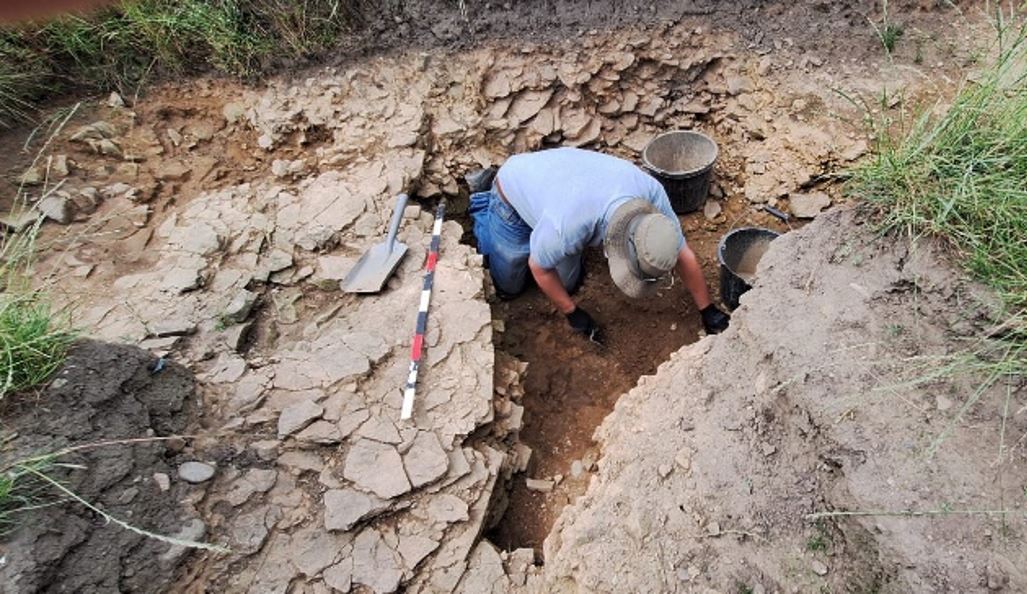 Luckily, after only trowelling down a couple of centimetres, a floor appeared. This alone is not enough to decide if the pit is natural or man made but gives us the chance now to follow the floor and collect more information about shape and size of the pit.
Luckily, after only trowelling down a couple of centimetres, a floor appeared. This alone is not enough to decide if the pit is natural or man made but gives us the chance now to follow the floor and collect more information about shape and size of the pit. 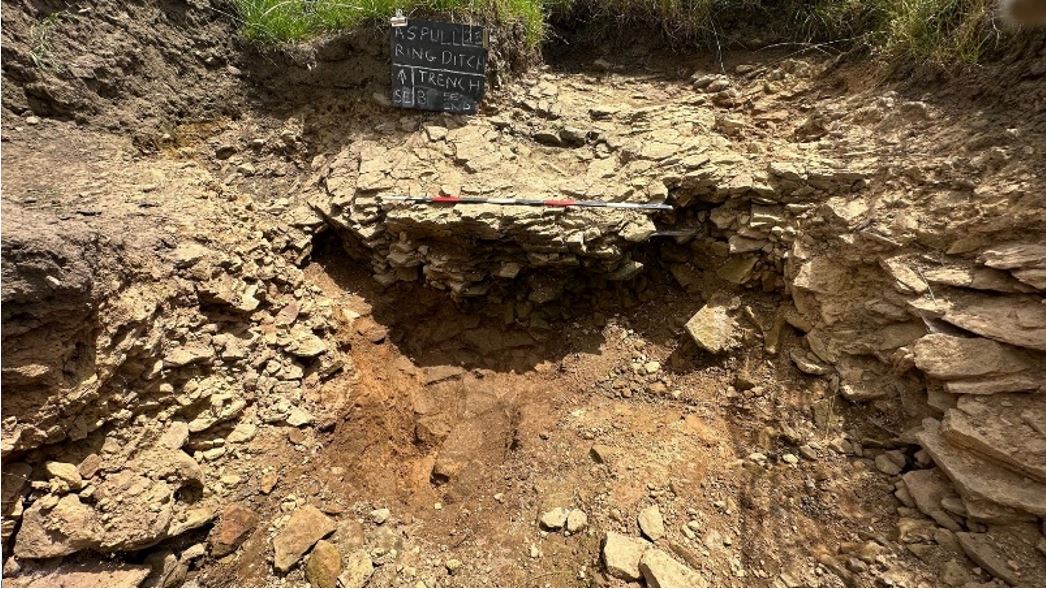
Denise meanwhile spent the morning finding the small boxes of bones that are around the central area marking the exact location where bones were found. She cleaned and remarked all of the boxes ready for recording with a drone shot.
Thursday 26th June
Day 30
Joining Bill and Chris today were Andrew, Patrick, Rachael, Susan and Colin. After lunch Stephen Cunliffe and his wife Laurie arrived for a visit and Bill gladly gave them the regular site tour.
Quite a blustery day today so it was decided not to work on the cremated bone deposits in F1 and F2. Instead Patrick took the opportunity to collect the material already retrieved (bags of fill and small boxes of bone) from F1. Chris meanwhile recorded the recently cleaned section through the stony ‘cairn’ in at the base of the ditch in Trench 5.
In an attempt to resolve the issue of the stony layer at the SE end of Trench 3a, it was decided to extend it by another half metre or so. Rachael and Andrew was tasked with this, while Susan was asked to extend the cut (Sondage 3a.S9) at the other end so that the change in surface colour, detected the day before, could be investigate in the section. 
Extending the trench did not reveal more of the stony layer on the surface, but extending the cut (Sondage 3a.S9) did show quite a depth of stones in the SW section. These where quite small and loosely embedded in the brownish layer lying on top of the orange soft sandy clay. Bill had been assuming this to be the subsoil which had been revealed on the other of this trench in 2023. 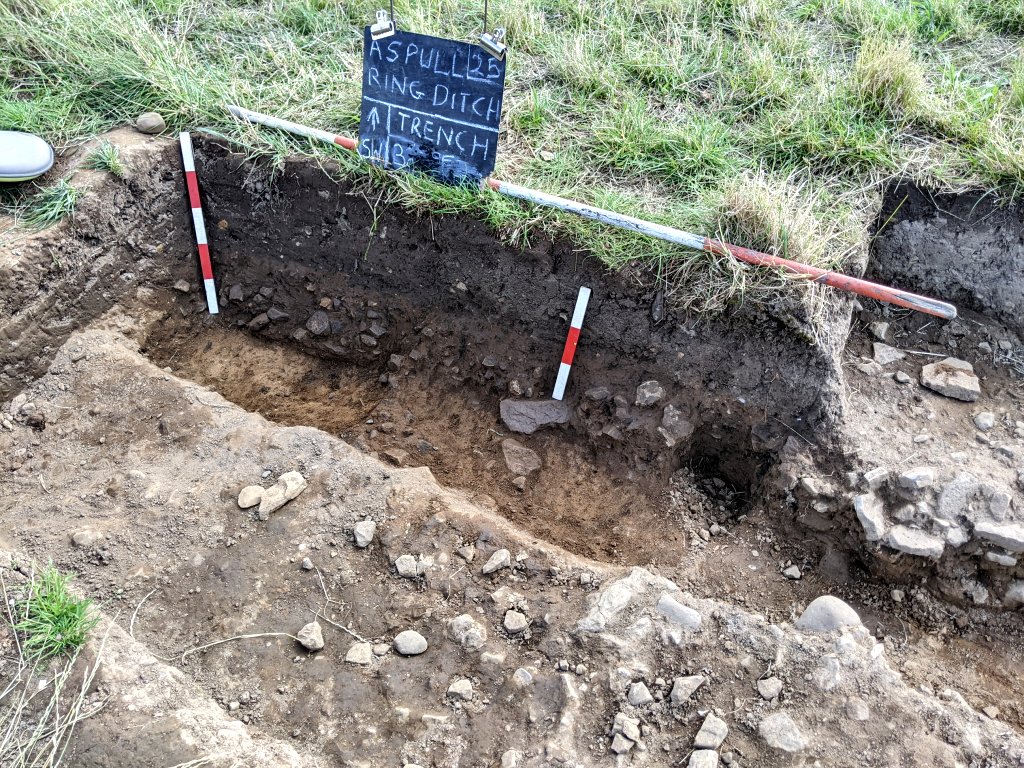
With Bill’s help, Susan was able to extend the other side of the cut by another half metre or so, cutting through the surface colour change. This revealed something very interesting – the reddish line was actually the burnt layer rising to the surface from the SE. We must therefore have trowelled through it when clean the surface of this trench. It was also fascinating to see that the mottled clay lying above it, was diving downwards towards the SE in light and dark bands. The stony layer beyond therefore must be lying above it. 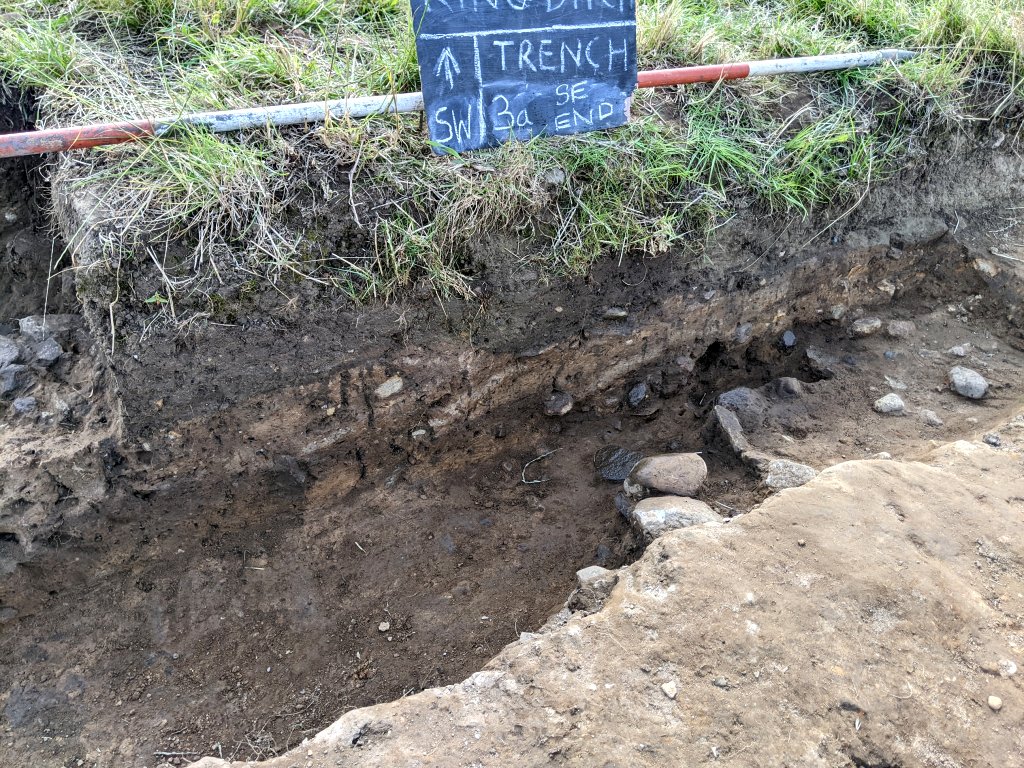 We now seemed to be getting a better understanding of what is going on here. In fact it now seems very much like the arrangement at the the other end of the monument in Trench1c (excavated in 2023) where the mottled clay layer was also diving under a stony layer at the NW end.
We now seemed to be getting a better understanding of what is going on here. In fact it now seems very much like the arrangement at the the other end of the monument in Trench1c (excavated in 2023) where the mottled clay layer was also diving under a stony layer at the NW end.
The stones in the stony layer at the SE end of Trench 3a appear to have a variety of colours but Bill was convinced many of the them were similar to the stones uncovered in Trench1c. Underneath their mottled patina he could detect a distinctive pale green tinge (or maybe blue) just like the ones he reported on in Trench 1c in 2023 (Day 41). To try to prove this he opened up a test pit in the area (about 4m from Peg 10a) next to Trench 1c and retrieved some of the stones from that layer. 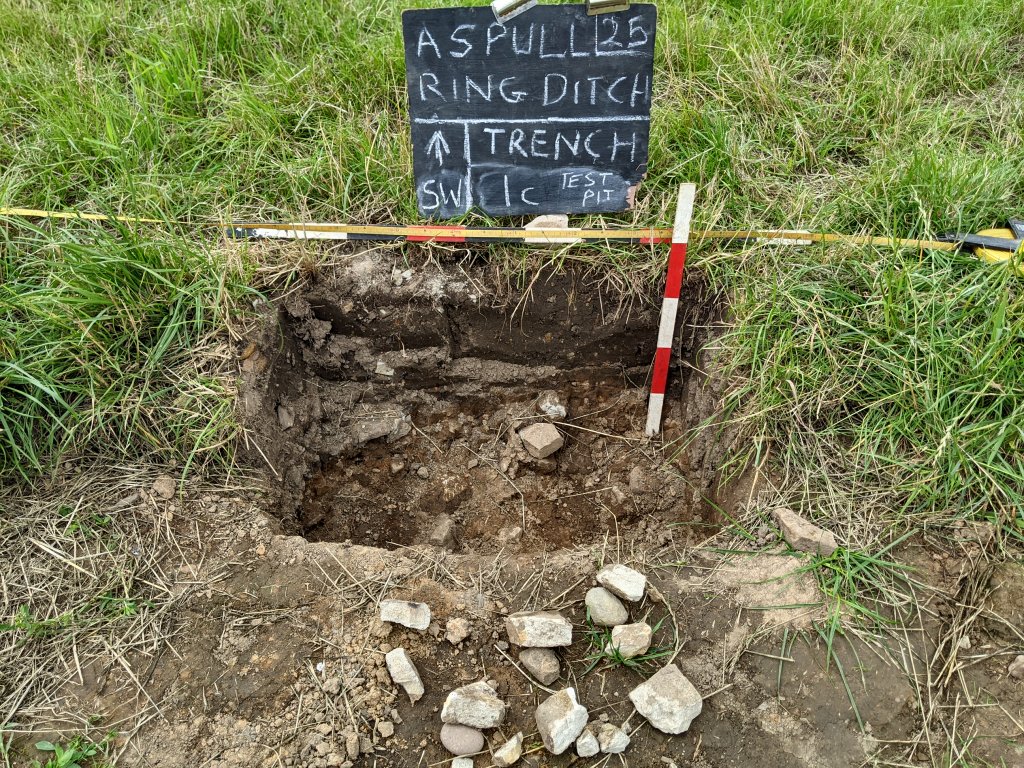 Comparing the stones from each they certainly seemed to be identical suggesting these layers were part of the same construction phase having been source from the same place. In fact we had detected similar stones last year (Day 36) in Trench 10 on the west side of the monument, lying similarly beyond the mottled clay layer – could it be that the mottled clay mound had been edged by a layering of small stones for some reason.
Comparing the stones from each they certainly seemed to be identical suggesting these layers were part of the same construction phase having been source from the same place. In fact we had detected similar stones last year (Day 36) in Trench 10 on the west side of the monument, lying similarly beyond the mottled clay layer – could it be that the mottled clay mound had been edged by a layering of small stones for some reason.
Meanwhile Colin was given the task of extending Trench1d to see if he could find the extent of the stony layer in that area. By the end of the day he was able to extend the trench to just short of 4m. He found that the stones continued all the way to the end of the trench. However the last metre or so, the stones seemed to be different in appearance i.e. much small and more loosely embedded in the soil, in fact similar to the stony layer discovered in the SE end of Trench 3a and also the NW end of Trench1c.  This seemed to be confirming the theory that there was a layering of small stones around the edge of the mottled clay mound and at this point the general stony layer.
This seemed to be confirming the theory that there was a layering of small stones around the edge of the mottled clay mound and at this point the general stony layer.
Wednesday 25th June
Day 29
No Chris today but joining Bill and Patrick were Peter, Marlene, Alison and Jen Harrison back from her hols.
Jen went straight into the trench she had been working at the start of the year i.e. Trench1b on the SW side. Bill asked if she could take down the baulk between Trench1b and Trench3a to see the relationship between the two adjacent pits. Jen had noticed when digging out the pit in 3a that the material in it was clean sandy clay, whereas the surrounding section was not clean i.e full of brown inclusions. This was also true of the intervening baulk. 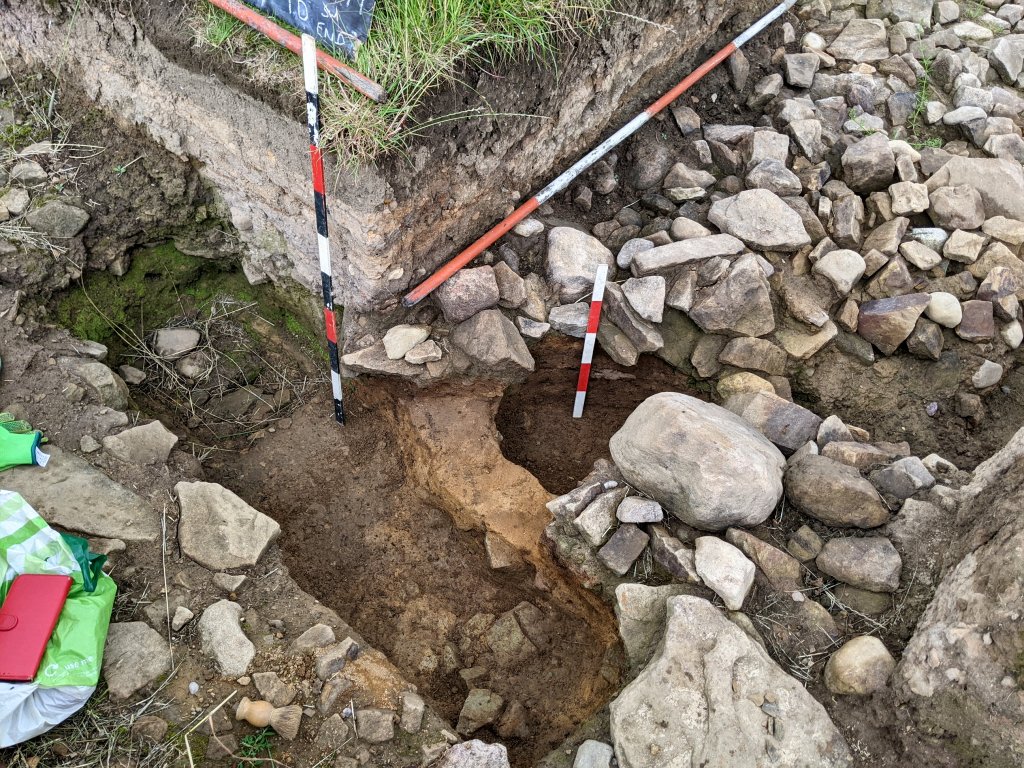 Bill was interested in this area as he was assuming the base of the pits represented the natural undisturbed ground surface. The localised undulations of these pits suggest some kind of activity on the site before the construction of the Bronze Age mound, perhaps during the Ring Ditch supposed Neolithic period (or even before). Completely removing the baulk showed the pit in Trench 3a to be deeper than the base of the pit in Trench 1b.
Bill was interested in this area as he was assuming the base of the pits represented the natural undisturbed ground surface. The localised undulations of these pits suggest some kind of activity on the site before the construction of the Bronze Age mound, perhaps during the Ring Ditch supposed Neolithic period (or even before). Completely removing the baulk showed the pit in Trench 3a to be deeper than the base of the pit in Trench 1b. 
Peter had only this one day on site before he went on his hols, but it was agreed he should continue with his removal of the cremated bone from the pit that lay under the two large slabs (Feature F12). It was thought we should take advantage of the weather which was suitably calm enough for the procedure. Following Sam Walsh’s advice, he decided to take the material out in spits 2 to 3 cm deep and, as before, more large pieces emerged, including another piece of vertebrae and what appeared to be part of the skull around the ear. 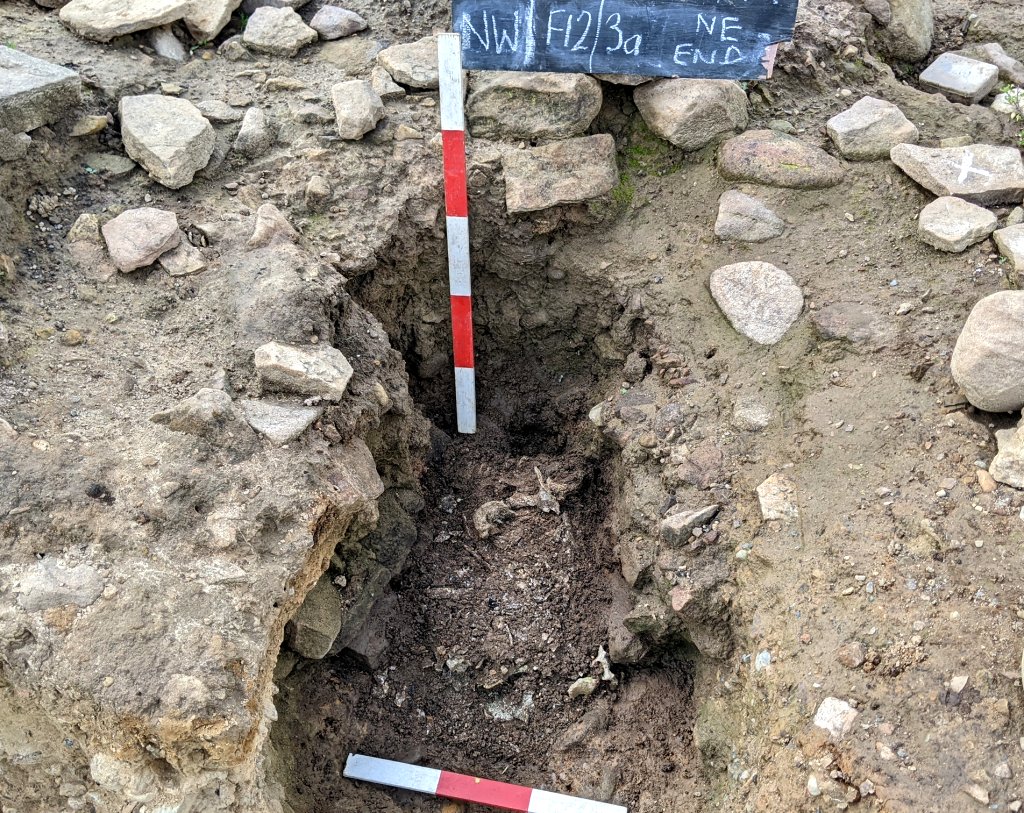 He noticed that there was a gap between the pack of bones and the sides of the pit suggesting something had held it in position (perhaps a leather bag of box).
He noticed that there was a gap between the pack of bones and the sides of the pit suggesting something had held it in position (perhaps a leather bag of box).
Following Ian Miller’s advice, it was decided to remove its contents of Urn1 (Feature F1) before lifting it. This would hopefully ease the pressure on the vessel wall and thus reduce the risk of it falling apart. Patrick took the same approach as Peter taking the fill down this time in 1cm spits. He first quartered then half sectioned it which revealed a lot of soil mixed with the charcoal and cremated bone. This was not surprising as the remains of this vessel has been lying just under the plough soil for a long time. 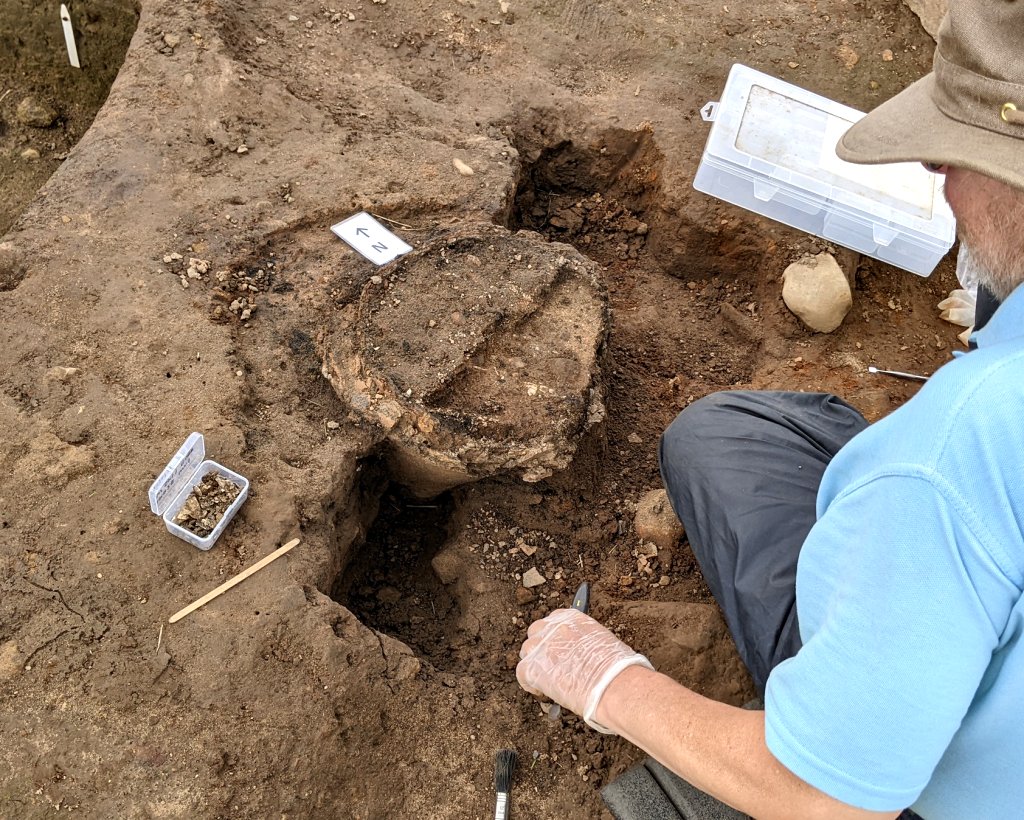
Alison and Marlene continued the work on the SE end of Trench 3a, trying to establish the nature of the stony layer which had turned up there. Bill asked them to clean the surface to see if they could find the extent of it. Alison worked at the very SE end of the trench which was proving difficult as the stone were generally small and loose in the fill so kept coming out. However she still was able to show that the stones continued up to the end of the trench. Marlene meanwhile worked on cleaning the other end, trying to establish the interface between the mottled clay surface and the stony layer. This seemed inconclusive as the stones, when they did appear were random and again kept coming out of the fill. 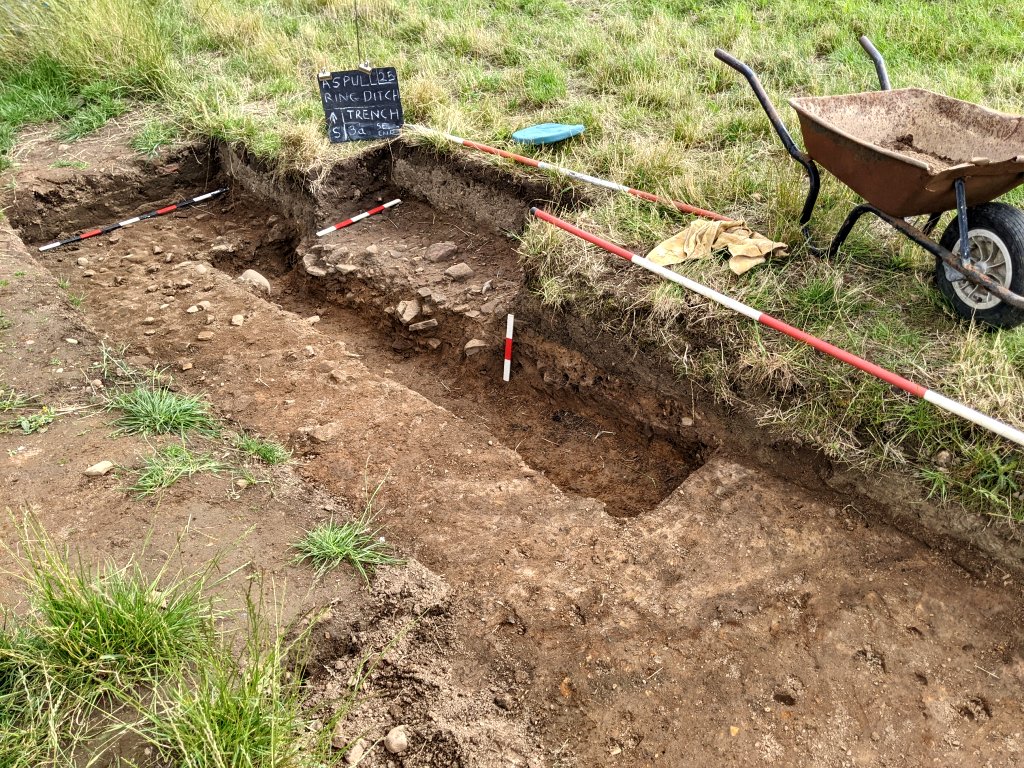 Bill took over from Marlene when she left after lunch and he was able to extend the cleaning further up the trench (towards the centre). Here he noticed a distinct change in the colour of the mottled clay surface defined by a reddish line crossing the trench at an angle.
Bill took over from Marlene when she left after lunch and he was able to extend the cleaning further up the trench (towards the centre). Here he noticed a distinct change in the colour of the mottled clay surface defined by a reddish line crossing the trench at an angle. 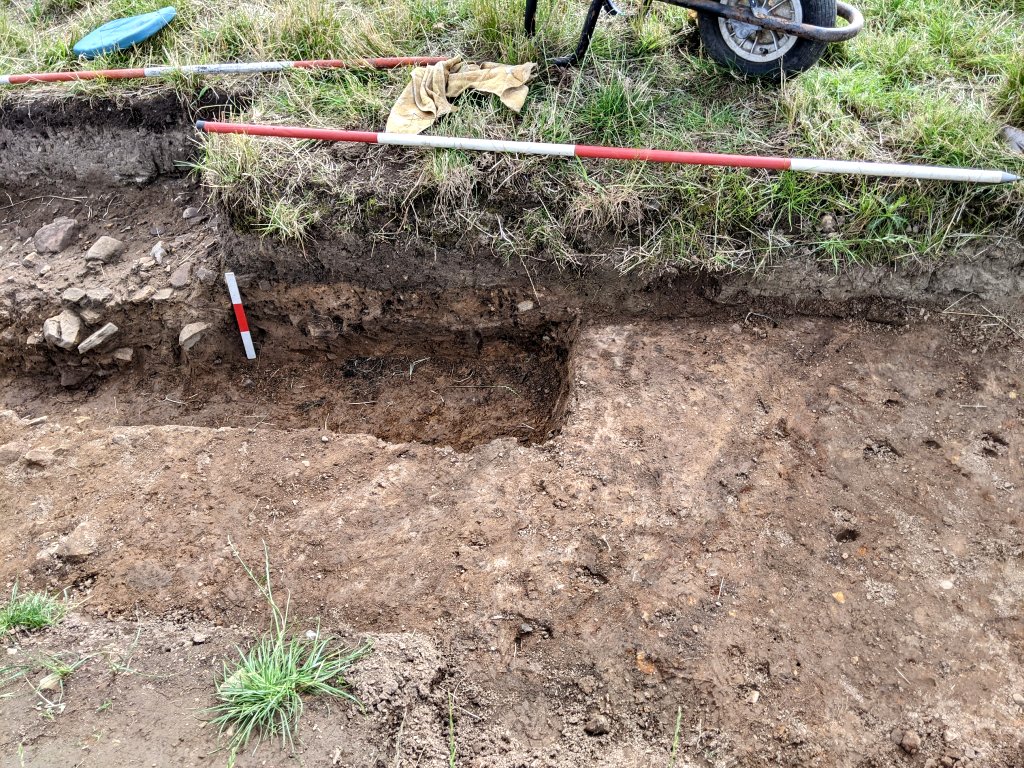 This area is proving to be be more complexed than expected, it is hoped extending the section might resolve the issue.
This area is proving to be be more complexed than expected, it is hoped extending the section might resolve the issue.
Tuesday 24th June
Today Bill, Chris, Patrick, Peter and John Trippier convened at the Bolton Archive facility where we took our lifted urn last week and where we intend to carry out its micro-excavation. Ian Trumble who invited us, is also allowing us to carry out the processing of all our cremated bone. We had therefore brought all the cremated bone removed so far including the fill from the burial pits. An inventory of all the material was taken and the method of processing it discussed. 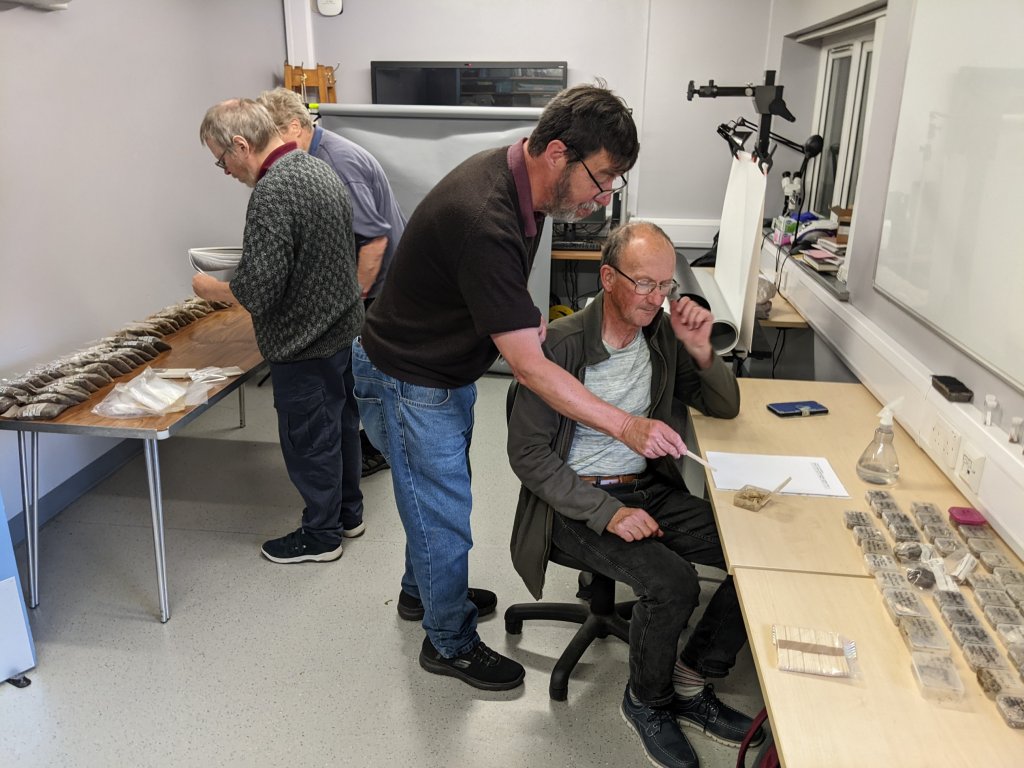 In the next few weeks or so we will be making arrangements for a team to go there on a regular bases to carry out the process as well as the micro-excavation of the urn.
In the next few weeks or so we will be making arrangements for a team to go there on a regular bases to carry out the process as well as the micro-excavation of the urn.
Wednesday 18th June
Day 28
Big day today, as we had planned to lift Urn2. So it was early start with Chris, Patrick and Marlene Nolan already on site when Bill, Andrew and Steve arrived. Ian Trumble soon followed with his extra equipment before going off to work (to return in the afternoon to witness the lift). Joining us later in the morning were John Trippier, Ben Dyson, Alison and Ben Goodburn. We also had a visit from Dave Goulden from Friends of Astley Hall in Chorley where a Bronze Age burial was excavated in the 1970’s.
The area around our Urn2 needed some preparation for lifting (video cameras being set up etc.). While this was being done, work continued on other areas of the site. Ben G, having finished in Trench5a, moved into Trench5 to clean up the sections of the charcoal-rich cairn making it ready for recording. Steve continued trowelling off remnant of the mottled clay layer from the stony layer in the newly exposed area of Trench1b. He continued his cleaning into the previously exposed area to show the full extent of the stony layer in this trench. 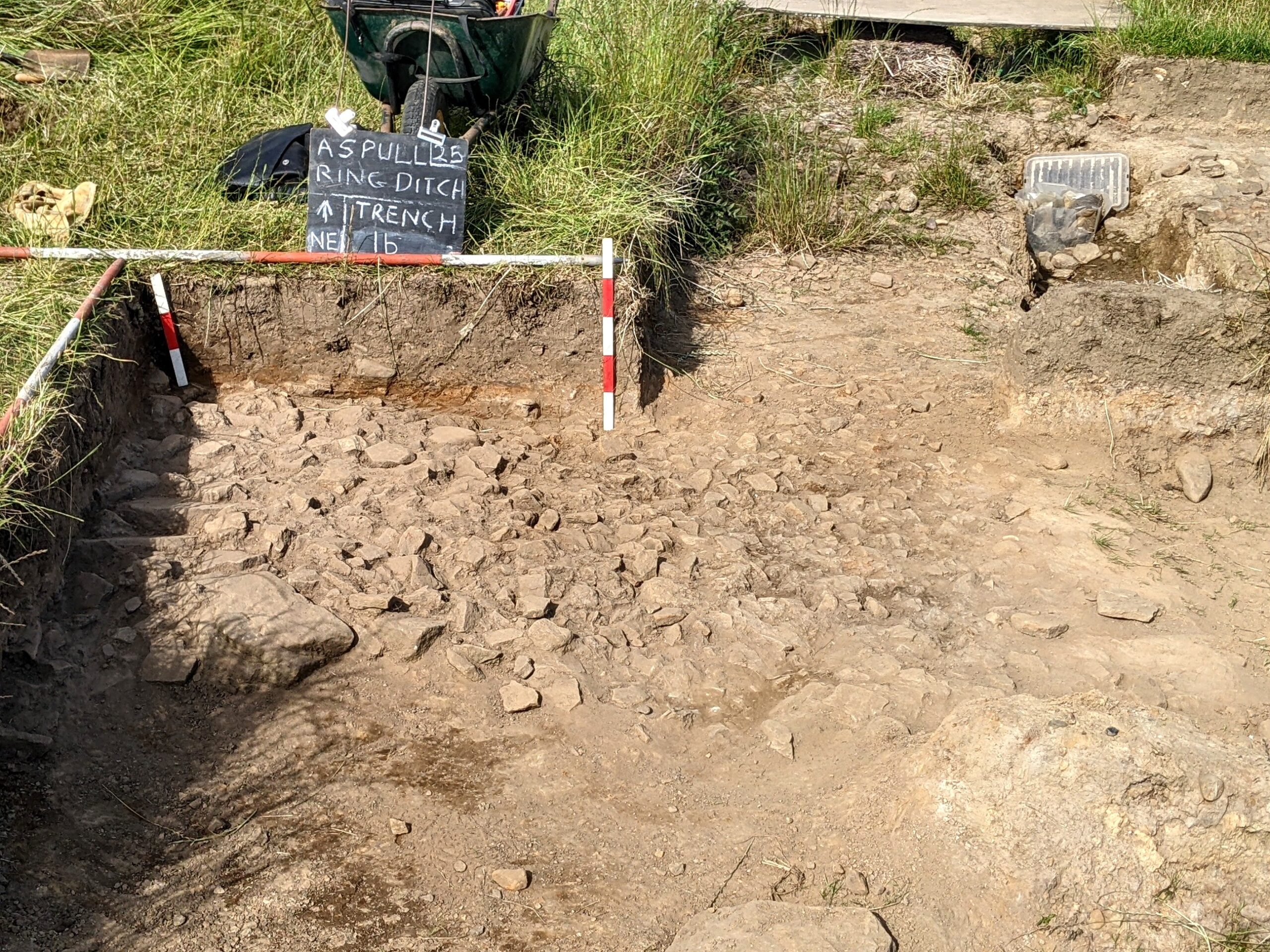
Bill continued working on Trench1d and with the help of Dave Goulden was able to extend it to just over two metres. Dave removed all the mottled layer which was quite thin to reveal the stony layer below with no sign of the burnt layer. 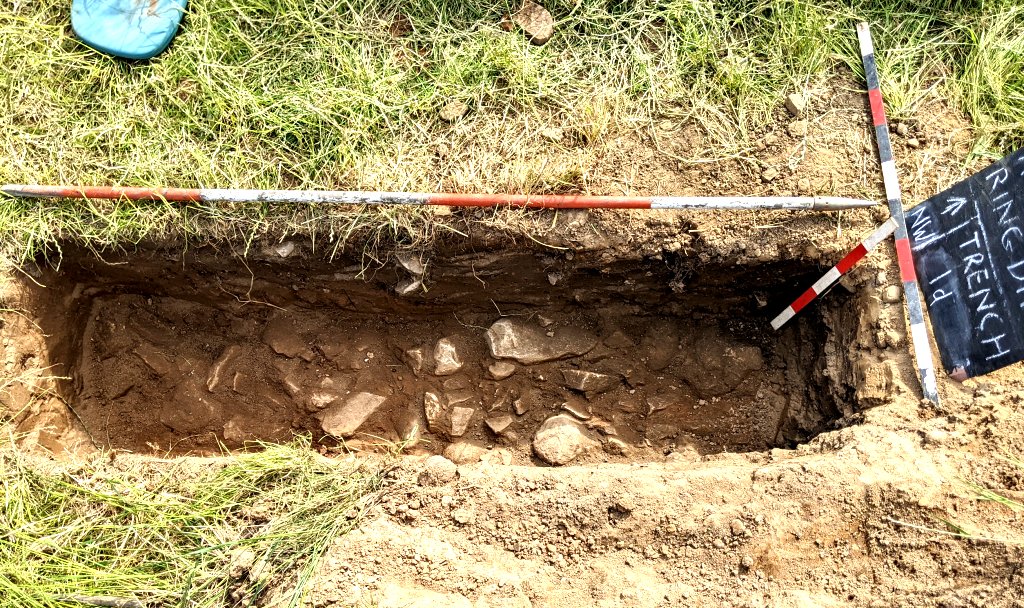
Andrew and Alison continued the work on the SE end of Trench 3a where a stony layer had been revealed. They were able to extend the section by cutting through the layer that the stones were embedded in, down to the lighter soft sandy clay layer below (now labelling this cut as Sondage 3a.S9). It seemed to Bill that this stony layer was similar to the stony layer found at end of Trench 1c (excavated in 2023). In that trench it seemed quite clear that the stony layer was embedded in a subsoil which lay on top of the mottled clay layer, but on top of the soft sandy clay on the other side going towards Trench 5b. Its something we need to check if its the same here.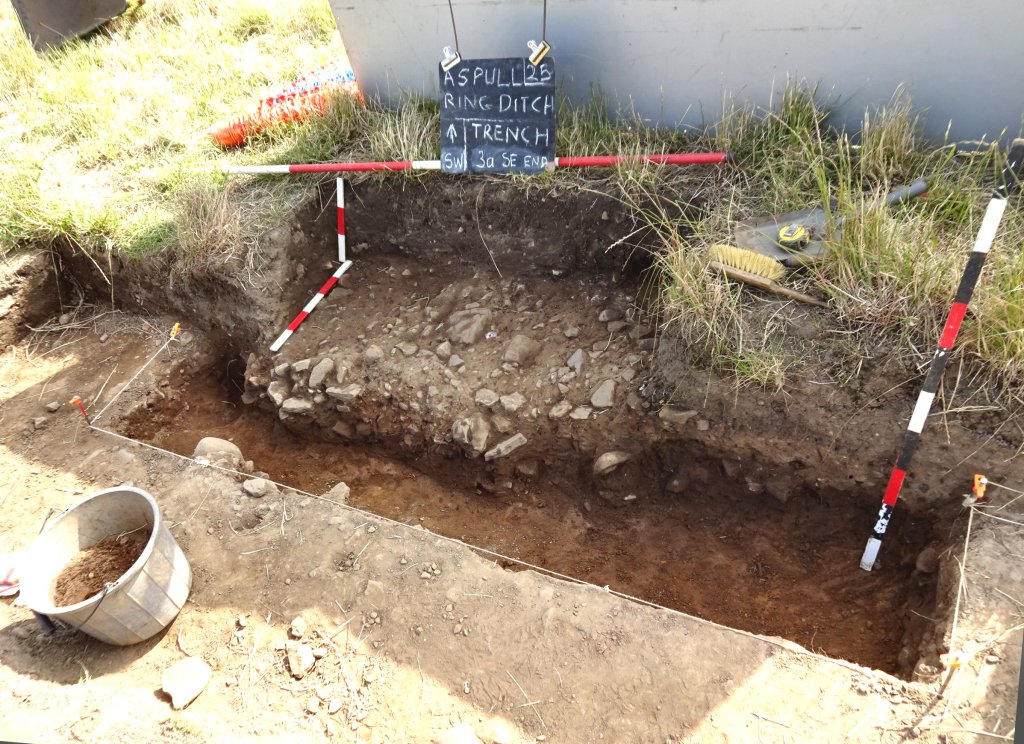
Work could start in earnest of our Urn2 when Ben Dyson arrived on site. First thing to reduce the amount of hardened clay encasing the urn on the north side. Patrick was able to do this by carefully worked on the lighter material down to the apparent cut line of the enclosing pit. 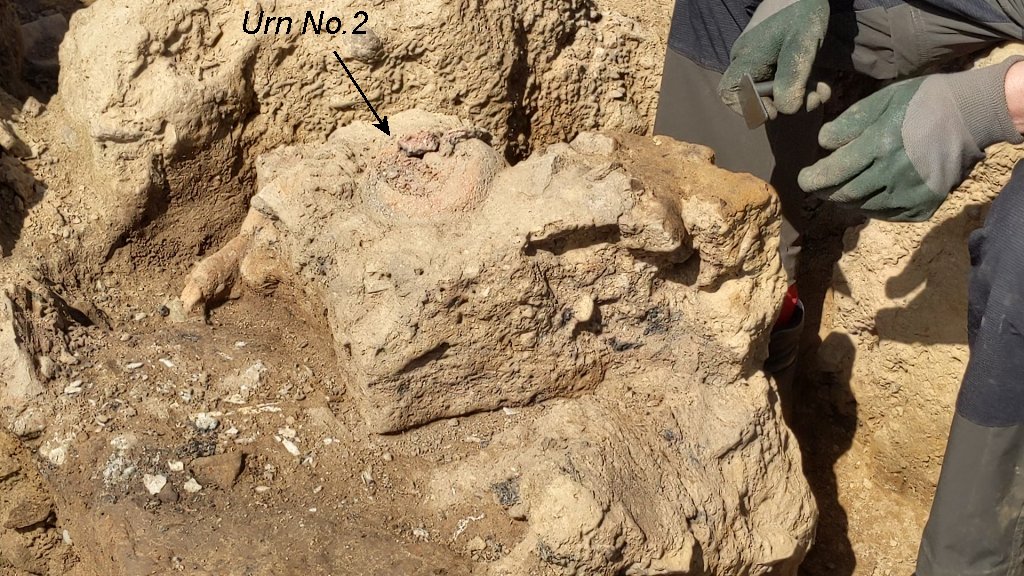 It was decided however to leave the hard orange clay protrusion (see Day21) in position. The next thing was to deal with the pieces that had come loose from the urn. Having first recorded their position each piece was removed and placed in a numbered bag.
It was decided however to leave the hard orange clay protrusion (see Day21) in position. The next thing was to deal with the pieces that had come loose from the urn. Having first recorded their position each piece was removed and placed in a numbered bag. 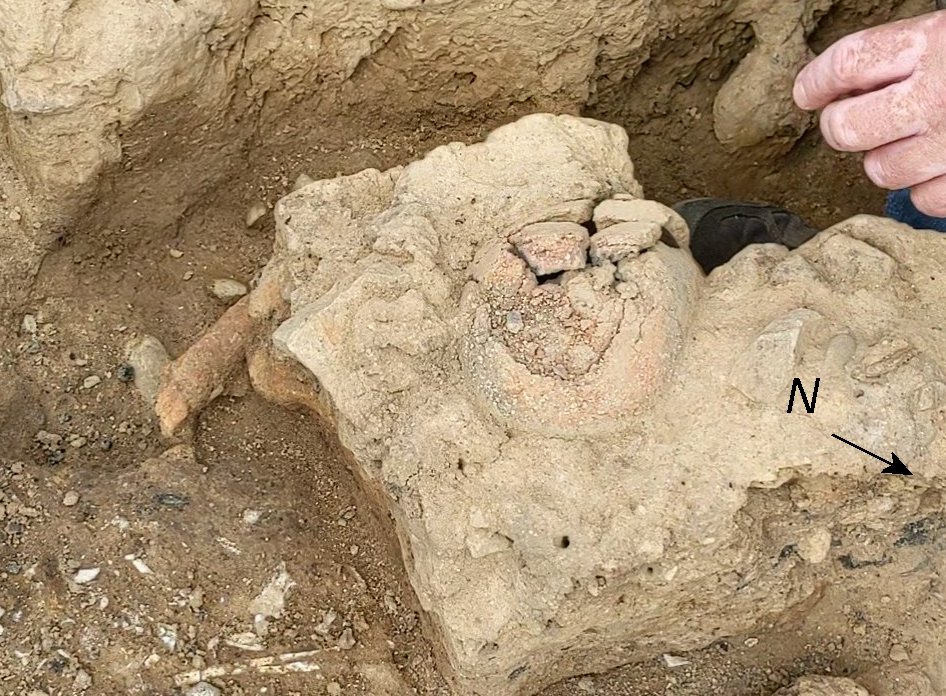 The inside of the urn was then packed with a wadding of bubble wrap having first made sure the base of the urn did not fall in (this was achieved by using an old credit card). Cling film was then wrapped around the block and where necessary gaps were packed once again with bubble wrap wadding.
The inside of the urn was then packed with a wadding of bubble wrap having first made sure the base of the urn did not fall in (this was achieved by using an old credit card). Cling film was then wrapped around the block and where necessary gaps were packed once again with bubble wrap wadding. 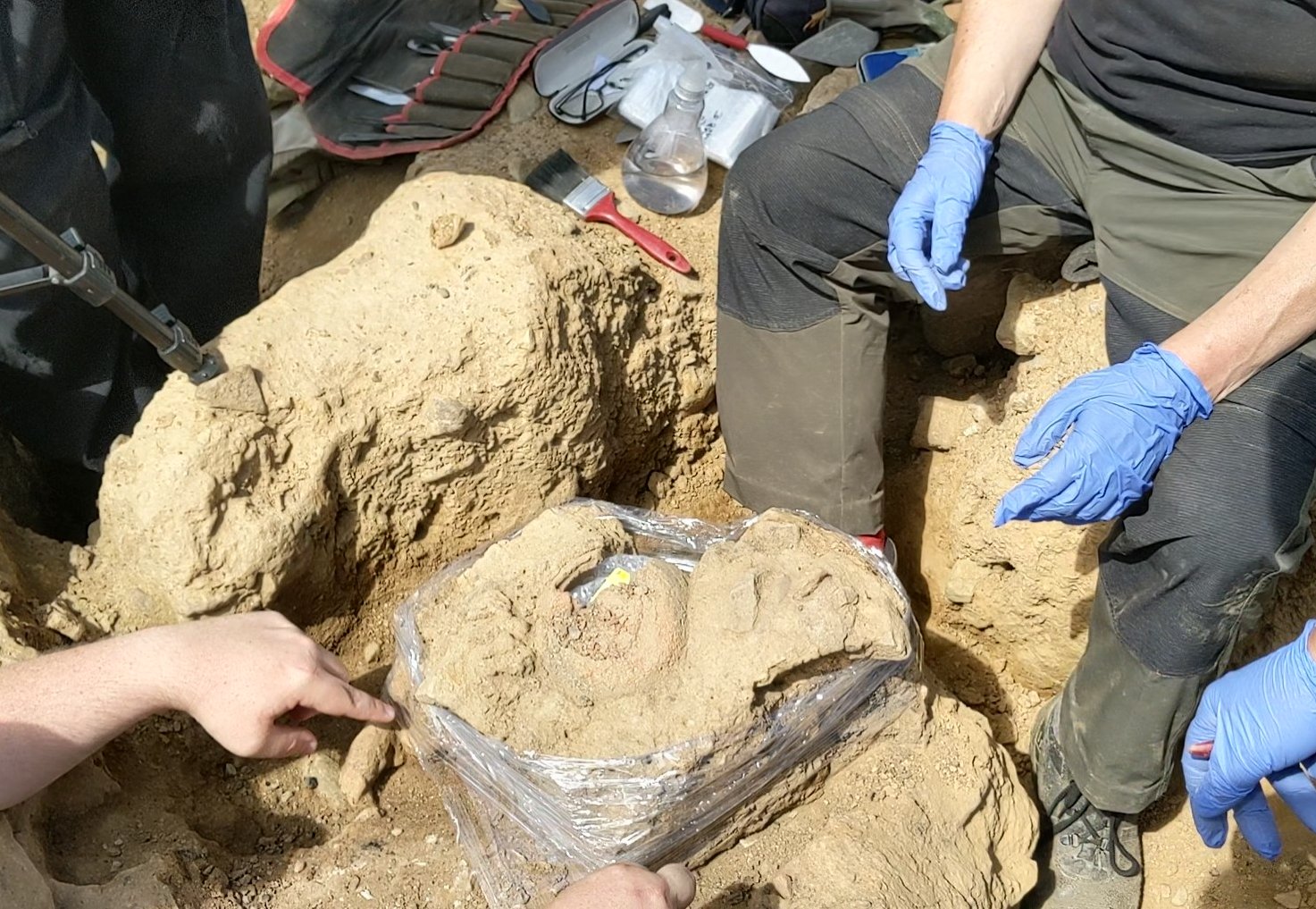 Crepe bandages were then wrapped around the block.
Crepe bandages were then wrapped around the block. 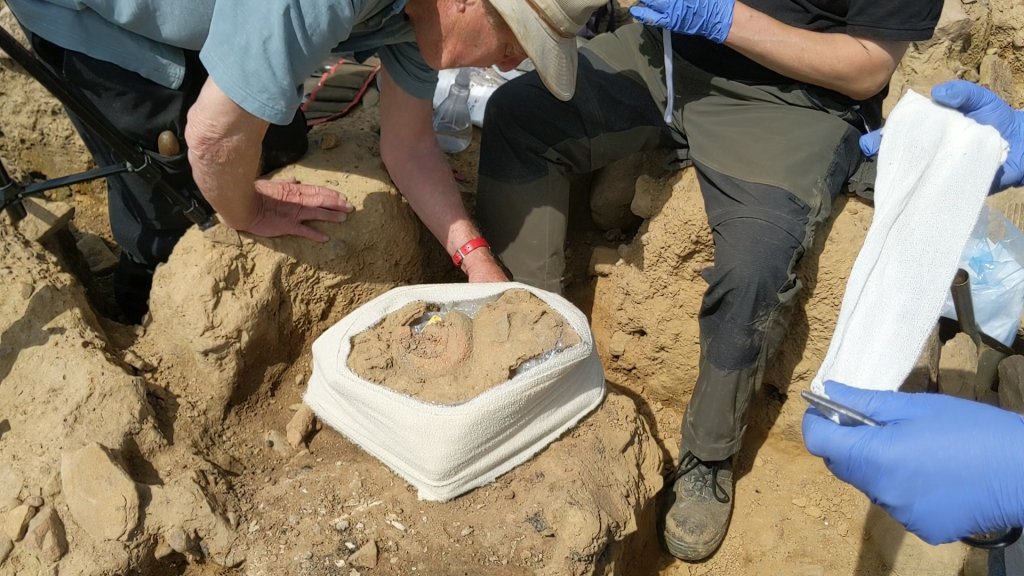 This was followed by an acid free plastic tissue material to protect the bandages from the next phase i.e. Plaster of Paris.
This was followed by an acid free plastic tissue material to protect the bandages from the next phase i.e. Plaster of Paris. 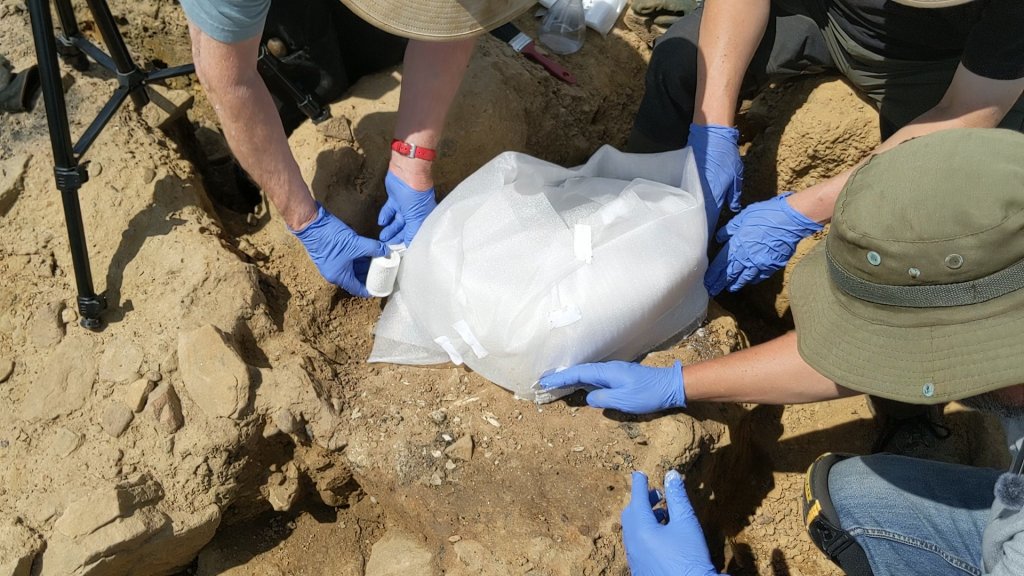 After protecting the lower burial contain cremated bones, the Plaster of Paris was applied using bandages soaked in it. This was allowed to set before another layer was applied and allowed to set while we waited for Ian to return in the afternoon to help with the lift.
After protecting the lower burial contain cremated bones, the Plaster of Paris was applied using bandages soaked in it. This was allowed to set before another layer was applied and allowed to set while we waited for Ian to return in the afternoon to help with the lift. 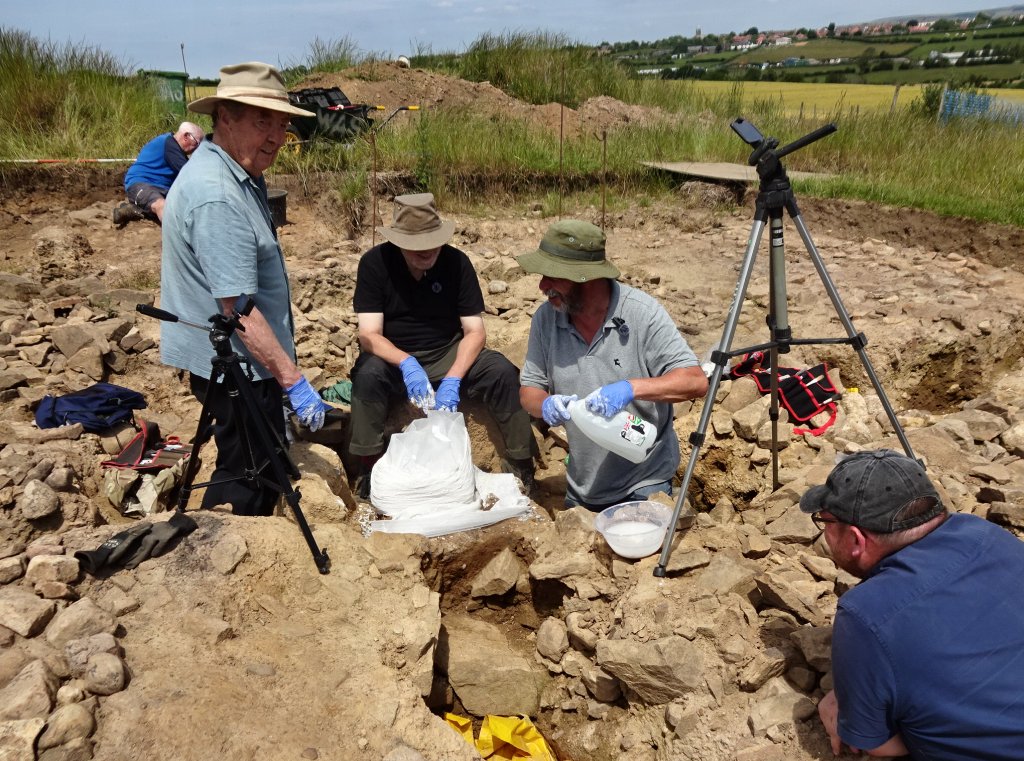
Once the second batch of Plaster of Paris had set we were ready to attempt to lift the block, the idea being that by undercutting around the edges, the block would break free from the underlying surface. A metal plate could then be inserted underneath to support the contents. This however proved to be much more difficult than expected. On the north side, after some persuasion, the block did indeed crack free – but the south side did not. The issue seemed to be with the sandy clay on that side which had small stones embedded in it and also the clay had not completely dried making it not solid. It was only after some wrestling with it that we able to get a plate under to support the contents (in fact two plates were needed in the end). 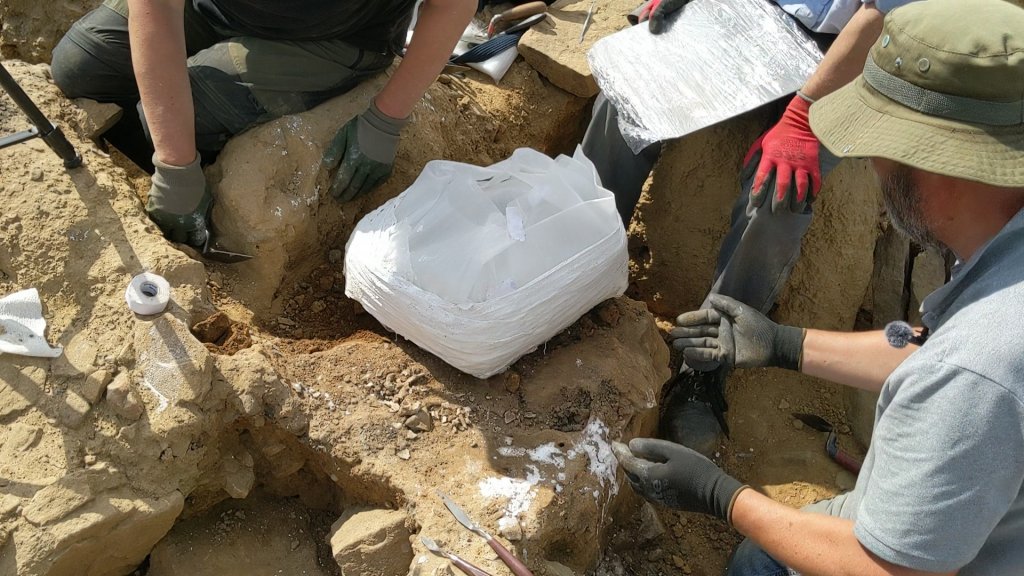 Once completely free the block was lifted onto the transportation box supplied by Ian where it was once again wrapped in cling film.
Once completely free the block was lifted onto the transportation box supplied by Ian where it was once again wrapped in cling film. 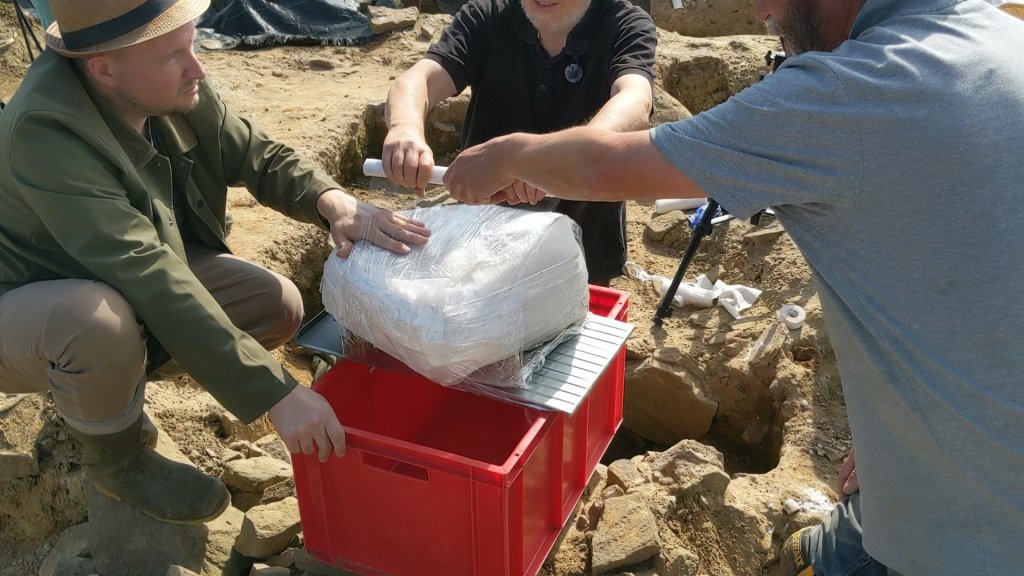 It was then placed in side the box on foam packing. We then were able to take it off site to be taken to the Bolton Museum facility by Chris and Patrick carefully supporting it on his knees (phew!).
It was then placed in side the box on foam packing. We then were able to take it off site to be taken to the Bolton Museum facility by Chris and Patrick carefully supporting it on his knees (phew!).
Tuesday 17th June
Day 27
Joining Bill and Chris today were Andrew, Patrick, Steve, Alison Winnard, John Needle and John Trippier.
This week we intend to lift at least one of our urns, so first off Chris convened a meeting to discuss the proposed plan of attack so that we can do the lift following day. It was decided to lift Urn2 first as it was the most fragile and had suffered the most deterioration. Chris proposed a block-lift which he thought we could achieve as the urn was encased in sandy clay which had set hard in the dry weather. He went through the procedure Ian Trumble had suggest to him including a list of equipment needed (Ian had as already done a block-lift when he worked on Star Carr) . We were still some items short which Ian said he would bring in the morning before he went to work. Ben Dyson from GMAAS had kindly offered to supervise the lift on the day. It was decided therefore not to do any more work on the urns today.
Bill said we still had more work to do on the central area of the monument. Although we had a good idea of the extent of the stony layer in most areas, there were just a couple of corners still undefined i.e. on the west and north sides. He suggested therefore a new trench on the north side of Trench1b starting about a metre or so beyond it heading in a northeast direction. Its width would be restricted though due to the spoil heaps on this side of the trenches. With this agreed, John N helped Bill with the removal of the turfs and some of the spoil which the trench inevitably cut into. This revealed the expected mottled clay layer but also the stony layer on the northeast side of the trench with on covering clay layer. 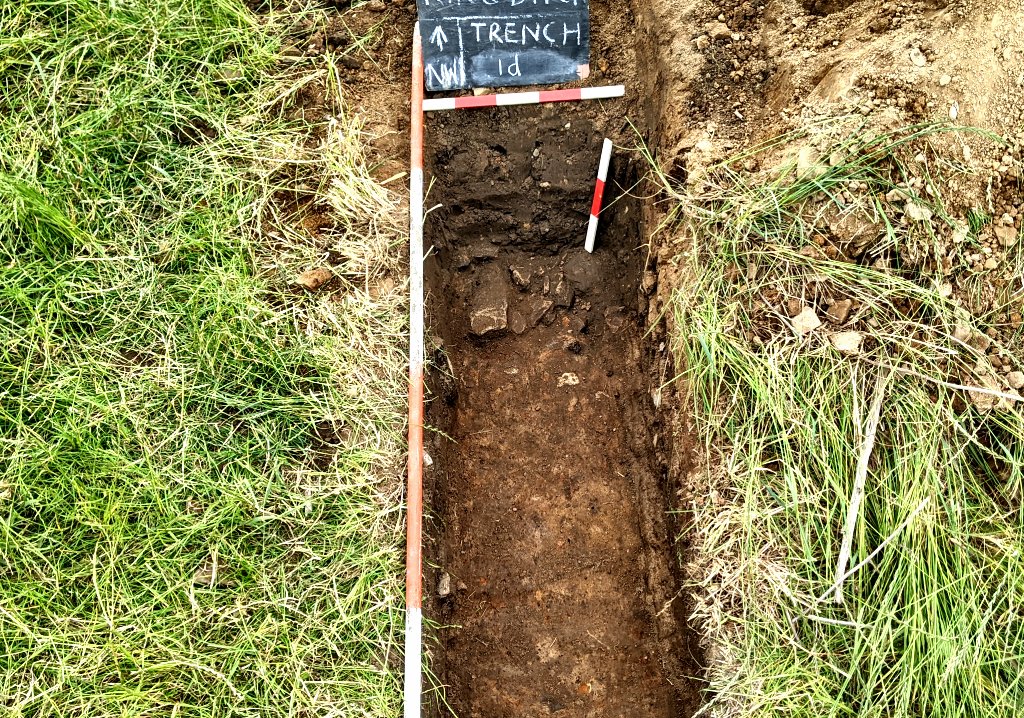 This meant the trench would need to be expanded in the northwest direction (and into more of the spoil heap).
This meant the trench would need to be expanded in the northwest direction (and into more of the spoil heap).
Steve was given the task of trowelling off the mottled clay layer of the newly exposed north corner of nearby Trench1b. Some larger stones appeared on the northeast edge of the trench rising up where there seemed to be a gap in the mottled clay layer. This was confirmed in the section which showed the mottled clay layer undulating severely at that point (possibly due to the plough). 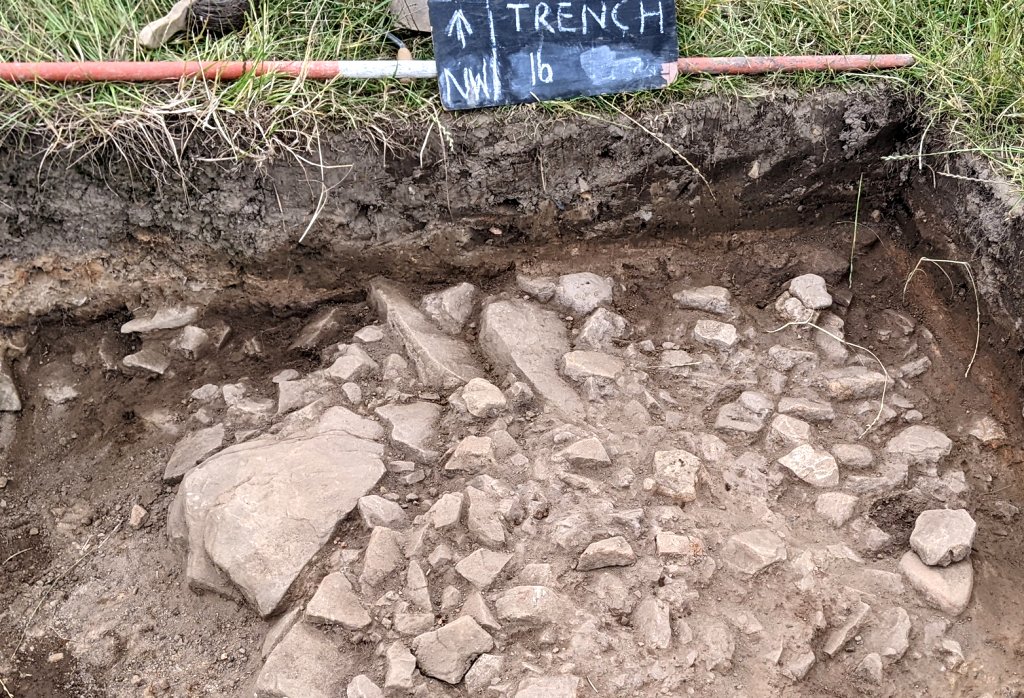
Alison meanwhile continued exploring the patch of charcoal near feature F18 in Trench3a on the southwest side. By cutting a small sondage down the side of it she was able to demonstrate the charcoal did not go any deeper. 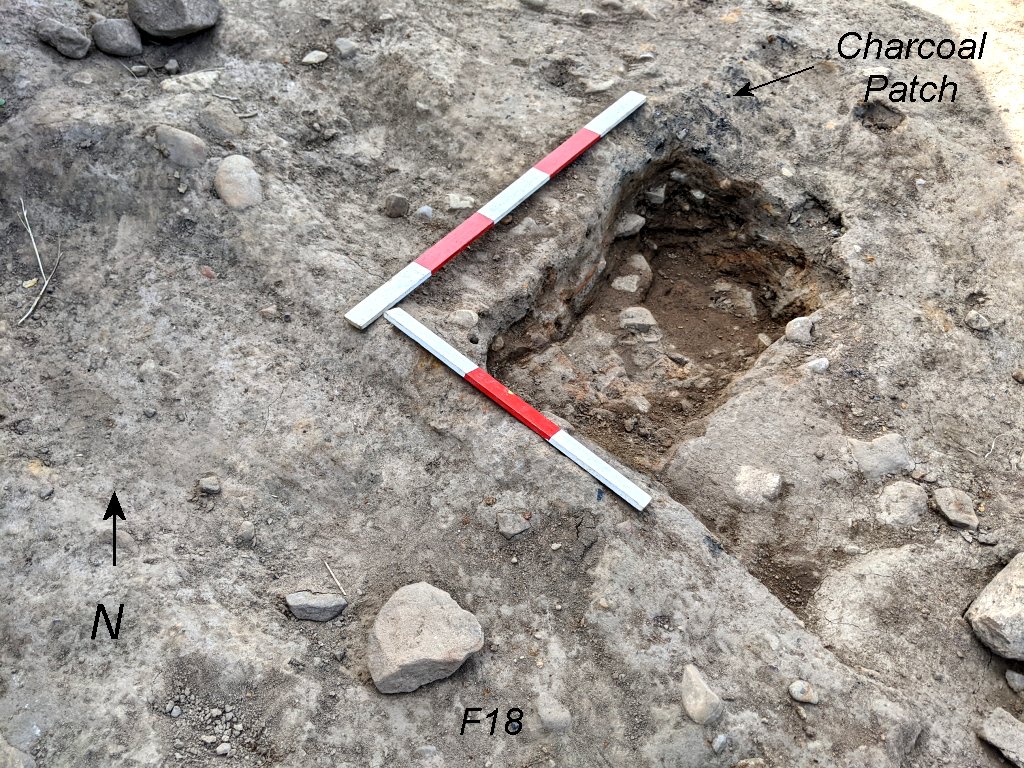
Patrick, Andrew and John T continued with the work on the stony area at the SE end of Trench 3a exposing more of the stony layer. There was some debate about its context in relation to the rest of the monument. The first impression was that the stones were embedded in the subsoil previously identified in this area lying on top off the softy sandy clay (similar to the stony layer discovered on the very northeast end of Trench1c). To investigate this, Bill asked them to expand the sondage already cut through it to exposed the section. 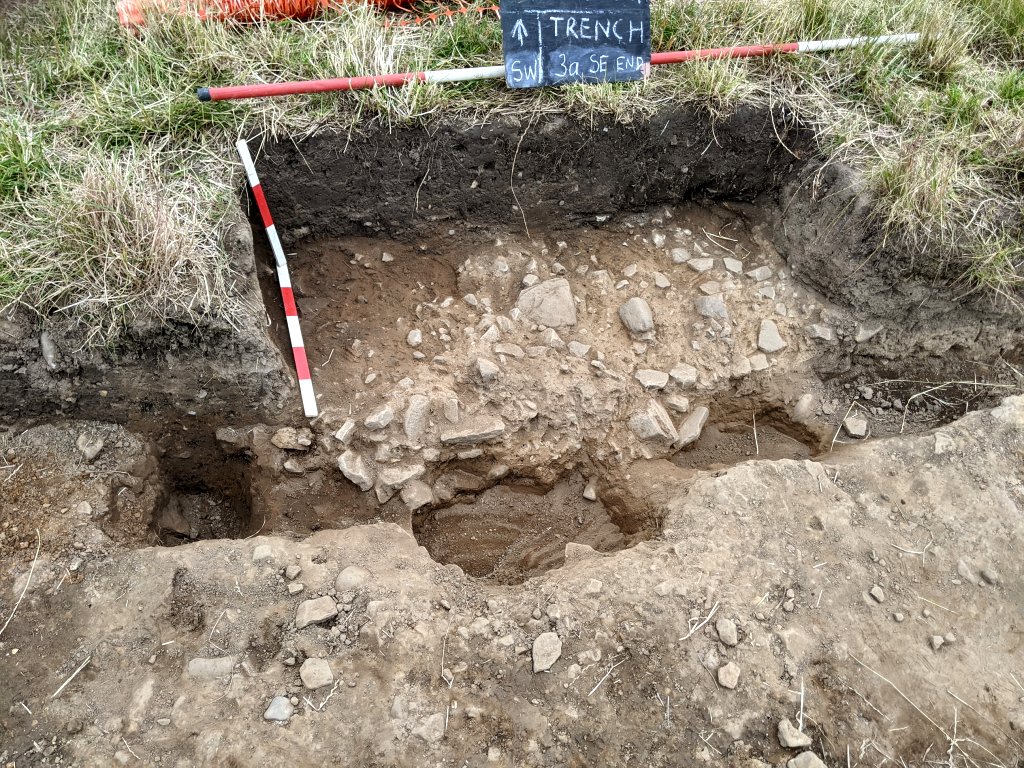 Early impressions were that this it was the case as the more brightly coloured soft sandy clay could be detected underneath the darker brown of the stone filled layer. However more work will be needed here to confirm this.
Early impressions were that this it was the case as the more brightly coloured soft sandy clay could be detected underneath the darker brown of the stone filled layer. However more work will be needed here to confirm this.
Saturday 14th June
Day 26
BHAG had been due to come up to Aspull today, but due to the bad weather had cancelled. The weather turned out fine, and apart from a sharp 10min downpour. There was still a decent turnout as joining Chris and Patrick were Peter, John Trippier, Roger and his friend Martin.
Chris and Peter carefully examined the area around Urn2 looking at the newly discovered darker brown layer containing small stones on the south side. They also cleared a path beneath the lump of hard orange clay so that it could be included in the block lift due to take place next week.
John and Patrick continued to clean the recently opened area at the SE end of Trench 3a where a layer of stones had been found.
After lunch, Roger arrived with his friend Martin, who was given a tour of the site by Chris. Roger meanwhile helped Peter in de-turfing the north corner of Trench1b and trowelling it down to the mottled clay layer.
Before leaving Chris competed drone survey of the interior of the site.
Thursday 12th June
Day 25
Joining Bill and Chris today were Andrew, Peter, Francesca, Rachael and Steve Parry with Patrick and Ben joining later.
Francesca and Rachael joined Andrew working on the stony area at the SE end of Trench 3a. To get an idea of its extent, it was decided to cut a 1.5m wide section 0.5m towards the NW. This revealed more stones, some larger ones. 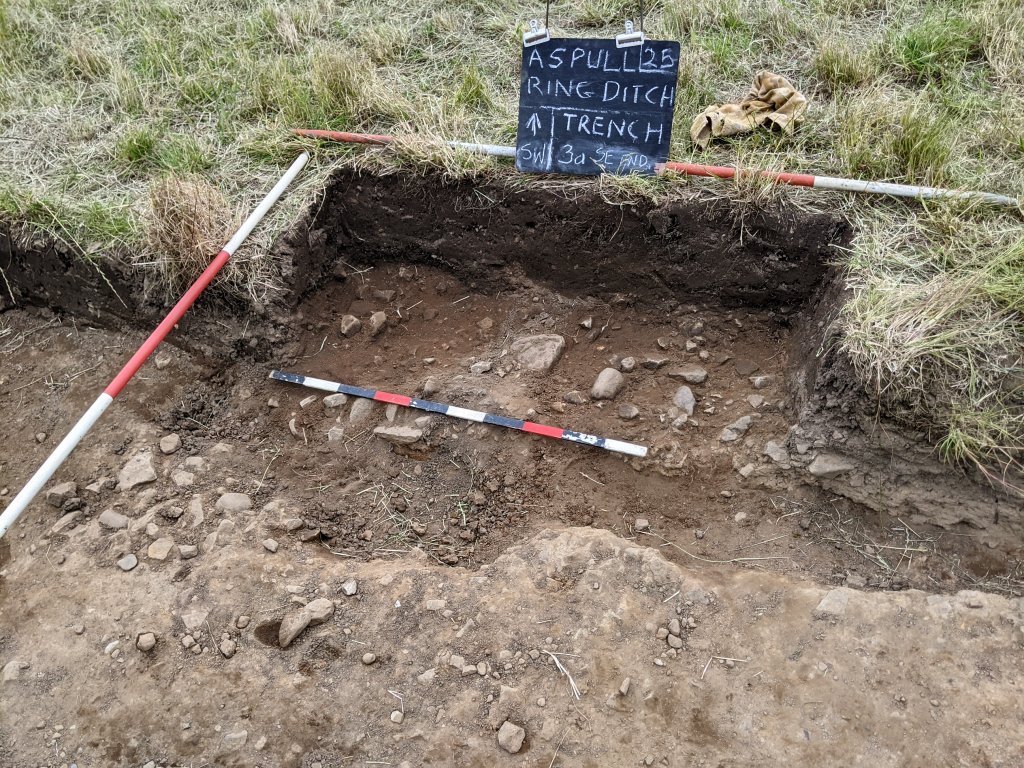
Steve joined Peter working on the section in the NW corner of Trench1b where Peter had removed the baulk between it and Trench1a. This did not reveal much burning but did show a reddish layer covering the stony layer which was reminiscent of the stony area exposed when this trench was extended towards Trench3a at the very start of last year’s excavations. 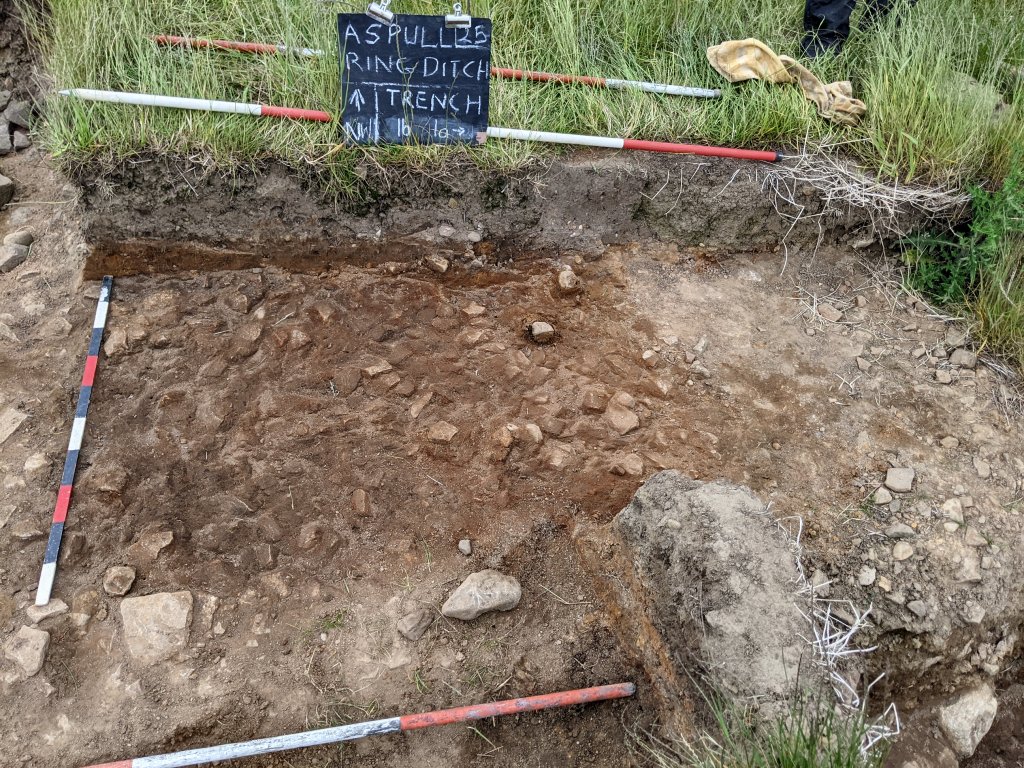
When Ben arrived he continued with the task of cleaning out the bottom of Trench 5a. When finished he will move onto the adjacent trench (Trench 5) to prepare the stony mound which lies at the bottom of it, for recording. 
At lunchtime we were joined by Ian Trumble who brought up more equipment for our planned urn lifting next week. Ian has block-lifted items in the past so has some experience of the difficulties. He was able to explain some of these which will be invaluable for our attempts. Urn2 will be the most difficult due to its condition but it is hoped to be able to lift it still encased in its surrounding sandy clay which has set like concrete. Once out and supported on their respective steel plates, wrapped in their protective padding and bandages, the blocks will be placed in padded boxes, also provided by Ian’s Museum services, ready for transport to the archive centre in Bolton.
In the afternoon Bill carried on with his work on the large flat stone slabs near our suspected cist (F11). This time he worked close to the large cavity which is thought to be the heart of the suspected cist. The inside of the cavity had been covered by a tarp to protect any potential material from contamination and Bill was keen to keep it as he worked near it. As he cleared away the soft brown sandy clay around the large stones, more small stones emerged in and amongst them but no sign of a cavity or stone arrangement that could suggest anything like burial structure. Despite there being no sign of charcoal near the bottom of the pit surprisingly a large piece cremated bone appeared, on its onw in the soft sandy clay. John Needle had discovered some flecks of cremated bone when this area was first uncovered last year (Day 25) lying under a large triangular stone, but that was further to the NW. 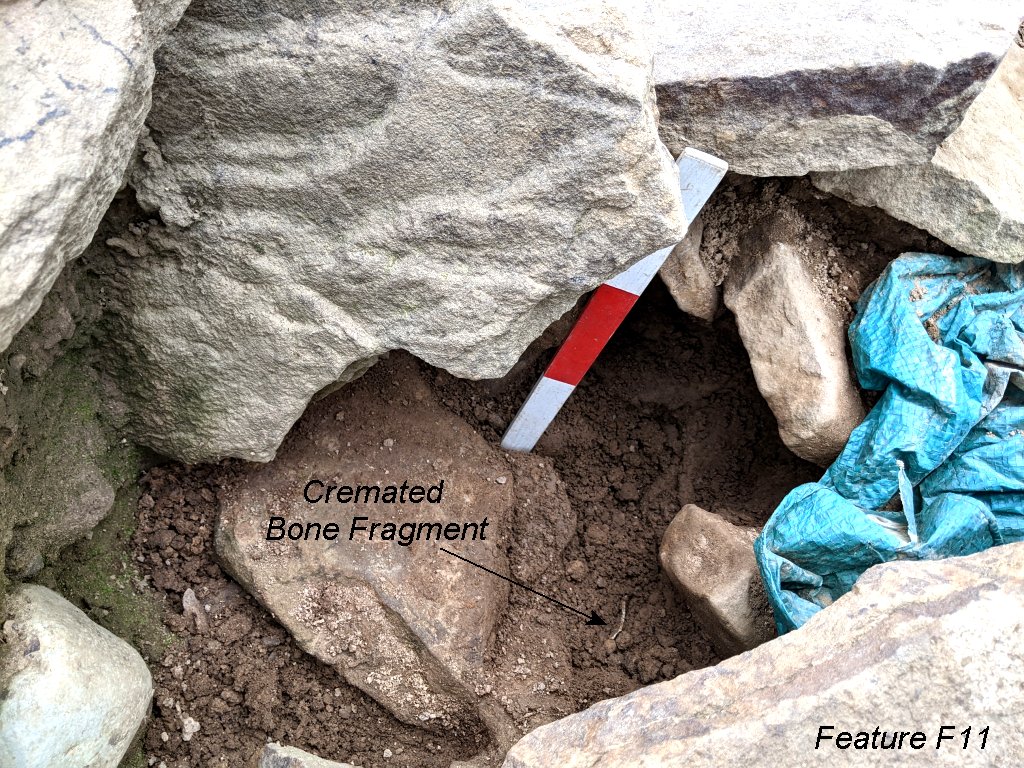 This new large piece could be more of the same and maybe the overspill from a disturbed burial inside the suspected cist itself.
This new large piece could be more of the same and maybe the overspill from a disturbed burial inside the suspected cist itself.
Wednesday 11th June
Day 24
Joining Bill and Chris today were Andrew, Peter, Isabel, Jon and Roger with Patrick joining before lunch.
Peter and Jon finished working on the newly exposed section in Trench 3a on the NE side (near Peg 3), trowelling off the last of the mottled clay layer to reveal the stony layer below. There were traces of burning but not as intense as further to the southeast in the this area. There were no signs of any burials but they did come across three small voids below the mottled going through the stones into the sandy clay below. Probing showed them to be from 20cm to 40cm deep. They weren’t particularly vertical so thought probably not stake holes and as there were no signs of decayed matter, probably not tree roots either. The only other suggestion was that they were the result of a burrowing animal. 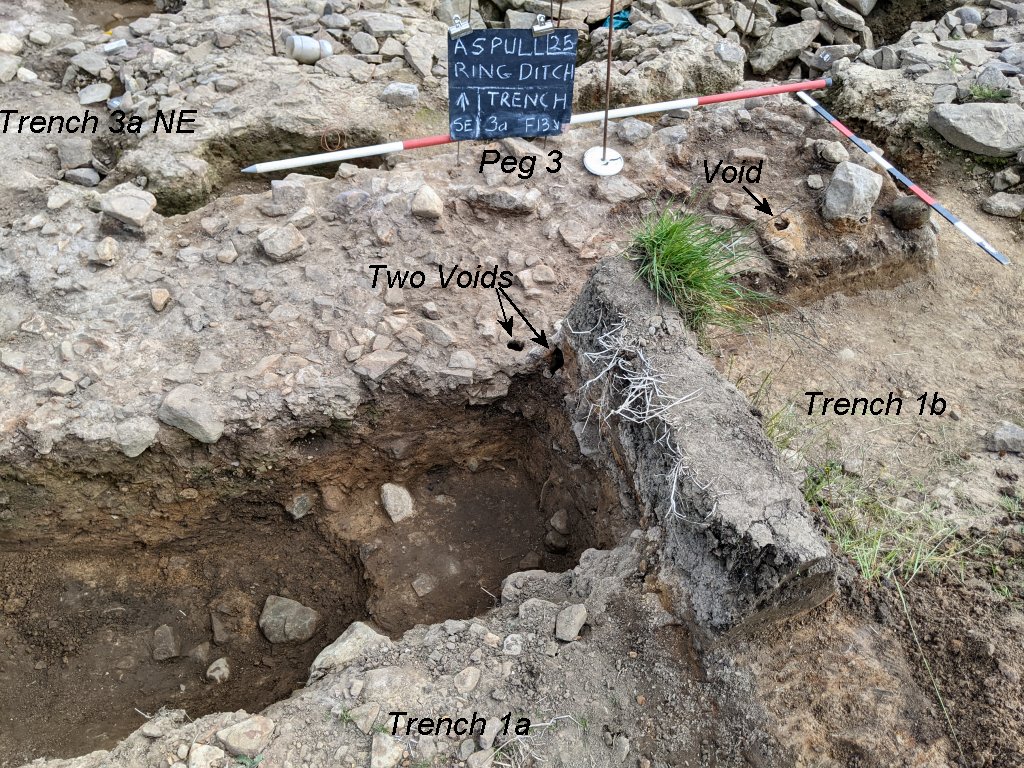 Jon then cleaned out the sondage in Trench 1a (S3/S4) revealing the unusual sudden step in the compacted stony base (assume to be the natural ground surface). Meanwhile Peter removed the part of the thin baulk separating Trench 1a from 1b. This was in preparation to removing the mottled clay layer which was left in NE corner of Trench 1b when it was originally excavated.
Jon then cleaned out the sondage in Trench 1a (S3/S4) revealing the unusual sudden step in the compacted stony base (assume to be the natural ground surface). Meanwhile Peter removed the part of the thin baulk separating Trench 1a from 1b. This was in preparation to removing the mottled clay layer which was left in NE corner of Trench 1b when it was originally excavated.
Andrew was tasked with continuing with the investigation of the stony layer embedded in the subsoil located at the SE end of Trench 3a. By deepening the section he could confirm its depth to be about 20 to 30cm. 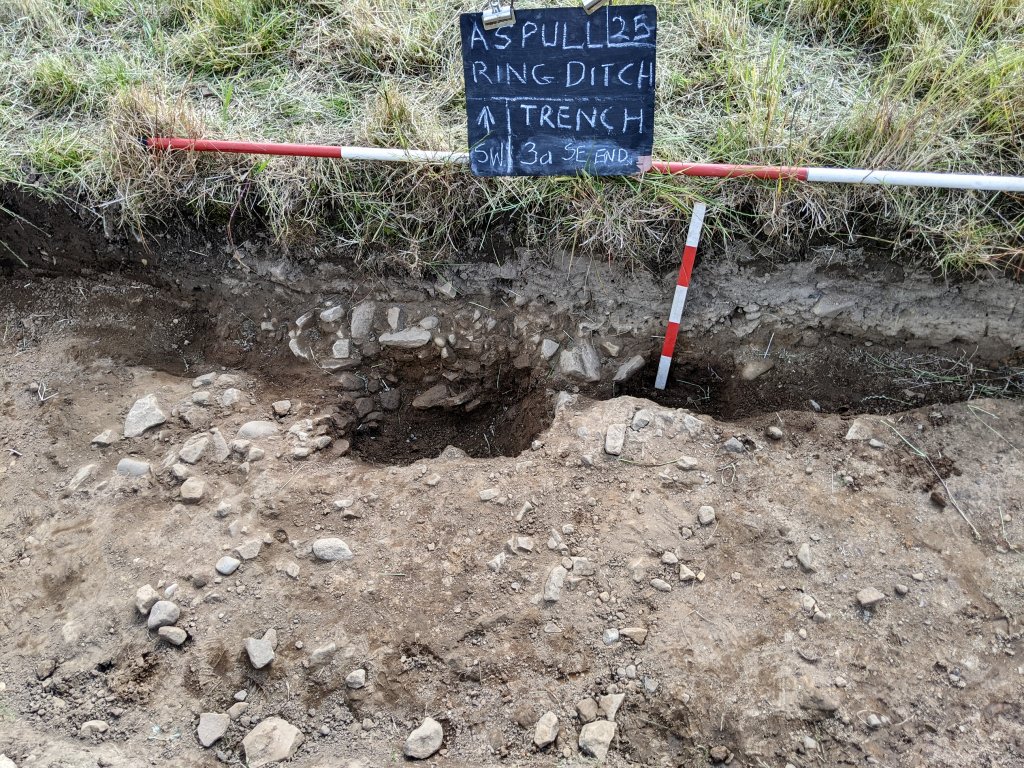
The Friday before, Chris, Patrick and John Trippier had been invited by Ian Trumble to visit the Bolton Museum archive facility where they have kindly offered to take our urns and cremated remains for processing. Ian was able to show them their environmentally controlled rooms ideally suited for our purposes and equipment we will need for it. Ian was also able to give Chris items we will need for removing the urns such as bandages, binding tape etc. which Chris brought on site. These were stored in waterproof boxes Chris had also acquired (the plan is to attempt to lift at least one of the urns next week – weather permitting). Chris then carried out one of his regular drone surveys.
When Patrick arrived, he continued excavating the small section he had opened up on the SE side of our clay-lined feature (F4). Isabel and Roger meanwhile continued to investigate the large patch of next to the small group of stones (F18) which contained flecks of charcoal. 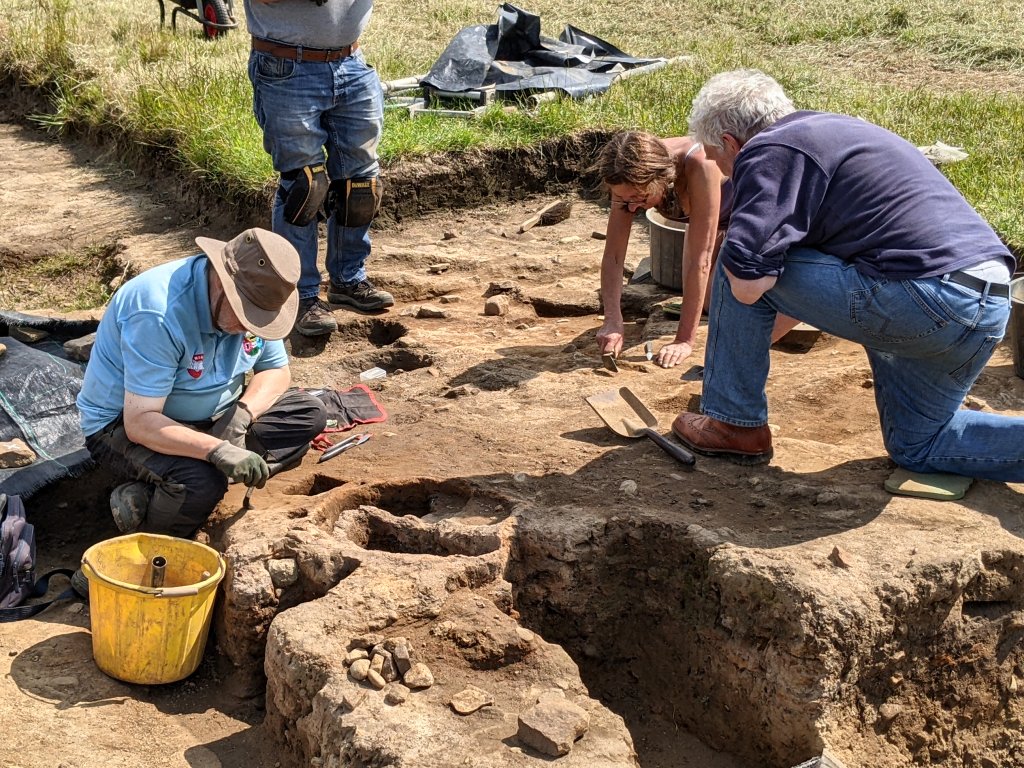 Many more flecks began to emerge which seemed to be spread across an area of over metre with some quite intense patches – and eventually some tiny specks of cremated bone was starting to emerge.
Many more flecks began to emerge which seemed to be spread across an area of over metre with some quite intense patches – and eventually some tiny specks of cremated bone was starting to emerge. 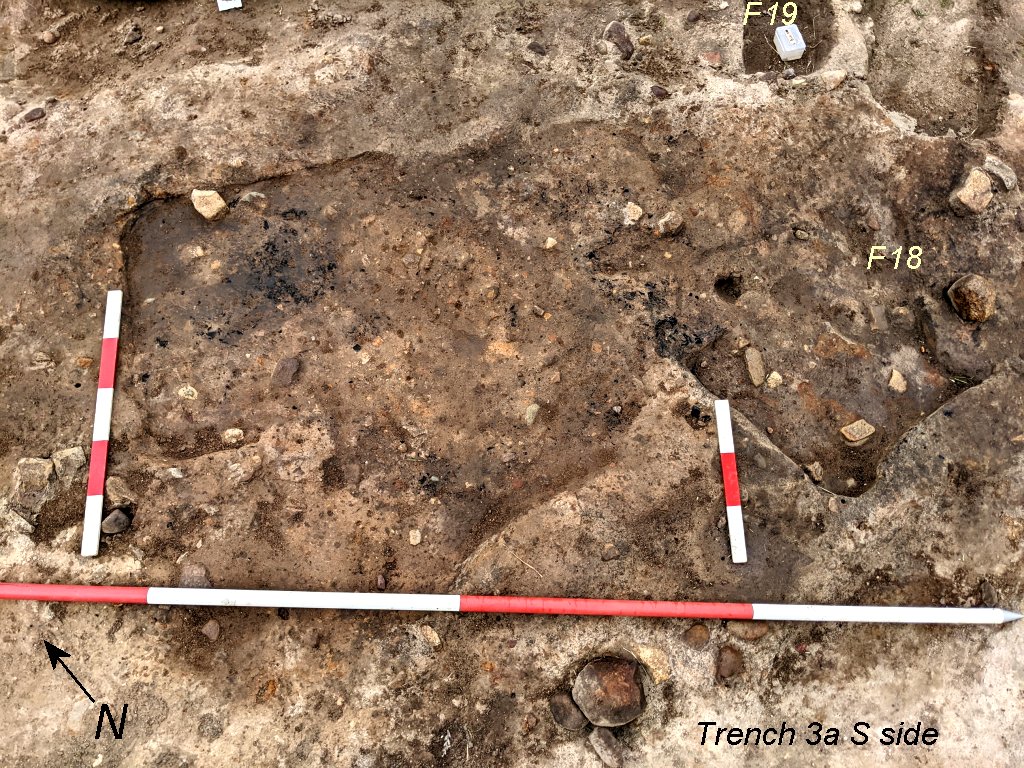 Near to where the small patch of small stones had been, a more intense patch of charcoal was revealed with some large pieces in it. This are is now looking quite promising.
Near to where the small patch of small stones had been, a more intense patch of charcoal was revealed with some large pieces in it. This are is now looking quite promising. 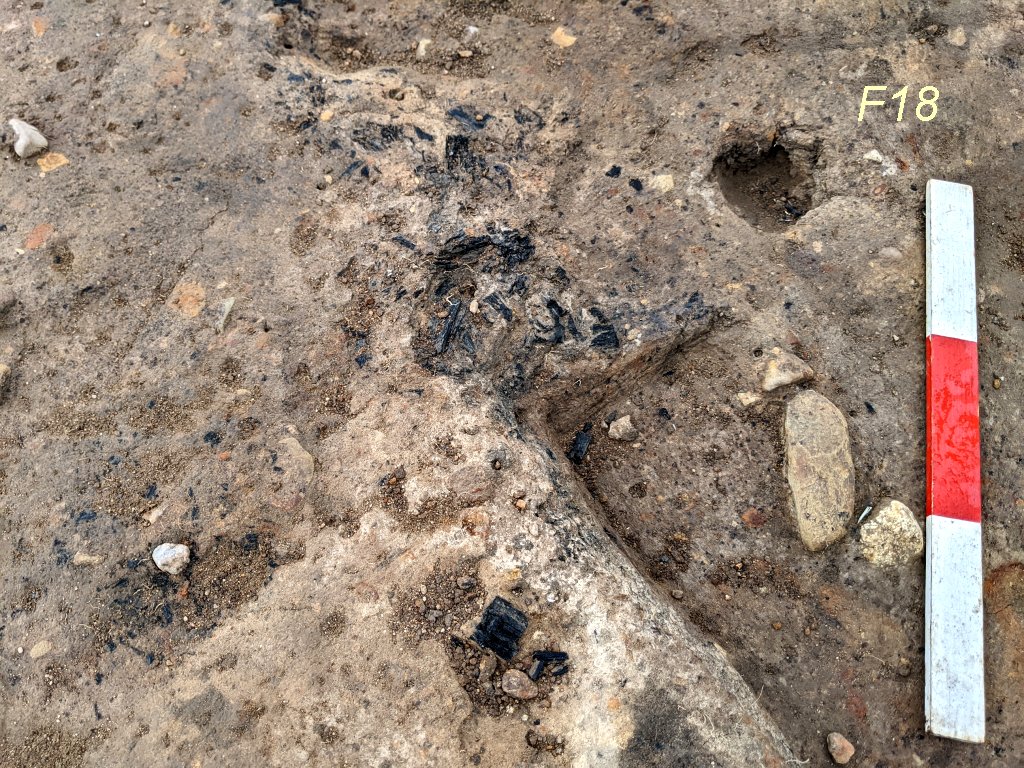
Bill carried on with his work on the section on the SW side of the cist feature (f11), this time working more towards the area of to the suspected cist where we found the large cavity. Here large slabs of stone are lying at odd angles suggesting they could have been the remains of a cist extending from the cavity area. 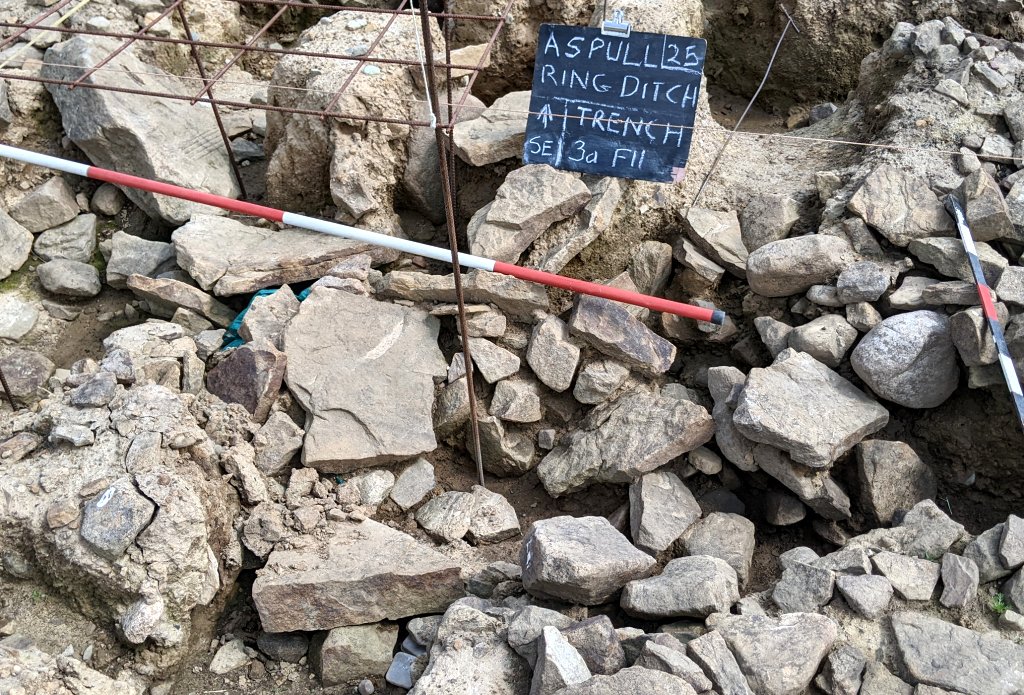
Tuesday 4th June
Day 23
Great turnout today despite the unpredictable weather. Joining Chris and Bill were Andrew, Peter, Steve, Susan Jon Shelley and John Needle with John Trippier, Patrick, Ben and Roger Chapman joining later.
John N was deployed in Trench 3 with Steve in Trench 3d. Steve spent time cleaning off the bedrock at the very SE end of the trench revealing the regular fissions in it. This he suggested my explain the shape edge to the pit in this area. John was tasked with cleaning the section on the NW edge of the ditch revealing the small layer of compacted glacial till lying on top of the bedrock (further to the NW in the this trench the bedrock gives way to a deep layer of soft sandy clay).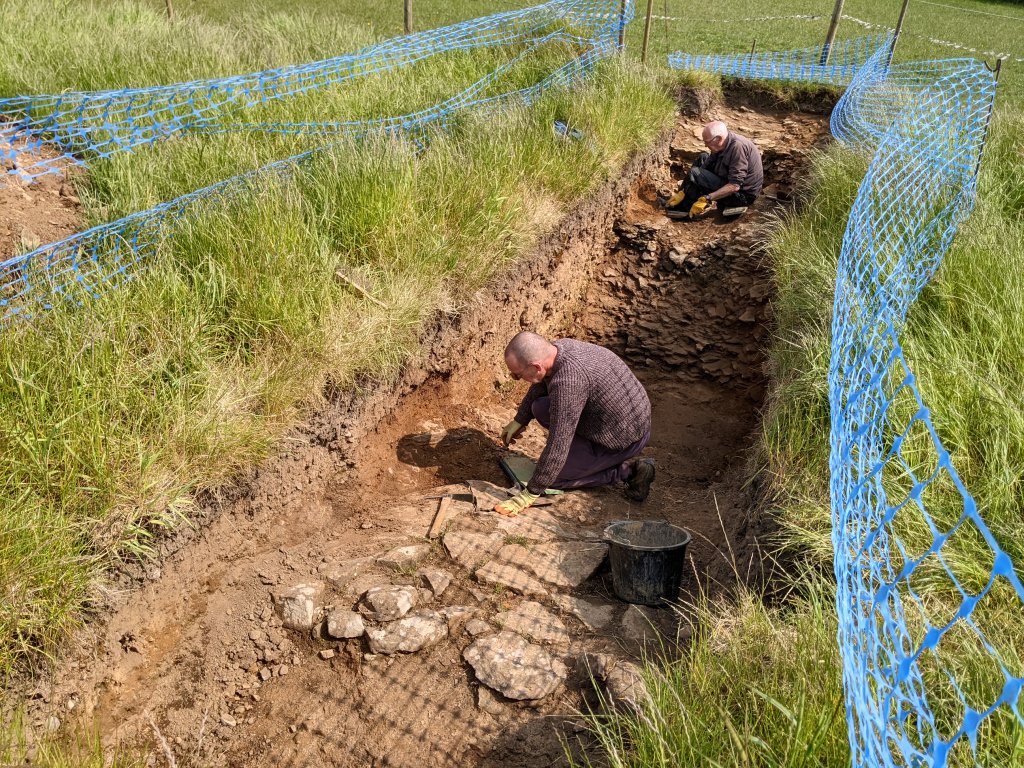
Chris continued looking at the area around Urn2 but, as the wind was disturbing the cremated bone, he decided to abandon this and recover the feature. When Roger arrived Chris tutored him in trowelling technique working in Trench 1b. When Ben arrived he continued with the task of cleaning out the bottom of Trench 5a bringing it back to the state it was in when it was first excavated. Susan and John T continued with their work on the area around the patch small stone in Trench3a SE side (F18). 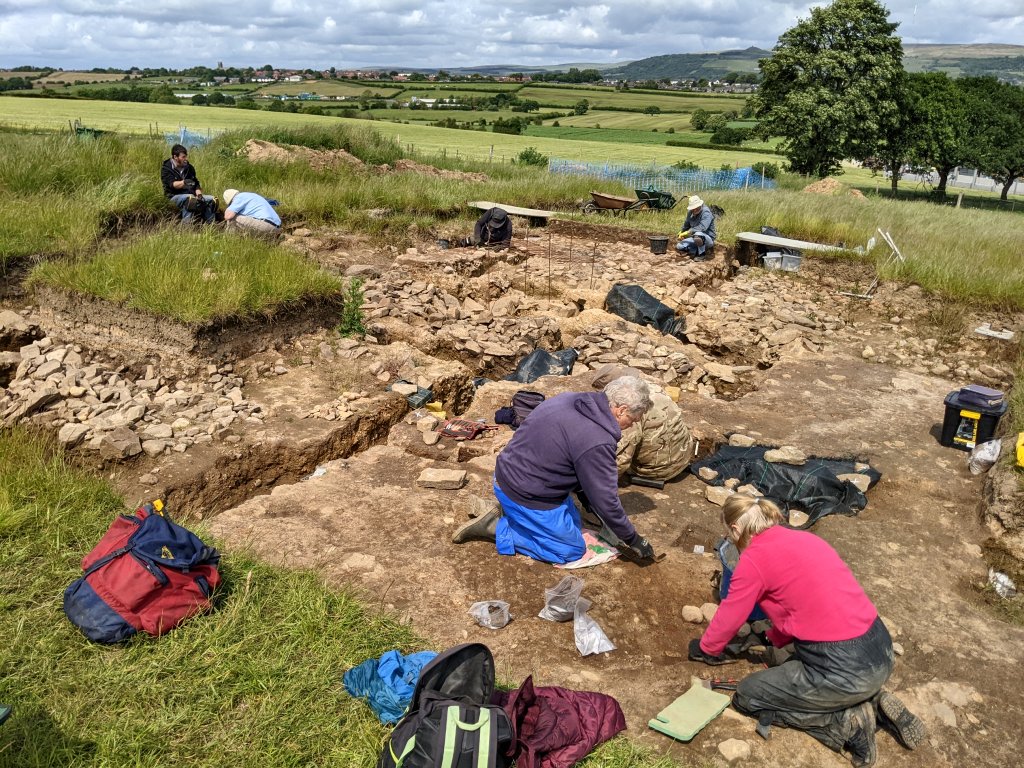 Carefully removing the stones revealed the feature to be quite shallow and, although some encouraging patterns of orange clay did emerge, there was no sign of any cremated bone to suggest this was a burial feature.
Carefully removing the stones revealed the feature to be quite shallow and, although some encouraging patterns of orange clay did emerge, there was no sign of any cremated bone to suggest this was a burial feature.
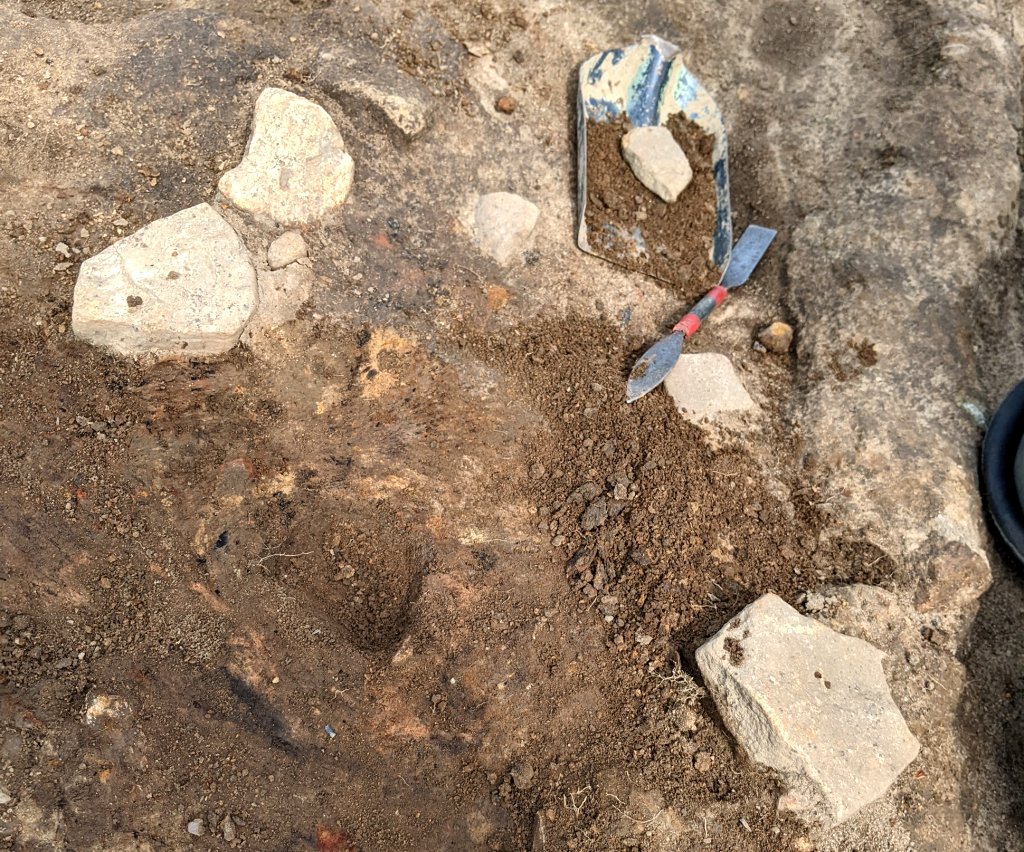
Patrick continued working on the clay-lined pit feature (F4) cutting a new section on the SE side of it. This is so that the nature of the feature’s stone base can be investigated on this side, as it seems to be rising in the interior.
Peter and Jon continued with the work in Trench 3a on the NE side (around Peg 3), trowelling off the mottled clay to reveal the stony layer underneath. 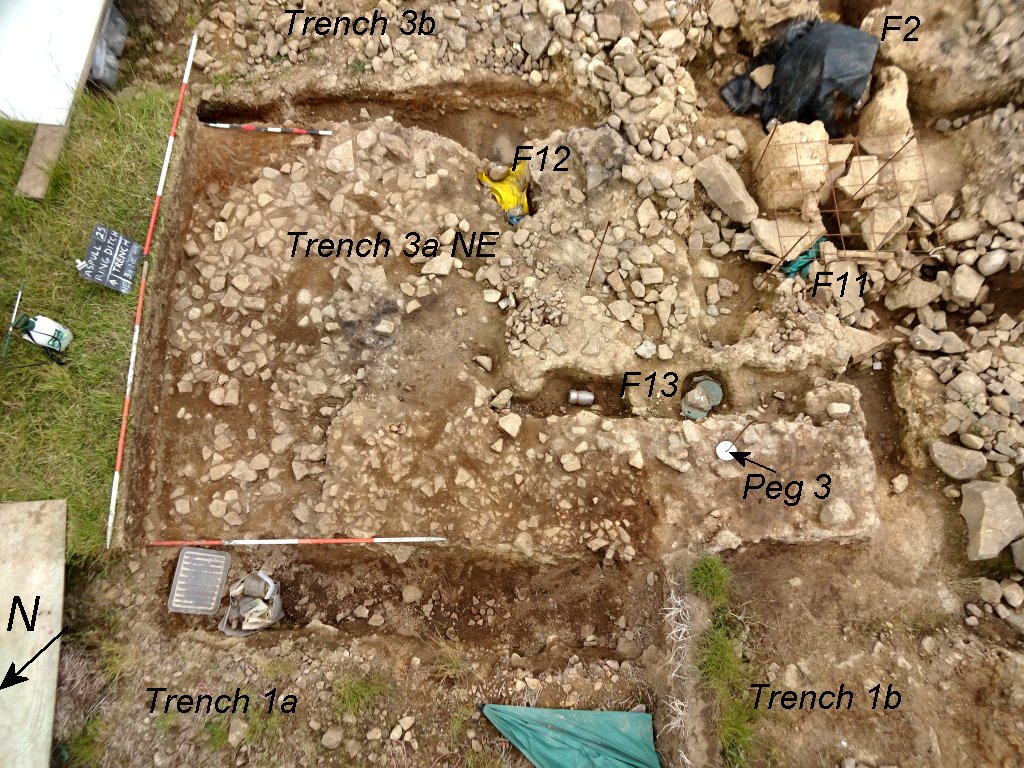
The day was abandoned slightly earlier than planned with approach of heavy rain. Bill just about managed to get his photo of Trench 6/6a in just before it arrived (which he had previously been unable to get due to the sun) – but unfortunately got a soaking exiting the site). 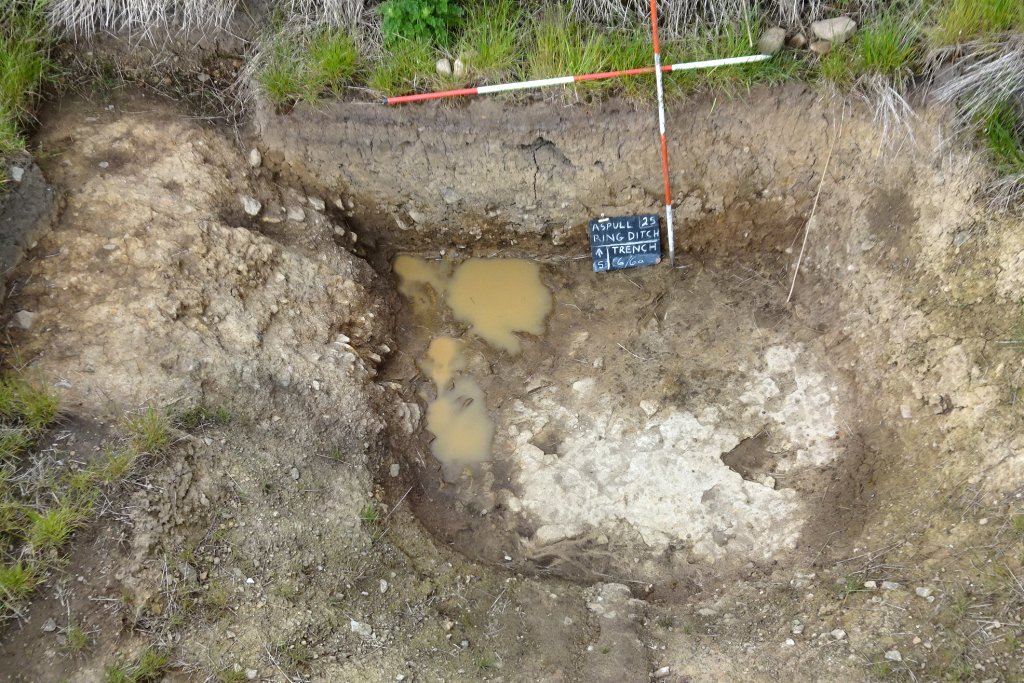
Saturday 31th May
Day 22
This visit was arranged at short notice for our friends from BHAAG in Cheshire who came to join the effort to make the whole site tidy for potential visitors (this being the last time the whole site will be visible before being backfilled at the end of the season). Joining Chris were Denise (Chris’s partner), Don and Gill Wilson and Cathy Harris.
Cathy and Don first worked on cleaning up the pit at the southern end of Trench 3 (Trench 3d).
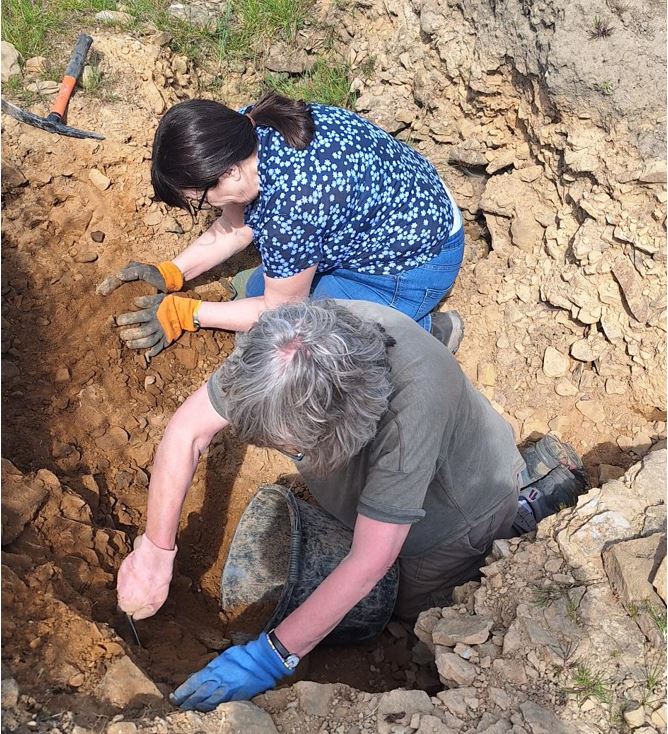
They then worked in the ditch section of Trench 3 continuing the business of tidy up its sections. 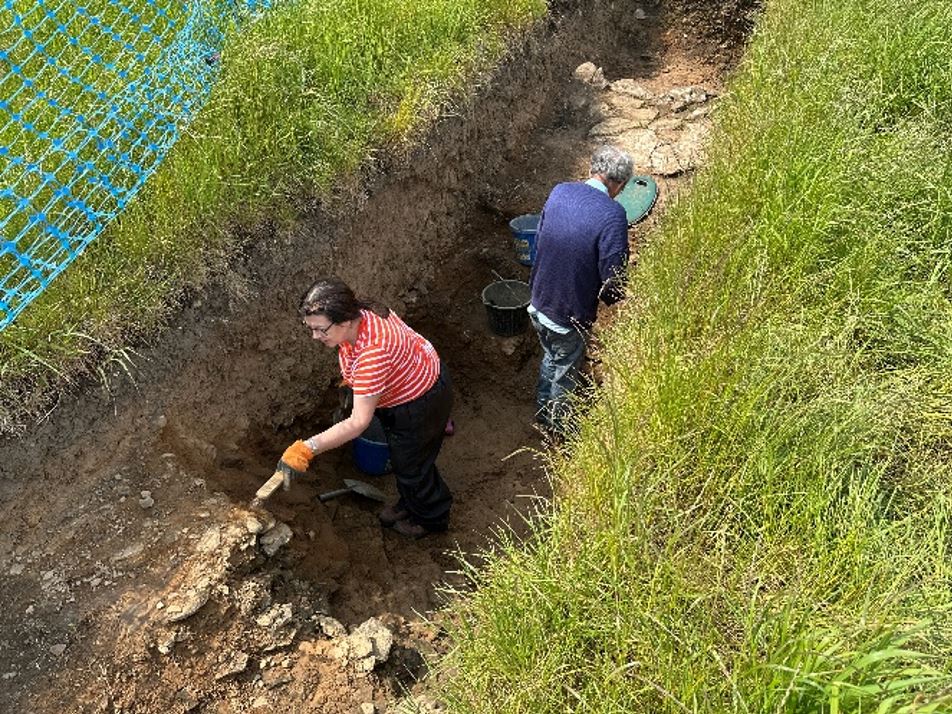
Denise and Gill helped Chris clean up the site in general by picking up loose stones that had become buried in the grass, packing burial pit fill material into new sturdier boxes and a bit of gardening. Chris continued to film the ditch trenches and the main burial features to build up a library of video footage.
Thursday 29th May
Day 21
Seven volunteers on site today (including Bill back from his hols). Joining Chris were Patrick, Peter, Rachael, Steve and Susan with Bill joining in the afternoon.
Steve spent some time finishing off the ditch in Trench 3. This in now looking very good with the bedrock clearly exposed in the sidewalls, especially on the SE side (steps have been left in on the NW side). The bedrock though on the SE side, being laminated and friable, looks to have collapsed – I suppose we will never know whether this happened when the ditch was originally dug out or had always been like that. Now that the full width of the trench has been excavated, the direction of the ditch has been revealed and it seems to be heading more to the west than we had previously assumed.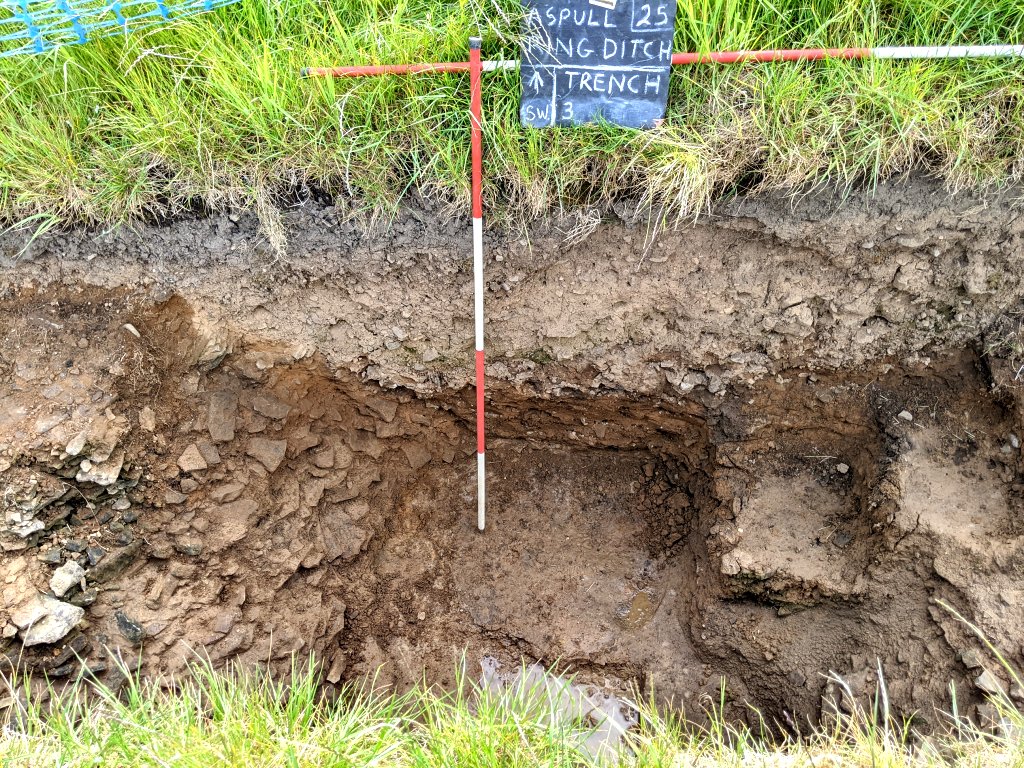
Peter continued with the work in Trench3a on the NE side, trowelling off the remaining thin layer of mottled clay on the NW side to reveal the underlying stony layer – no surprises yet but there still might be something under the stony layer. 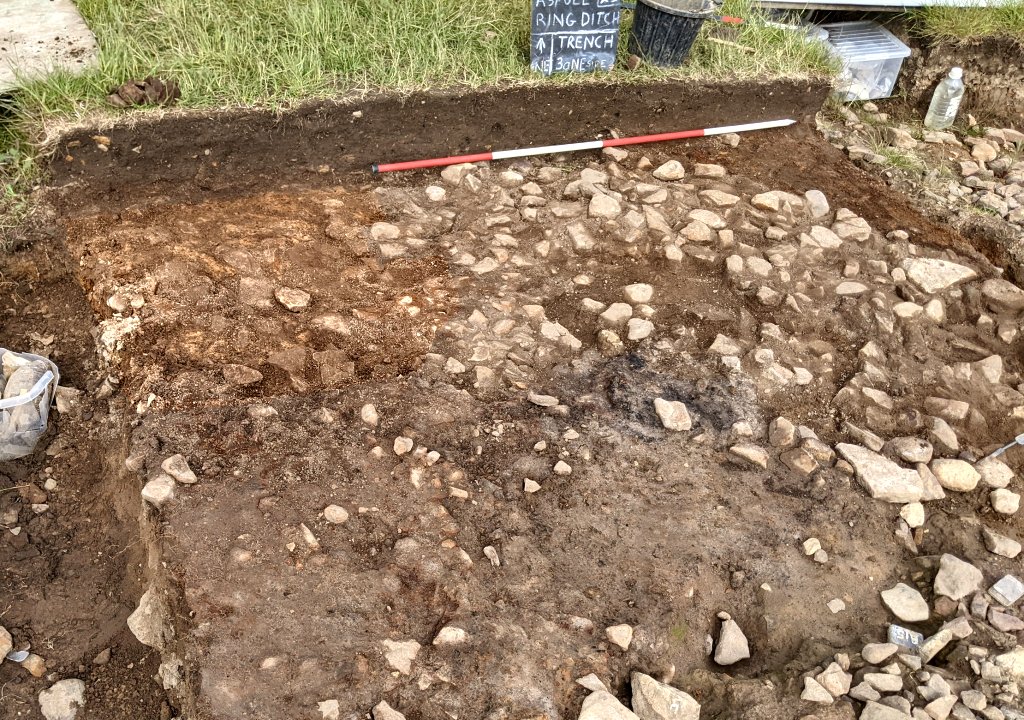
Patrick continued working on the clay-lined feature (F4). The narrow slot he cut into the side of the trench on the NE side had now reached the feature itself. The suspected original pit for the feature, which seemed to be apparent on the surface (seen in April Day 9) could just about be seen in the section. There was also signs of the hole in the side wall coming through from the interior. His slot is now deeper than the feature itself and (unlike the slot on the NW side) the stone base encountered in the interior could be seen protruding outside. 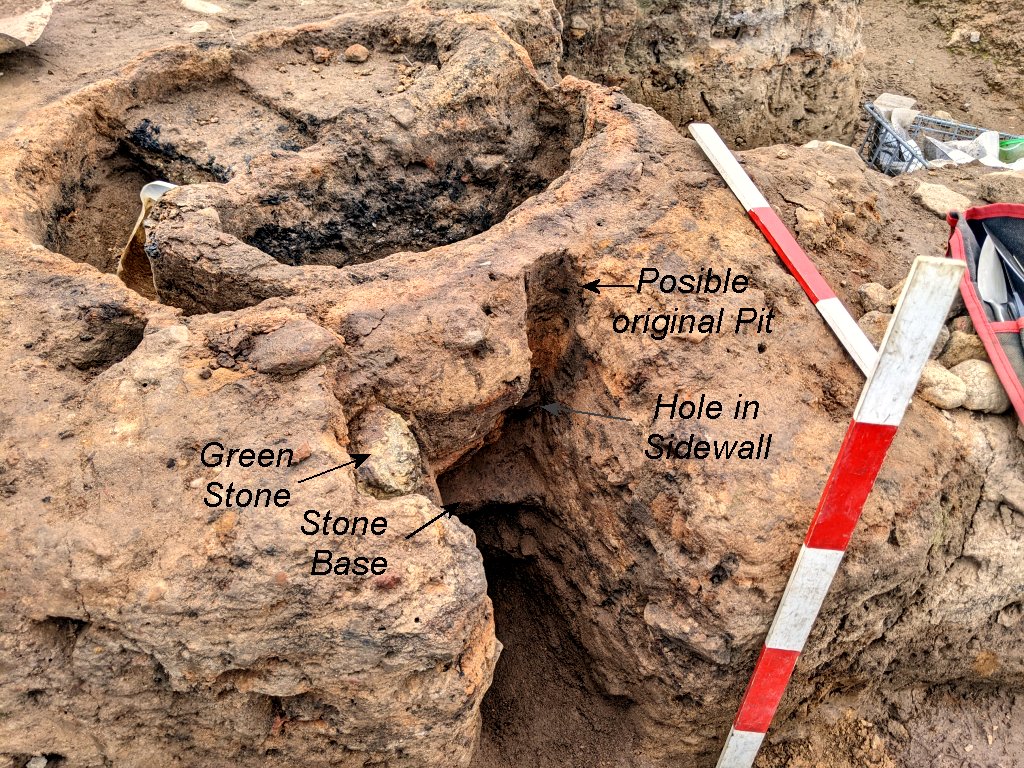 Susan continued with the work on the nearby patch of small stones embedded in the mottle clay layer (F18). Still no cremated bone but many flecks of charcoal – in fact the whole area to the NW of the feature seemed to have flecks of charcoal embedded in the mottled clay layer.
Susan continued with the work on the nearby patch of small stones embedded in the mottle clay layer (F18). Still no cremated bone but many flecks of charcoal – in fact the whole area to the NW of the feature seemed to have flecks of charcoal embedded in the mottled clay layer. 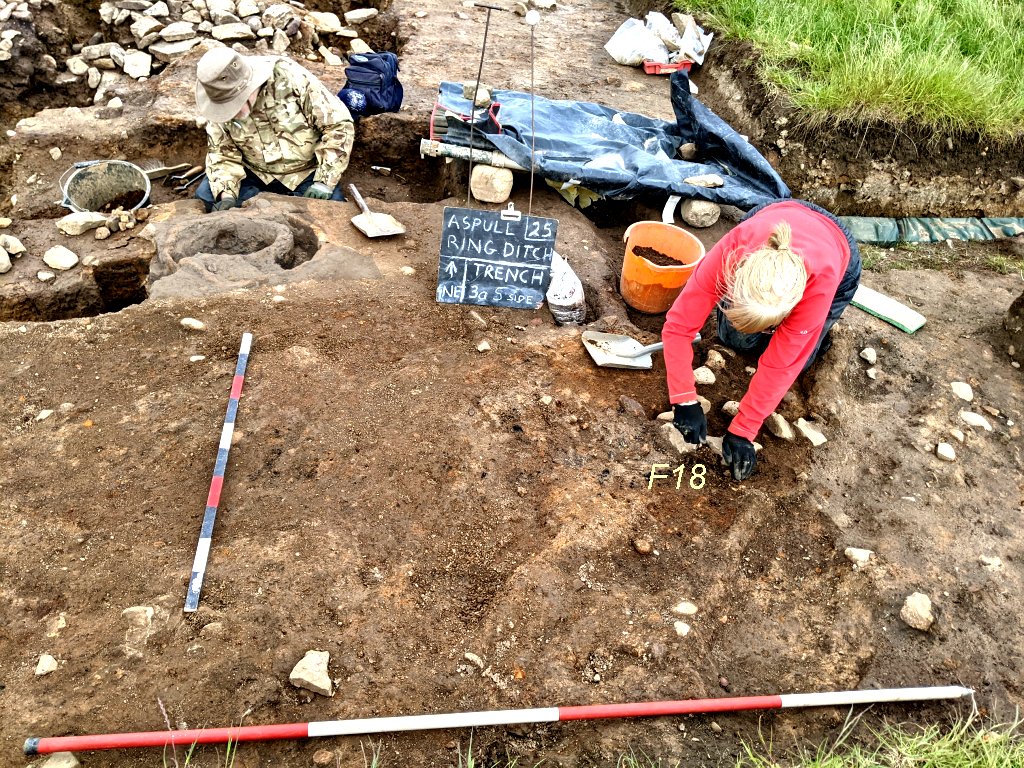
The clay layer is quite deep here so the charcoal cannot be attributed to the burning layer which lies at the bottom on this layer.
Chris continued working on the area around Urn2 (F2) slowly getting closer to the urn itself (Bill managed to retrieve the loose piece that had fallen inside the urn). As mentioned before, the layering is becoming very complicated – the only feasible explanation is that there has been a series of deposits, the urn being the last.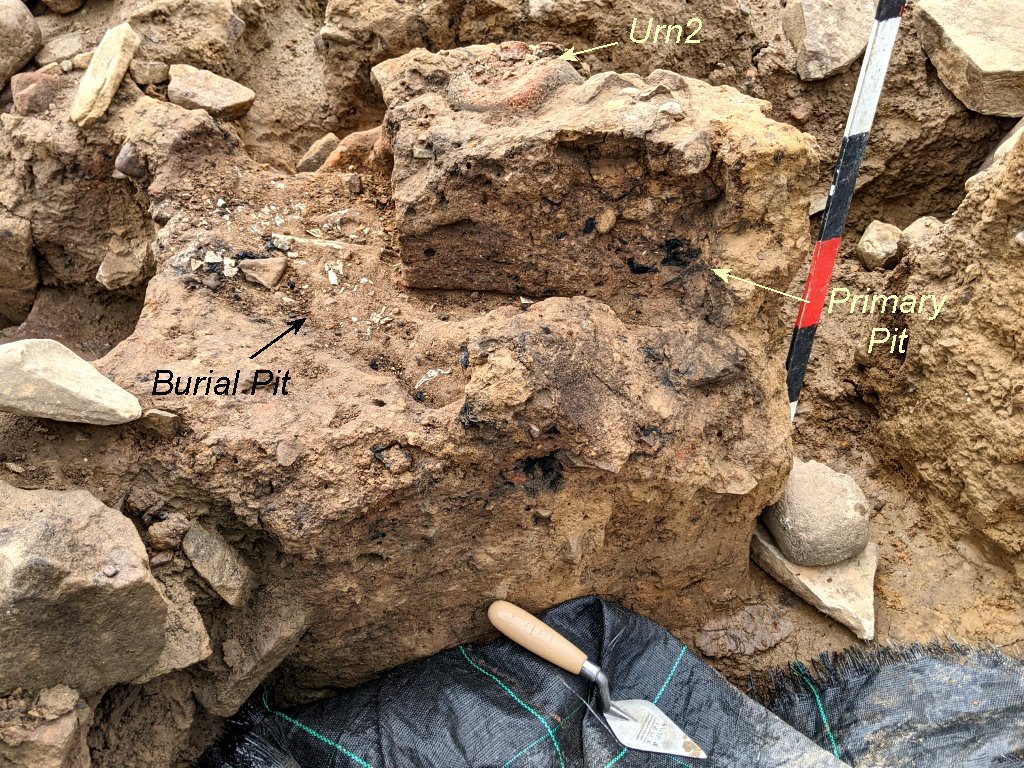 On the south side of the urn, a lump of hard orange clay is reminiscent of the orange clay lining of feature F4. Beneath this lump, and the bright clay encasing the urn, there appears to be a darker layer containing small stones (the towel is pointing north btw).
On the south side of the urn, a lump of hard orange clay is reminiscent of the orange clay lining of feature F4. Beneath this lump, and the bright clay encasing the urn, there appears to be a darker layer containing small stones (the towel is pointing north btw). 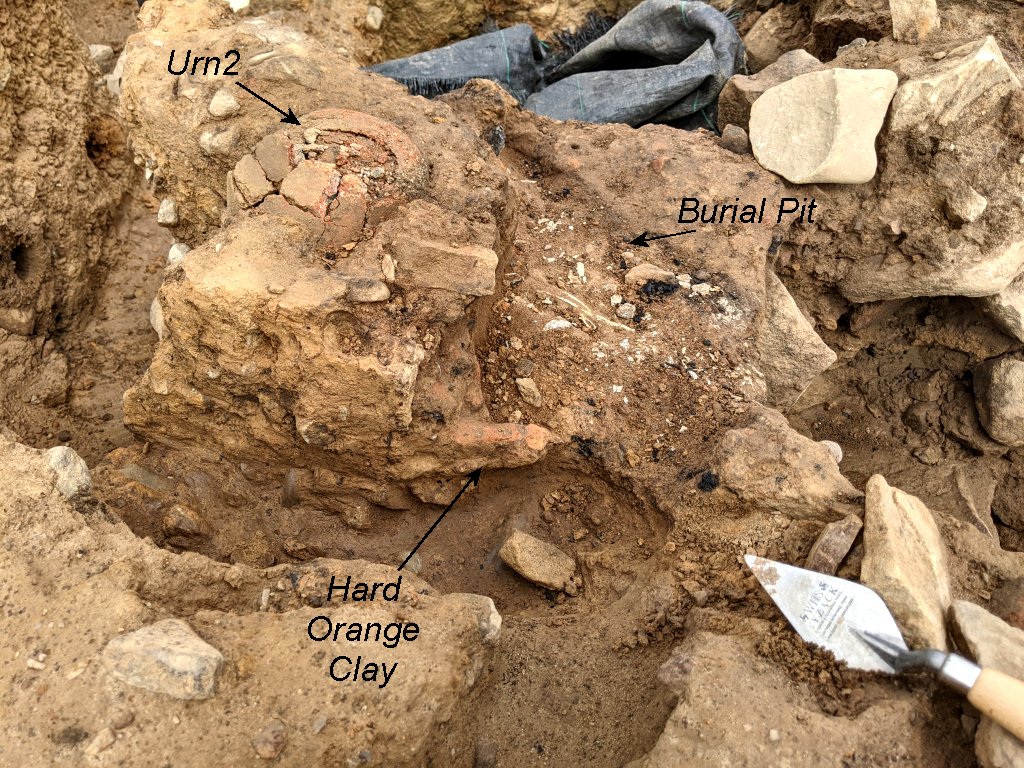
Rachael meanwhile continued with the work on the SE end of Trench 3a exposing more of the stony layer embedded in the subsoil. She was also able to extend the cut down the SW side of the trench revealing some depth to this stony layer (a similar patch was revealed in Trench 1c on the NW side going towards Trench 5. 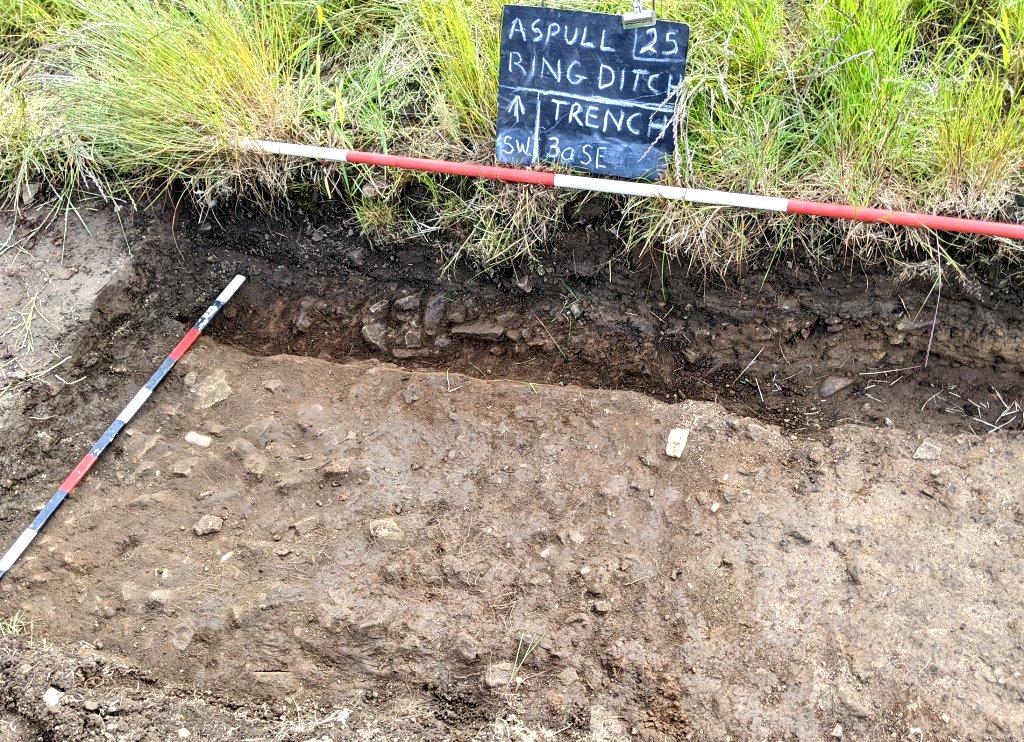
Wednesday 28th May
Day 20
Another good turnout – joining Chris today were Patrick, Susan, Peter, Jon and John Needle with David North and John Ashcroft joining at lunch time.
At last the dry weather has broken with intense rain over the weekend but this has caused its own problem. It was therefore slow start as we waited for the last of the rain to clear and the main excavation area to dry out. After removing the covers from Urn2, it was clear that the high wind had caused the urn to suffer a small collapse, with a sherd from the base of it falling inside.
Jon and Peter continued to remove the mottled layer on the newly exposed area at the NE side of Trench 3a. The curvature of the stony layer has become very distinctive and seems to be matching the slight embankment on the east side of the central sandy clay mound.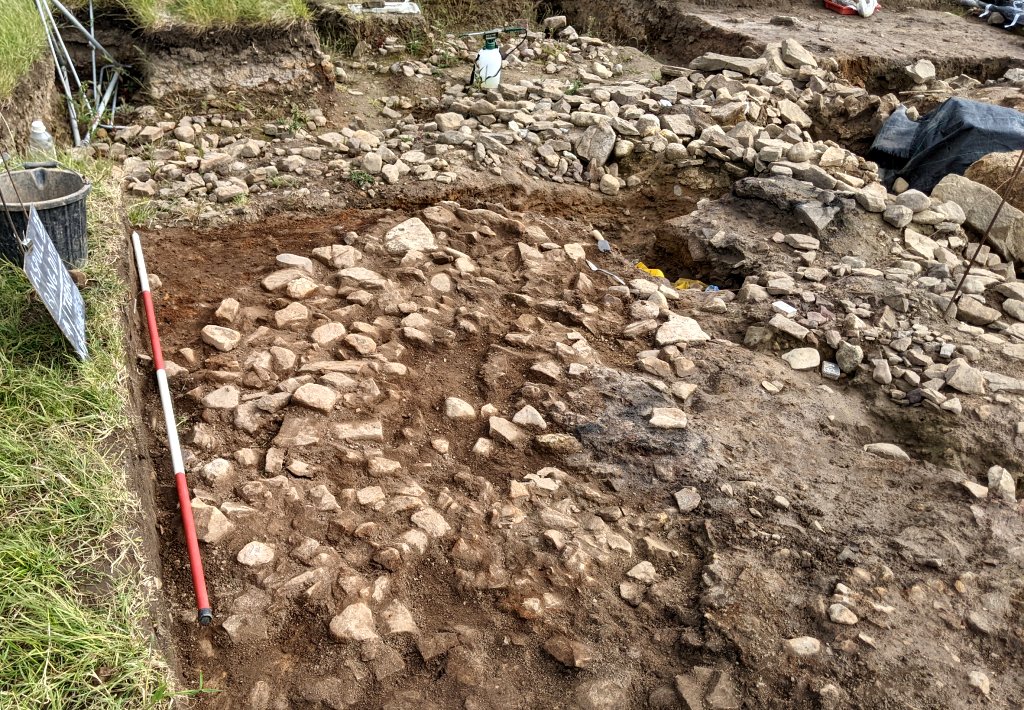
Later, when the conditions were dryer, work began cleaning the area to the west side of feature F4 and Urn1 which includes the patch of small stones embedded in the mottled clay layer (F18). 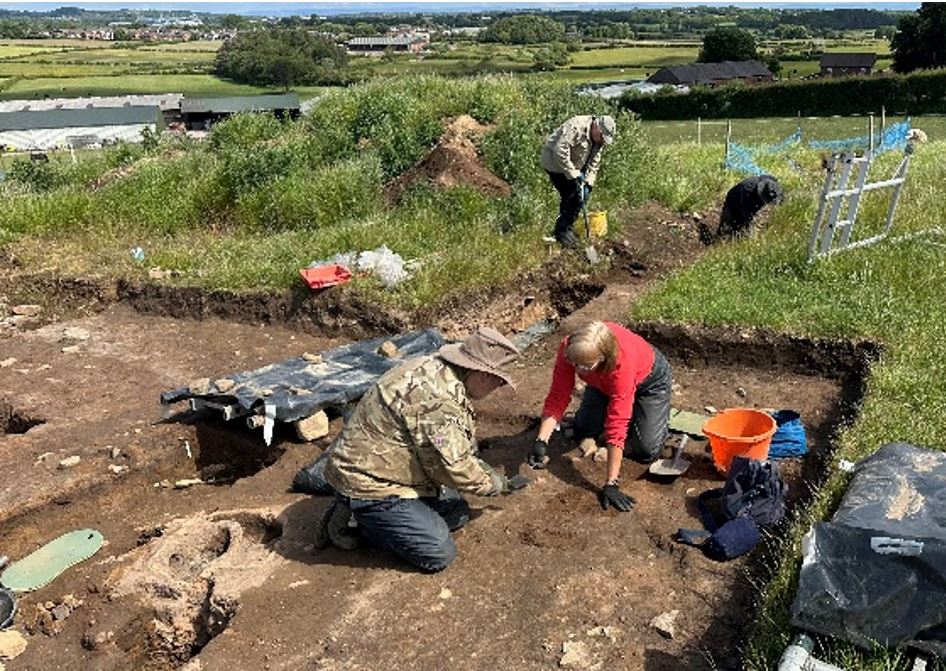
John N meanwhile continued cleaning out the bottom of the ditch in Trench 3. When John Ashcroft and Dave North arrived, John was given the task of carefully removing the 2cm layer of top soil from the SE end of Trench 3a to expose more stones. Dave meanwhile joined John N in the Trench 3 ditch and continued to expose the bedrock. 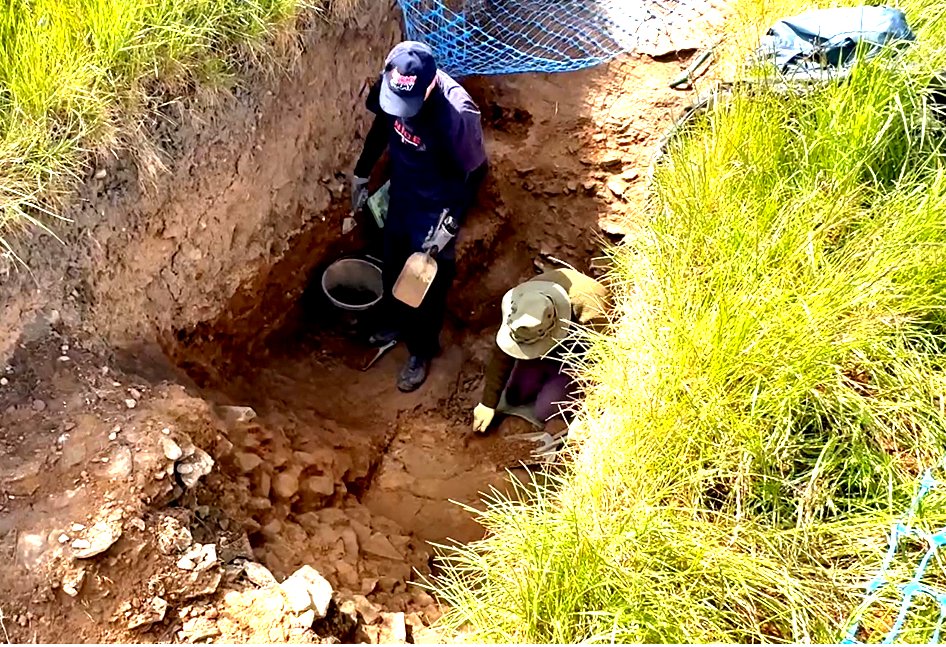
Patrick began a new excavation on the clay-lined pit feature (F4), cutting a new section from the side of the trench on the NE side. This was to investigate the possibility of a pit which could apparently be seen on the surface around the feature on that side. It was also to try and see if we could learn more about the base of the clay lining and explore the nature of the hole in the side wall.
Thursday 22th May
Day 19
A good turnout today – joining Chris were Steve, Susan, Isabel, Rachael, Peter, Patrick and John Trippier. We also welcomed three recent new starters, Alison and Jon who started the previous Week, and Roger Chapman who also had previously visited when Ben Dyson was on site. The dry weather continues but there is a forecast of rain next week.
Racheal and Alison worked with John Trippier cleaning and exploring the areas of interest in the newly exposed area to the west of Urn1 and feature F4 (southwest side of Trench 3a). John T and Alison explored a circular patch of stones and the area around them (designated F18). There are flecks of charcoal around the edge of this area, but as yet, no sign of any cremated bone (more work to be done here). Racheal defined an oval area containing flecks of charcoal and a small amount of cremated bone before half sectioning it. This area proved to be shallow so maybe only the bottom of a feature (now designated F19). 
Steve and Isabel continued to clean the ditch in Trench 3. Working on the unexcavated southwest side of the trench, a new grey clay layer was exposed at the bottom of the ditch under a block of ditch fill that had not been worked on before. They carefully worked their way to the bedrock wall of the ditch on the other side of which is the ‘pit’ (Trench 3d) that our colleagues from the Border Heritage Group have been digging on Saturdays. 
Roger and Patrick joined Peter removing the mottled clay layer from all the newly de-turfed area at the northeast side of Trench 3a, exposing the stony layer below the burning layer. On the northeast edge of this area, working across at a level, the stones disappear. It’s not a feature though, or an edge, as the stony layer is sloping down (as can been seen in the section). 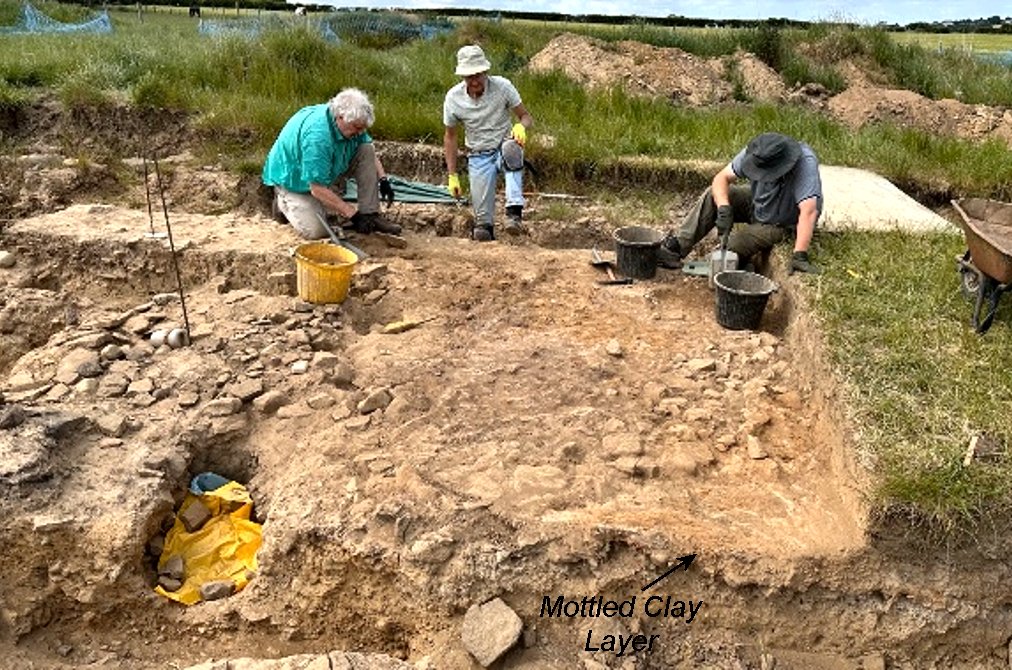
Chris and Susan continued to work on the preparation for the block lifting of Urn2. We now have two sides of the block at level 5cm below the rim of the urn (the urn is inverted). Next week we need to tackle the two other sides, which have the layer of bones to deal with, which will complete the bulk of the preparation for the lifting. 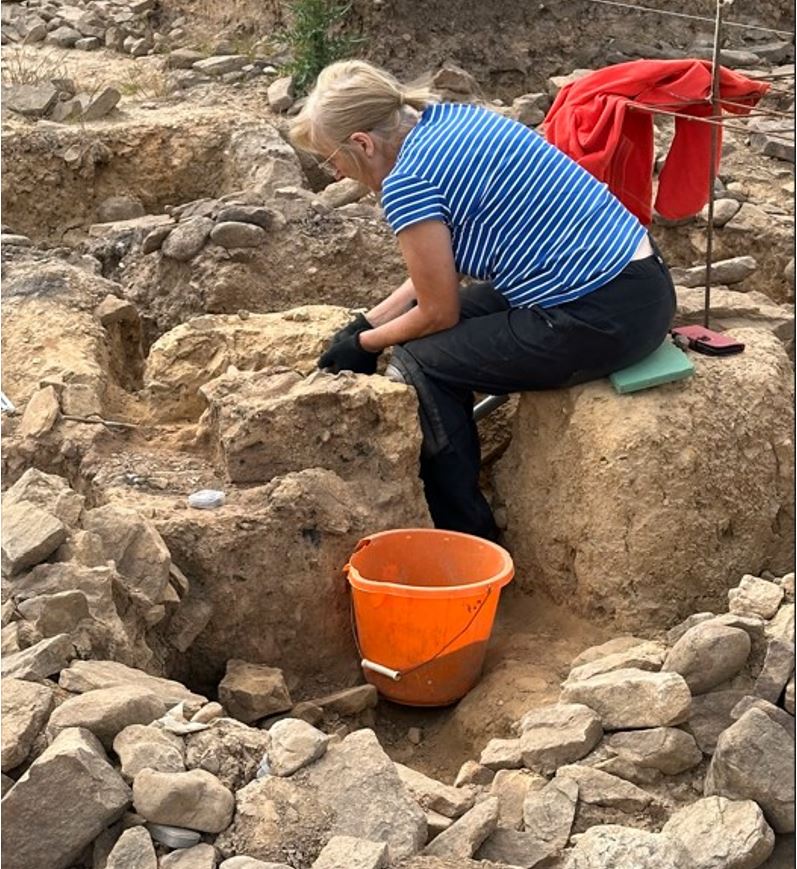
Chris conducted a drone survey of the entire site (first of the year, as the central area has been the focus of interest this year) to show the clean ditches. 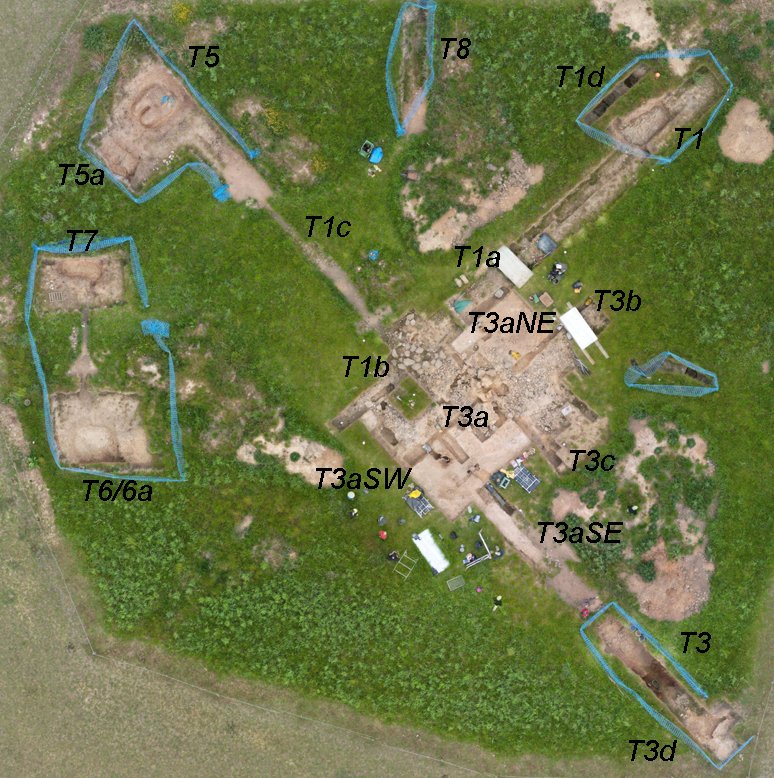
Tuesday 20th May
Day 18
Only four on site today, with on his hols (again) Chris was in charge. Joining him were Colin, Steve and Susan Rimmer from the Merseyside Arch Soc.
Work continuing tidying up the site including cleaning out two years’ worth of weathering in the ditch trenches. A bit of gardening required as well. After completing the initial clean up on the ditch in Trench 5, Colin and Steve moved over to Trench 3 to begin working there. 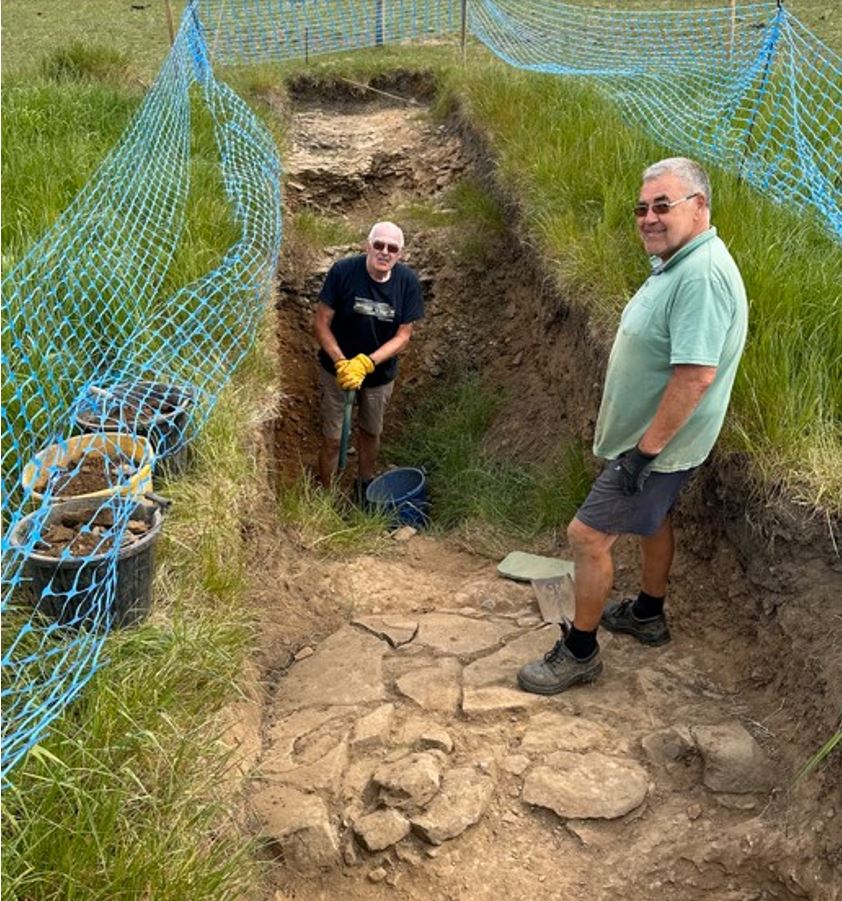
Chris and Susan continued to slowly, but steadily, work around Urn2 to prepare the area for lifting which is planned for next month. The intention is to work around the outside of the urn, which is clearly in poor condition, so that we can lift the block of material its encased in. 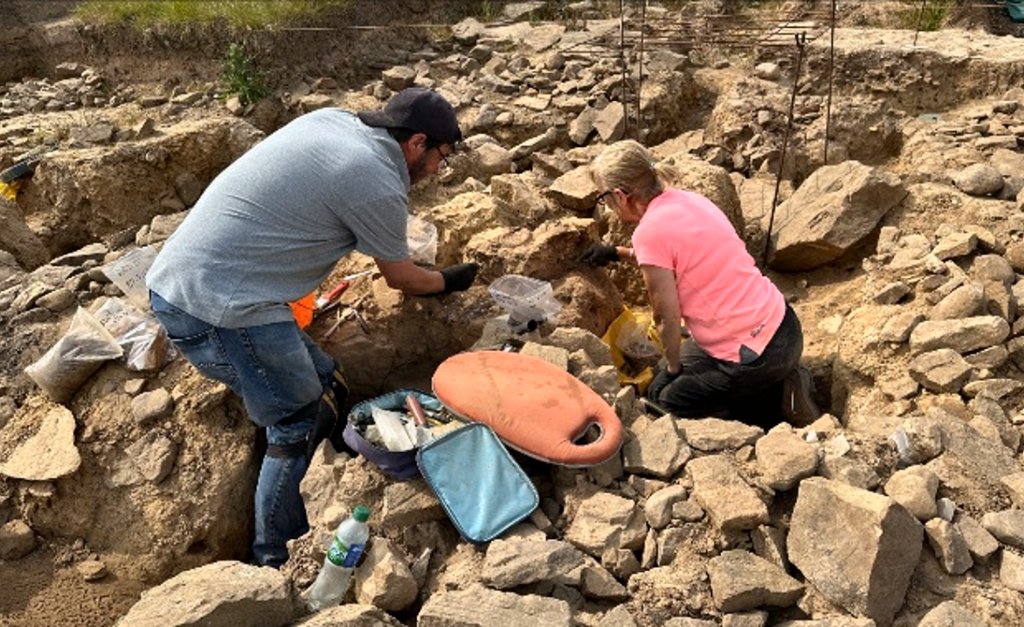 As always, the task becomes more complex as the work progresses. In now looks like we have a burial (possibly the contents of the urn) running under the urn in a fine grey sand. However, there is a harder layer above it that has charcoal in it as well as some cremated bone, with another firmer layer above that with no bone in, but some charcoal.
As always, the task becomes more complex as the work progresses. In now looks like we have a burial (possibly the contents of the urn) running under the urn in a fine grey sand. However, there is a harder layer above it that has charcoal in it as well as some cremated bone, with another firmer layer above that with no bone in, but some charcoal. 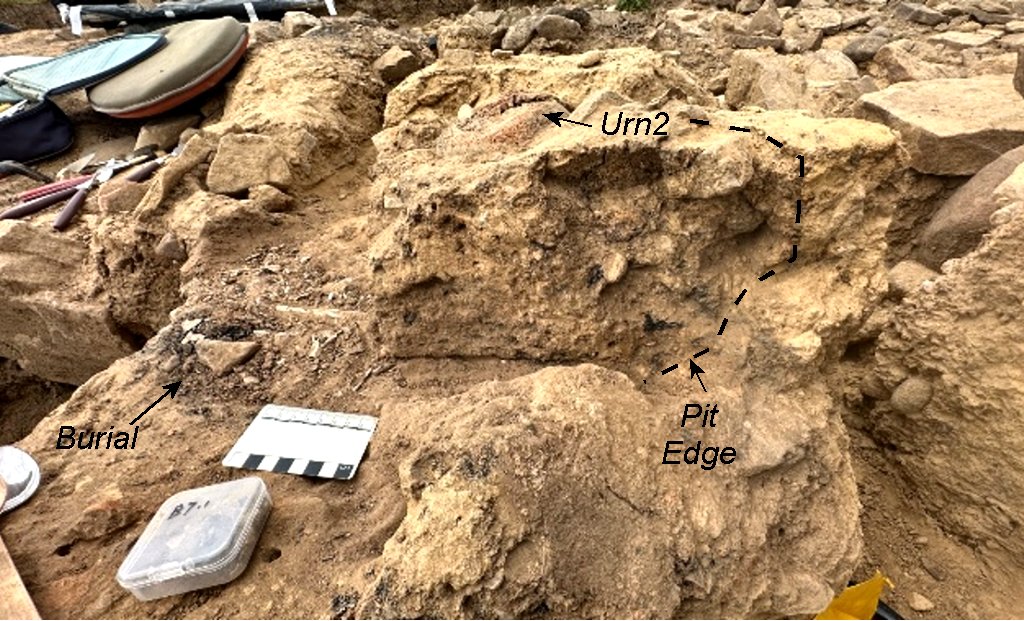 However this upper layer seems to be the one which has Urn2 encased in it (very strange).
However this upper layer seems to be the one which has Urn2 encased in it (very strange).
Thursday 15th May
Day 17
Good turnout today, joining Bill and Chris were Steve, Colin, Isabel, Francesca and new volunteer Jon Shelley (another volunteer from the Merseyside Arch. Soc.) – with Ben Goodburn and John Trippier arriving later in the morning.
We were also blessed with a visit form Ian Miller from GMAAS who was once again very impressed with our work. After having discussed our plans with him, he agreed they seemed to be the right ones. There was certainly a sufficient case for the removal of the burials as they could not be protected from future plough damage (something Historic England might might be concerned about once they became aware of the site’s importance). Only thing different Ian suggested, would be that we should excavate Urn1 in situ, well most of it anyway. That would relieve most of the pressure on the vessel wall and therefore more likely that we would be able to extract it in one piece. He also mentioned that he knew somebody at Historic England that dealt with environmental sampling, who would be able to give advice on what to do with all the fill from the burials pits we had accumulated.
While we were showing Ian around, work continued on the site. Peter worked on the newly exposed mottled clay layer on the NE side of Trench 3a, helped by new starter Jon. Squaring up the section revealed that the mottled clay was extremely thin in this area so that the underlying stony layer soon came through. This though suddenly changed at the SE side of this area, the mottled clay becoming immediately thicker which was evident in the section cut along its SE edge.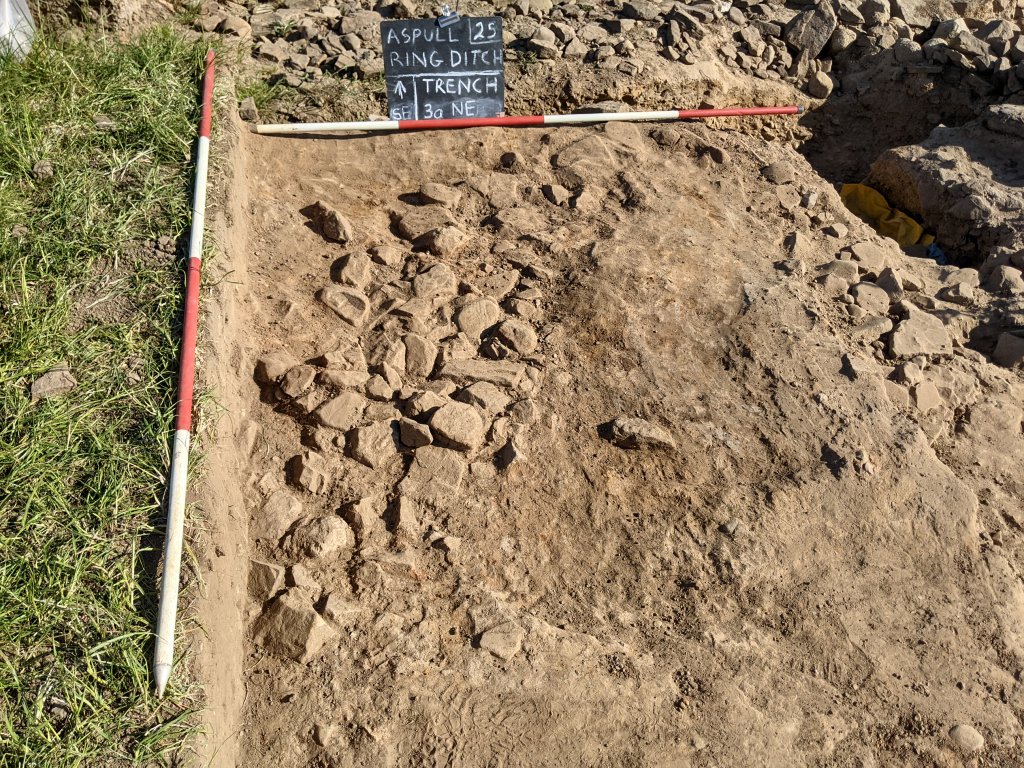
Steve finished off clearing the bottom of Trench 7 and was able to show some bedrock in the side wall on the east side. 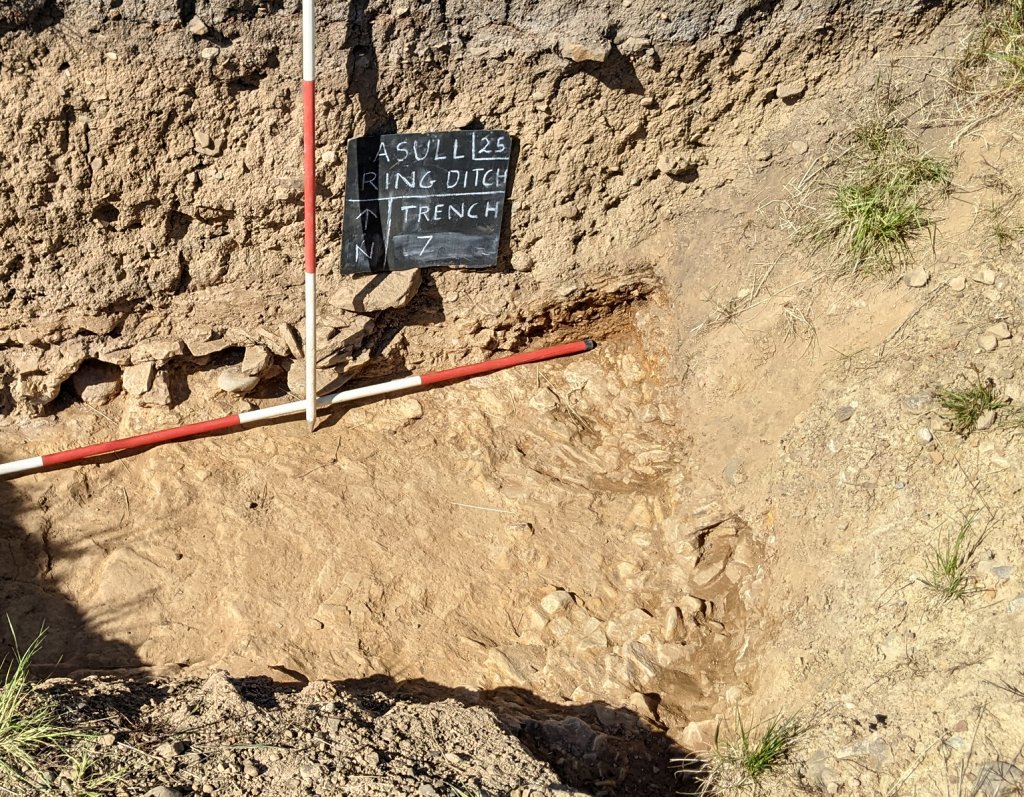 Steve then went on to work on cleaning up Trench 5, joining Ben who was already working in Trench 5a. Isabel and and Francesca worked in the original Trench 3, clearing out the vegetation and soil that had washed in on its NW side. Here the bedrock ends suddenly revealing a thick layer of soft sandy clay lying on top of a compacted stony layer.
Steve then went on to work on cleaning up Trench 5, joining Ben who was already working in Trench 5a. Isabel and and Francesca worked in the original Trench 3, clearing out the vegetation and soil that had washed in on its NW side. Here the bedrock ends suddenly revealing a thick layer of soft sandy clay lying on top of a compacted stony layer. 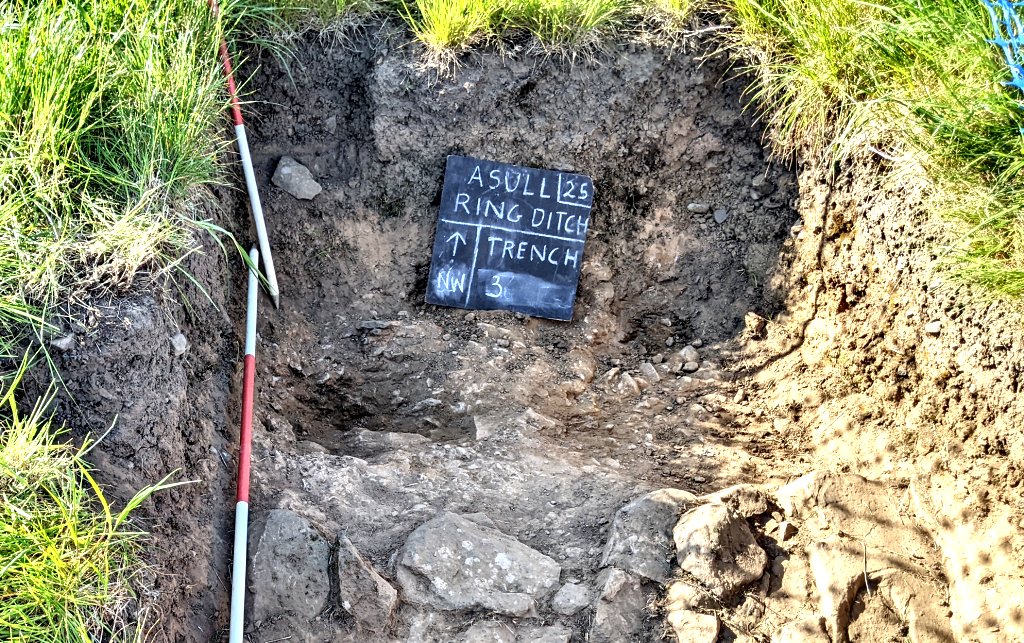 All our ditch trenches are now looking quite respectable, ready for all the coming visitors expected for this, perhaps our final year when they will be exposed for the last time.
All our ditch trenches are now looking quite respectable, ready for all the coming visitors expected for this, perhaps our final year when they will be exposed for the last time.
John Trippier meanwhile continued expanding the section at the SE end of Trench 3a towards the original Trench 3. This showed that the patch of small stones uncovered at the very end of the trench could be seen in the section and therefore extends beyond the trench. John speculated about it being a possible path running around the outside of the central area (a similar patch had been found in Trench 1c on the NW side). 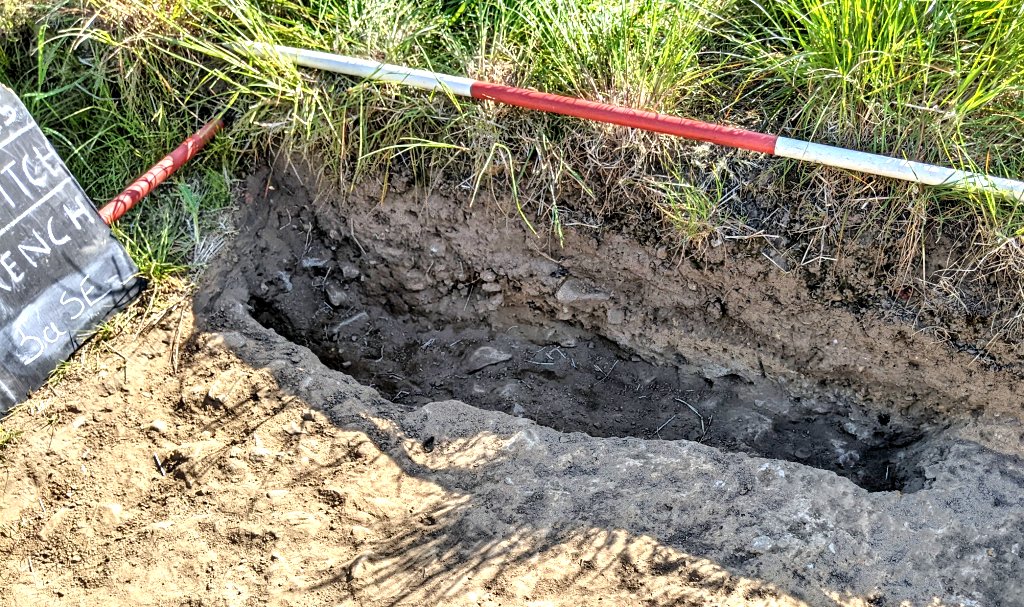 However, as with the other stones, these where lying just under the plough soil and seem to be embedded in the subsoil, so likely to be much younger than the other features of our monument.
However, as with the other stones, these where lying just under the plough soil and seem to be embedded in the subsoil, so likely to be much younger than the other features of our monument.
After Ian had left Chris continued his work on the area around Urn2 (F2). Ian had agreed that it may be possible to block lift the urn encased in the hardened clay. With that in mind Chris got to work cutting through the clay on either side of the urn. The overall feature though is getting very complicated – it is obvious the cremated bone lies in a secondary cut which seemed to be running under the urn. However the urn itself seems to be in the primary cut which doesn’t make sense (hopefully this issue will be resolved as Chris gets closer to the urn).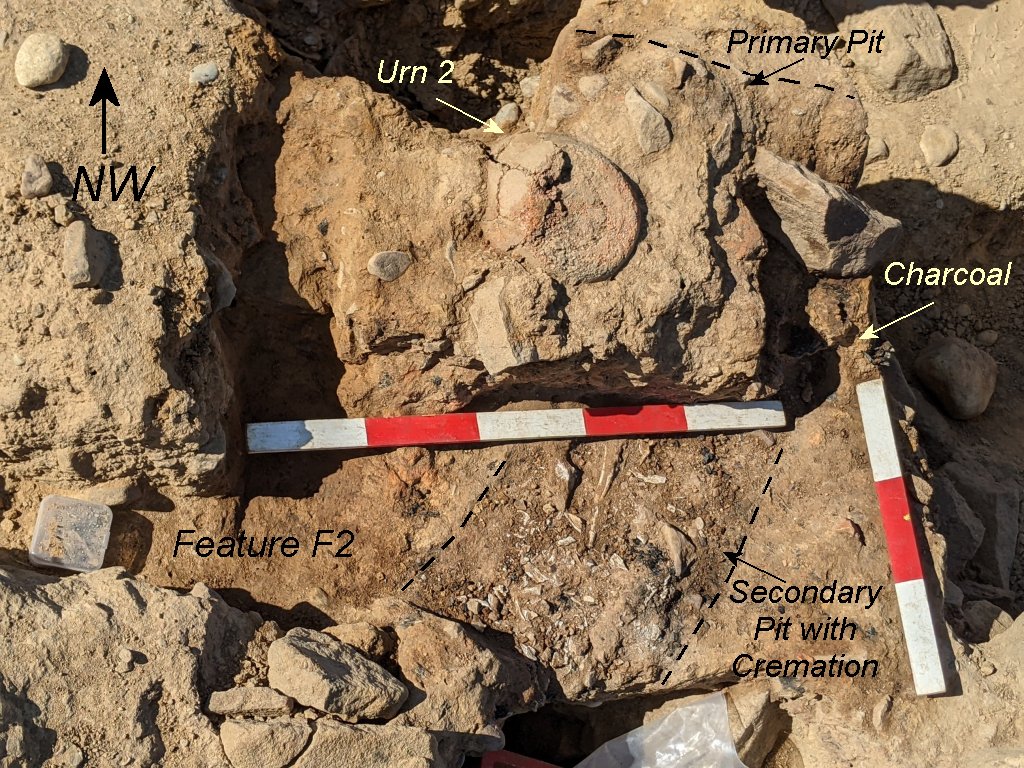
Bill meanwhile continued working on the area to the SW side of the cist feature (F11). He managed to draw the section as far has the depth of his excavations (this to be added to as more of the feature is revealed).
Before leaving for the day Bill made a start on excavating and bagging the material of the pit which could be seen surrounding Urn1 on the NW side. 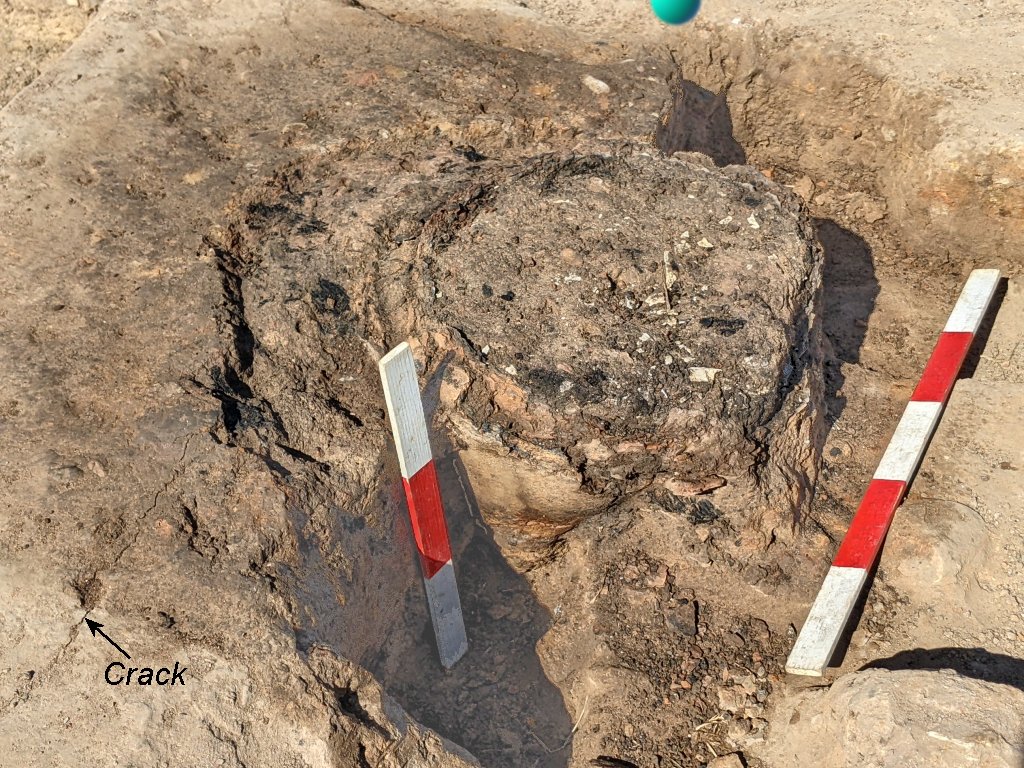 As he was doing this he noticed that in the surrounding sandy clay was showing signs of cracking as a result of the hot sun together with the persistent drying wind. This was also true of the clay around the clay-lined pit feature (F4) which had been uncovered for Ian’s visit. He therefore gave both features a good watering before replacing the covers in the hope it would stop any further potential damage.
As he was doing this he noticed that in the surrounding sandy clay was showing signs of cracking as a result of the hot sun together with the persistent drying wind. This was also true of the clay around the clay-lined pit feature (F4) which had been uncovered for Ian’s visit. He therefore gave both features a good watering before replacing the covers in the hope it would stop any further potential damage.
Tuesday 13th May
Day 16
Joining Bill and Chris today were Andrew, Steve and Colin with Ben Goodburn joining just before lunch.
Colin and Andrew started right away stripping back more turf from the northeast side of Trench 3a. Once the was done they trowelled the surface to reveal the mottled clay layer. Here the mottled clay layer is quite thin and pretty soon the underlying stones soon started to poke through.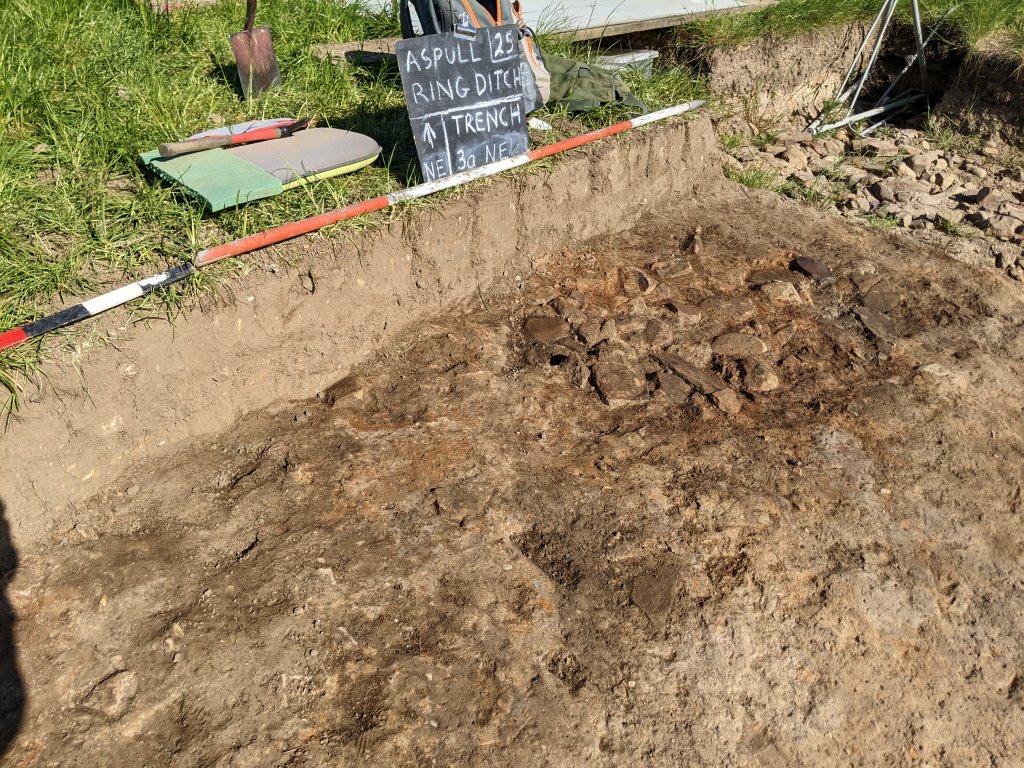
Steve continued his work on the ditch terminus in Trench 7 removing the remaining material that had washed in. Chris said when this trench was first excavated, bedrock had appeared in the south side terminal wall which he was hoping Steve would be able to establish again. By the end of the day the terminus was looking it had in the early days of 2023 when the base of it was first revealed (particularly Day8). This includes the fissure on the east side cutting into the south wall and bedrock on this wall but only for about 20cm up. 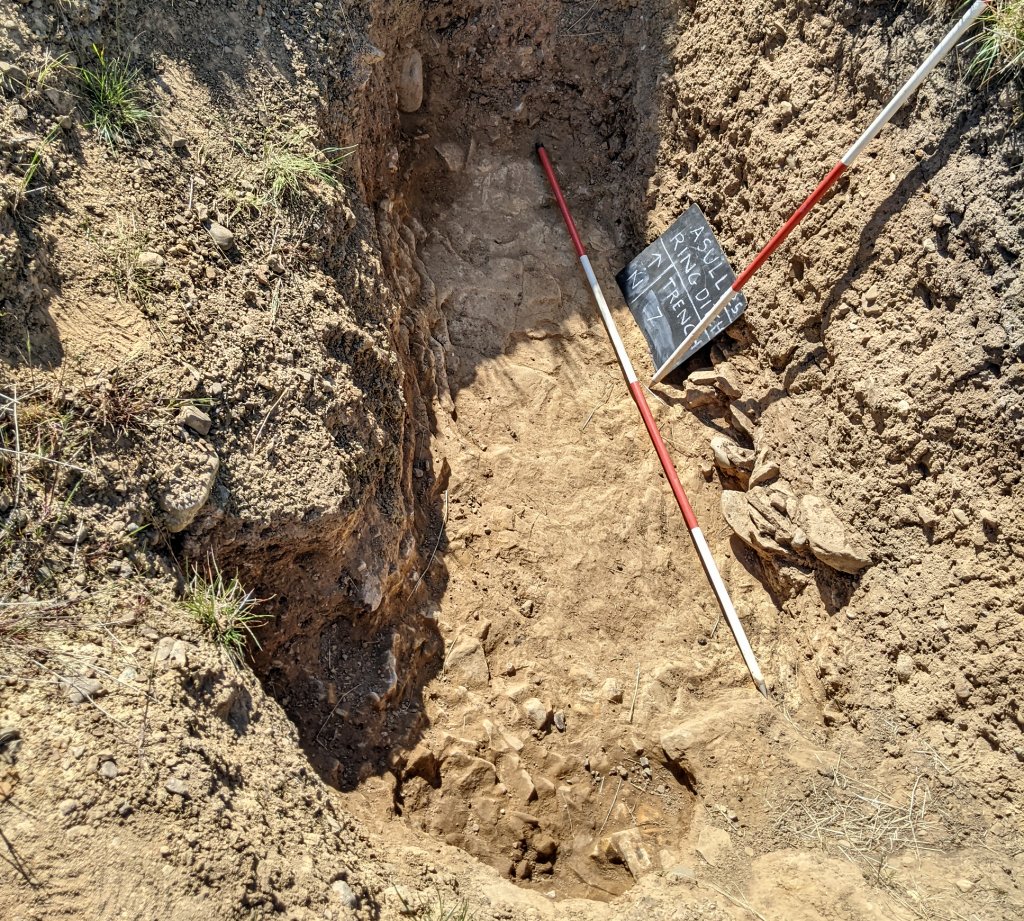
Saturday 10th May
Day 15
Today was planned for the Border Heritage Group but circumstances meant that they couldn’t attend. However we took the opportunity to use the day for volunteers who can’t normally join us during the week. So joining Bill Chris, Andrew and John Trippier today were Chris’s partner Denise German and new to the site Vanessa Oakden. Later in the day we were joined by new starters James Fildes and Alison Winnard.
As we are now at the beginning of the process of removing the burial material, we also took the opportunity to invite Society members to see the site for themselves whilst the burials are still in situ. All through the day therefore we had a stream of visitors and Bill and Chris took turns in showing them around the site (visitors included Christine Barbour-Moore, Tim and Jan McVoy, Darren Bentham, Christine Bennett, Eddie Estlin, Rob and Judith Lawson). All were suitably impressed with the site and our work there, many commenting that only when you get on site do you appreciate its scale.
Whilst the visitors were being shown around work continued with the new starters Vanessa, Alison and James trowelling the newly exposed mottle clay surface on the northeast side of Trench 3a. Chris continued excavating the pit next to Urn2 (F2) and came across a large piece of charcoal which had some structure to it (to be excavated next time).
Andrew was tasked with having a closer look at the section cut adjacent to our burial feature (F12). Collections of small stones were appearing in the side wall of this cut on the SE side and Andrew was able to show they were appearing in both sides of the cut (difficult to see in the photo)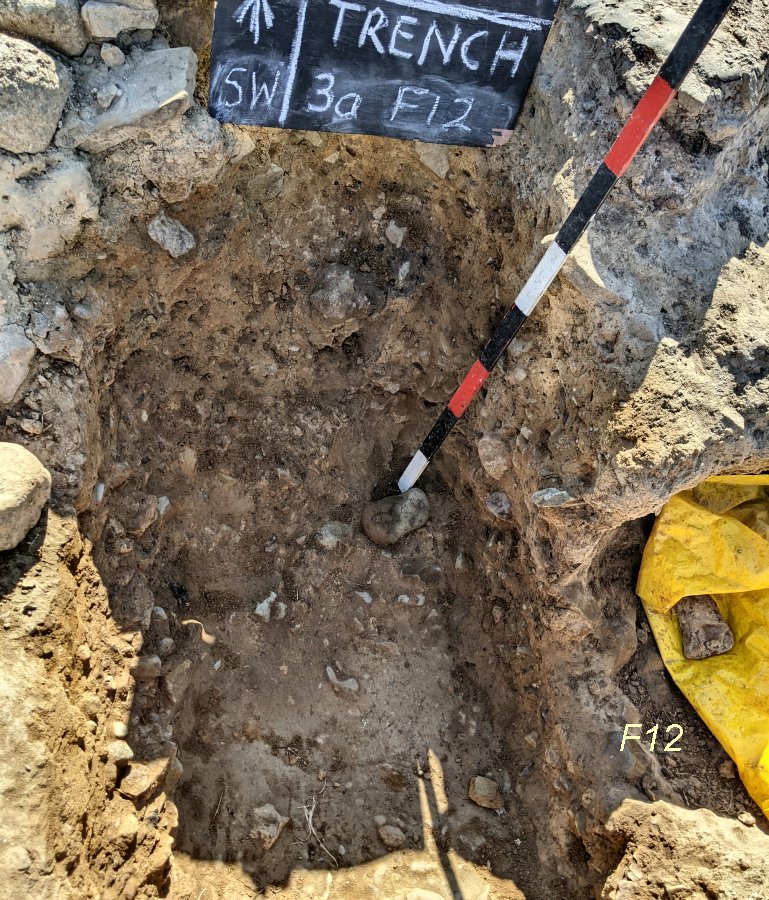 . The stones are a similar size to the ones found in the pit of the burial. It is therefore possible that the pit is much large than we originally thought with the stones going right under the cremated bone cache.
. The stones are a similar size to the ones found in the pit of the burial. It is therefore possible that the pit is much large than we originally thought with the stones going right under the cremated bone cache.
John Trippier meanwhile continued investigating the SE end of Trench 3a where a patch small stone where showing just below the plough soil. By excavating the SW side of the trench John seemed to be able to establish that the mottled clay layer terminated at that point. 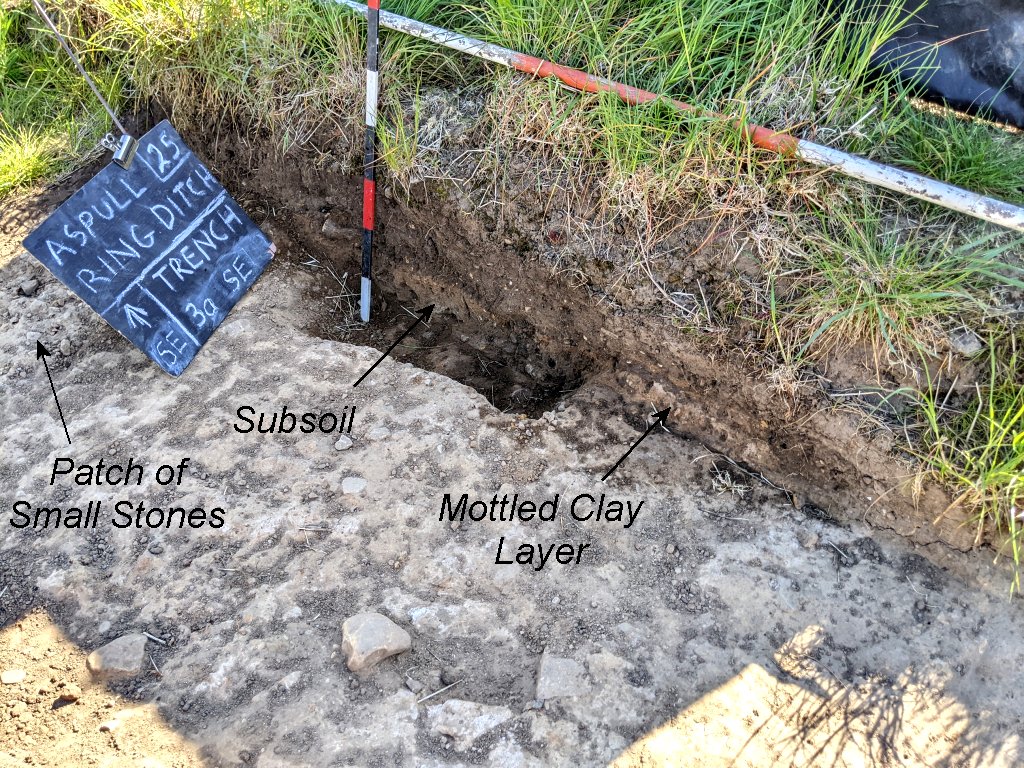 Therefore the small stones must be in the subsoil.
Therefore the small stones must be in the subsoil.
Thursday 8th May
Day 14
No Bill today so Chris was in charge. Joining him were Colin, Steve, Rachael and Francesca.
Chris wanted to conduct a full drone survey of all the recently opened areas in one shot at lunchtime. Rachel and Francesca therefore were tasked with light trowelling all the open areas on the northeast side of Trench 3a, whilst Chris, Colin and Steve cleaned back all the newly opened areas on the southwest side of Trench 3a. 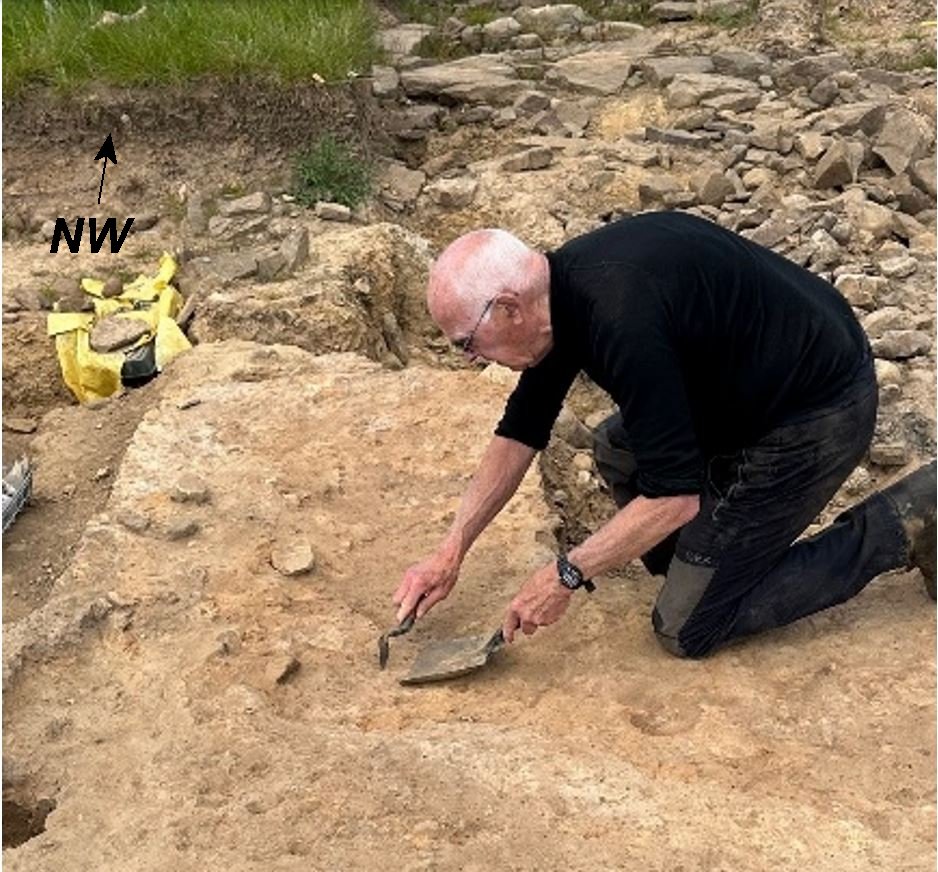 The recent lack of any rain meant that the surfaces have been baked hard making this task quite difficult.
The recent lack of any rain meant that the surfaces have been baked hard making this task quite difficult.
When the new areas were clean, Chris allocated the team to tidy up the main burial features. Colin cleaned the clay lined pit burial (F4), Steve cleaned Urn1 (F1) and the area around it while Chris cleaned Urn2 (F2) and the newly discovered collection of cremated bone. Rachael and Francesca meanwhile cleaned around the burial pit that lay under the flat stone (F12).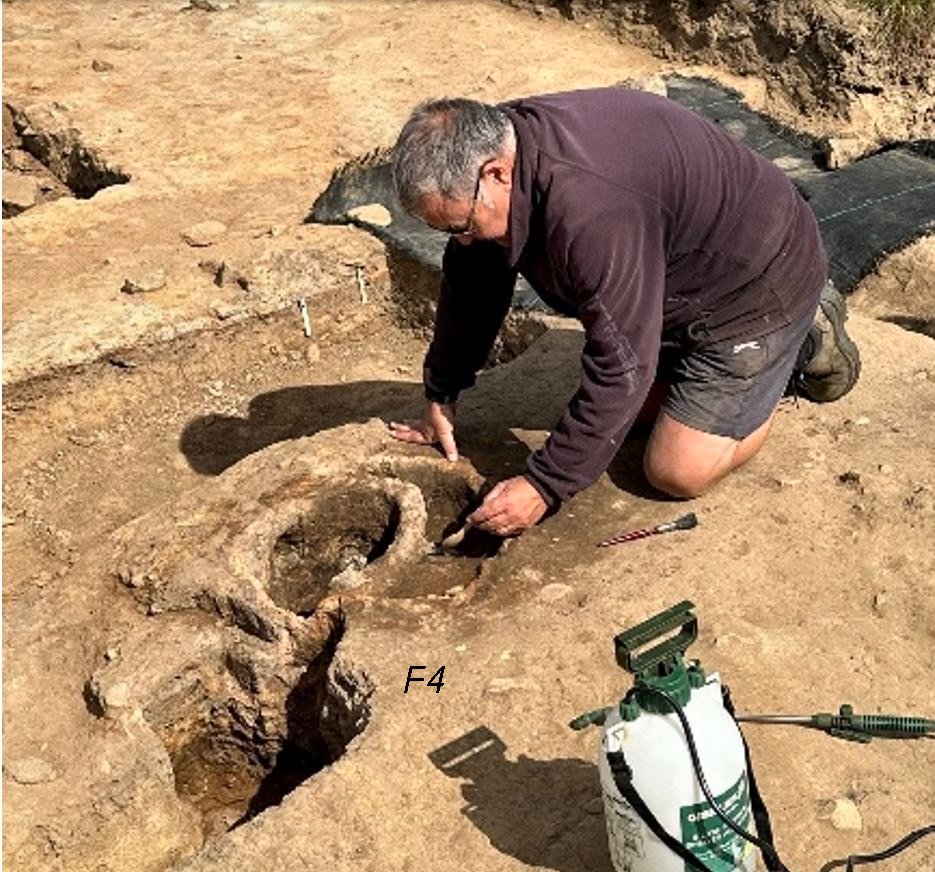
At lunch time with his drone, Chris flew a gridded pattern taking 76 overhead shots which were processed at home to produce an orthometric image of the site, including a full 3D model. 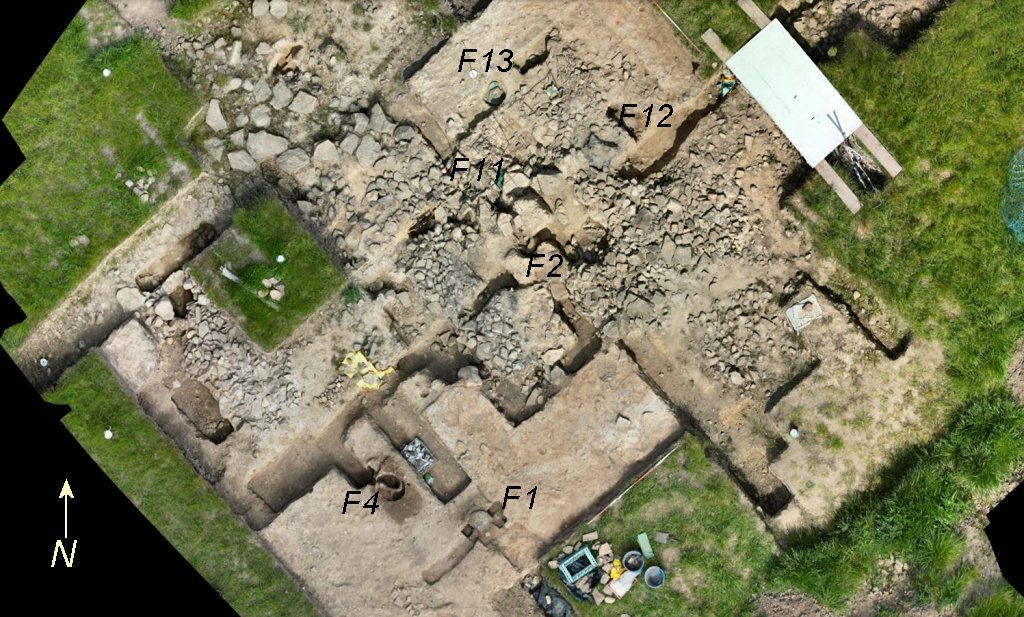 These drone images are proving invaluable for Bill’s plan drawings of the site.
These drone images are proving invaluable for Bill’s plan drawings of the site.
After lunch Chris showed Rachael how to record the Urns and Burial Features in 3D using the LiDAR and Photogrammetry software on his iPhone, whilst Colin begun to do more de-turfing on the NE edge the edge of Trench 3a.
Later in the afternoon Steve continued to define and investigate the pile of stones recently discovered in Trench 7.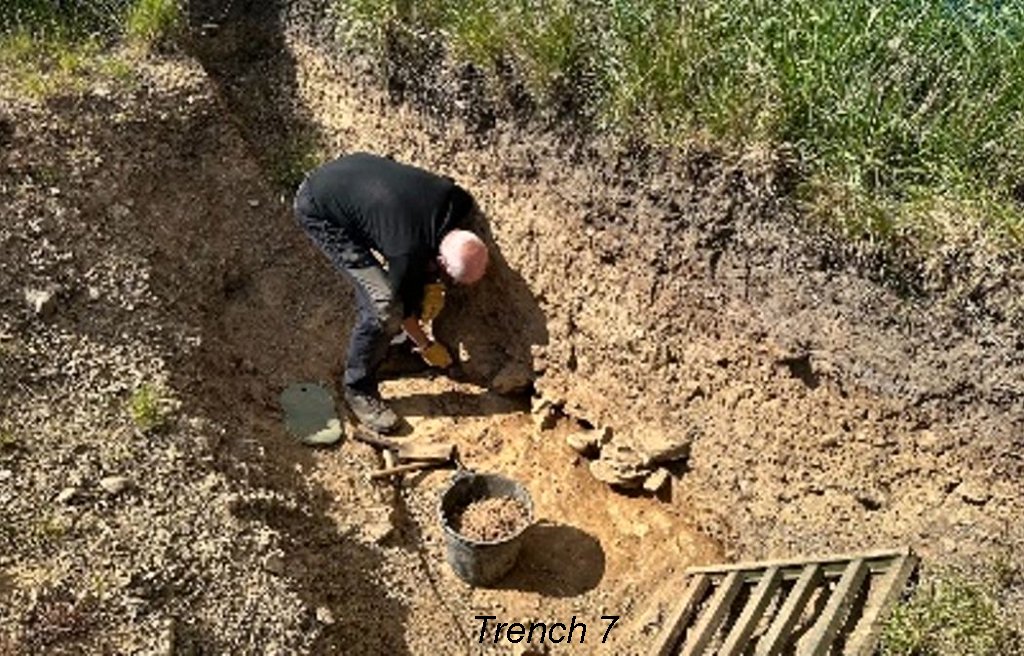
Wednesday 7th May
Day 13
Joining Bill and Chris today were Peter and Christine Morton. In the afternoon we were fortunate to have a visit from Sam Walsh from UCLAN accompanied by John Trippier. Sam is an osteologist who worked on the bone material from the Dig Ventures site at Morecambe. We had invited her to our site to give her thoughts on the bones still in situ and the best way to remove them. We also wanted to know the possibility of her being able to do the analysis work on them once they have be removed and processed.
In the morning the site was made ready for Sam’s visit, but leaving the covers on the burials to help prevent them drying out in the hot sun. Peter and Christine worked on taking another slice of topsoil form the NE side of Trench 3a and Bill carried on working on the area to the SW side of feature F11 (our suspected cist). After removing some smaller stone he came across another large stone further down. To get an idea of its size he opened up the pit so he could go deeper. The soft sandy clay here was darker than we find generally in the other areas. Eventually he reached the bottom of the large stone but the soft sandy clay continued down.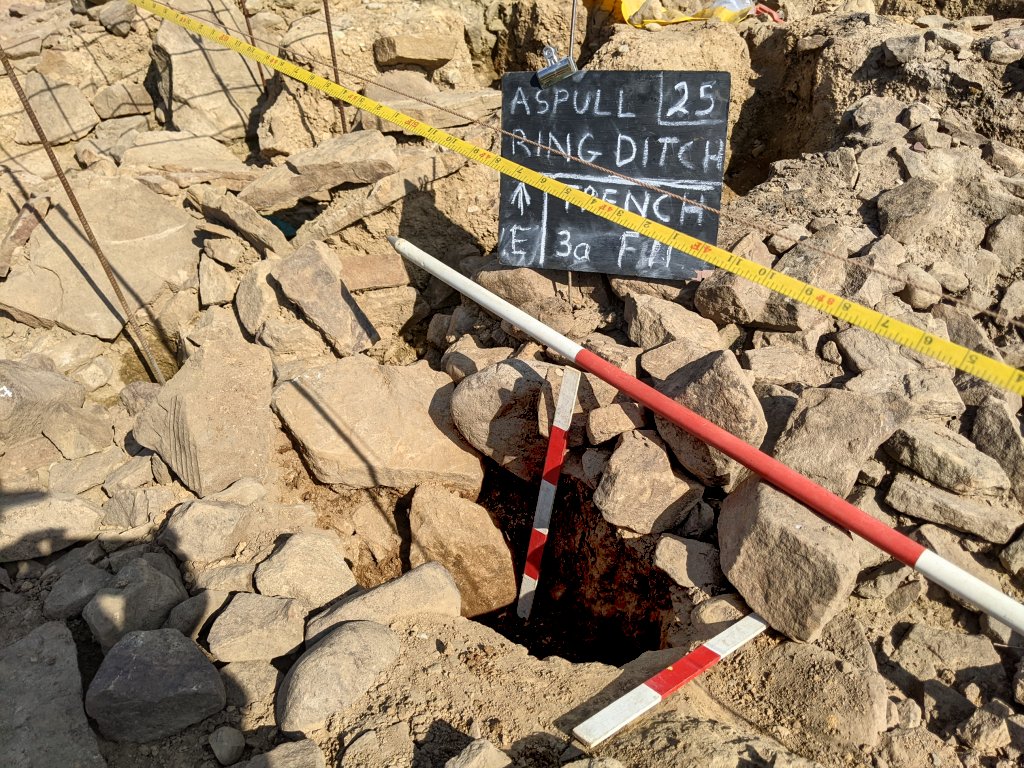
When Sam arrived she was given the obligatory site tour and was impressed, as is everybody, with it’s size particularly the ditch trenches. She was also impressed with our work on the central mound with its various layers and the burials we have discovered. She agreed with the plan we have putting together for the removal of the urns and how they would be treated after removal (we are currently arranging with Wigan Museum who have offered a facility for their micro-excavation). She was also happy with the the treatment of the bones fragments i.e. they are to be washed and dried by us (thanks to Ian Trumble, Bolton Museum this time have offered a facility for this process). We were also glad to hear that she will most likely be available in the Autumn to do the analysis work on them. It now seems we have a sound programme in place for the removal, processing and reporting of the human remains we have discovered.
Finishing off the day John spent some time trowelling the SE end of Trench 3a near to where it approaches the original Trench3. Here a patch of small stones were emerging in the subsoil and a this stage it was unclear if they were embedded in the mottled clay layer.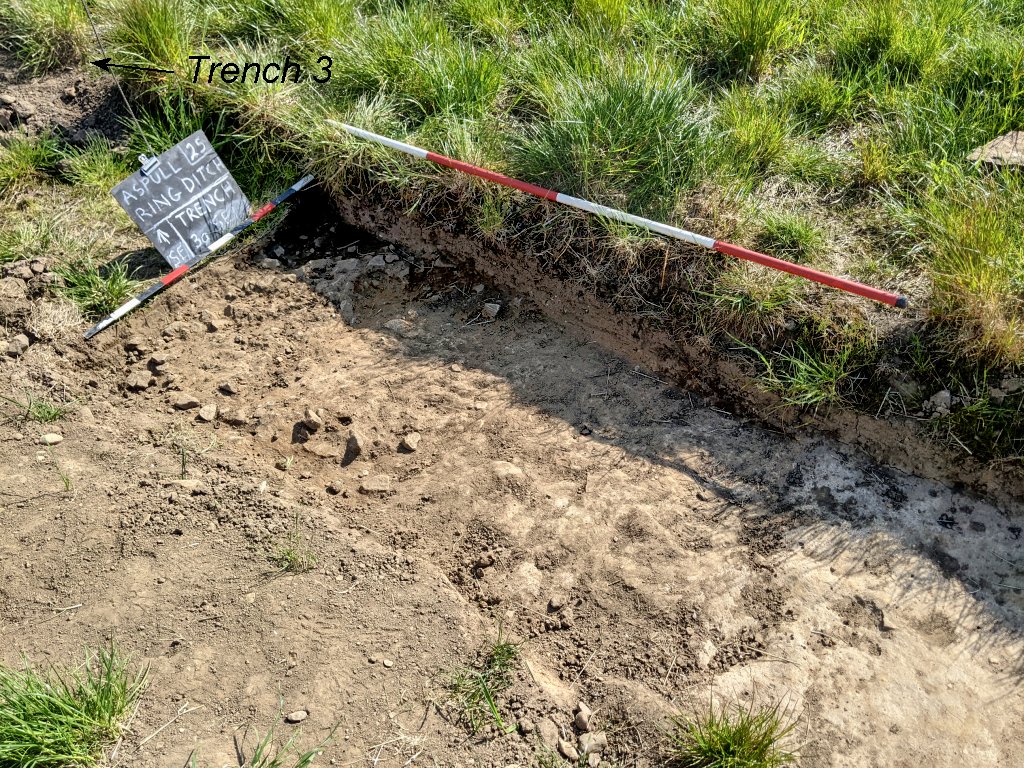
Thursday 1st May
Day 12
Joining Bill and Chris on site today were Andrew, Peter Cooke, John Trippier and new starter Rachael Tynan with Ben Goodburn joining later.
John and Rachael worked on the far west side of Trench 3a trowelling off the remains of the topsoil to reveal the underlying mottled clay. Apart from the small patch of stones, the only feature revealed here in mottled clay layer were plough ruts.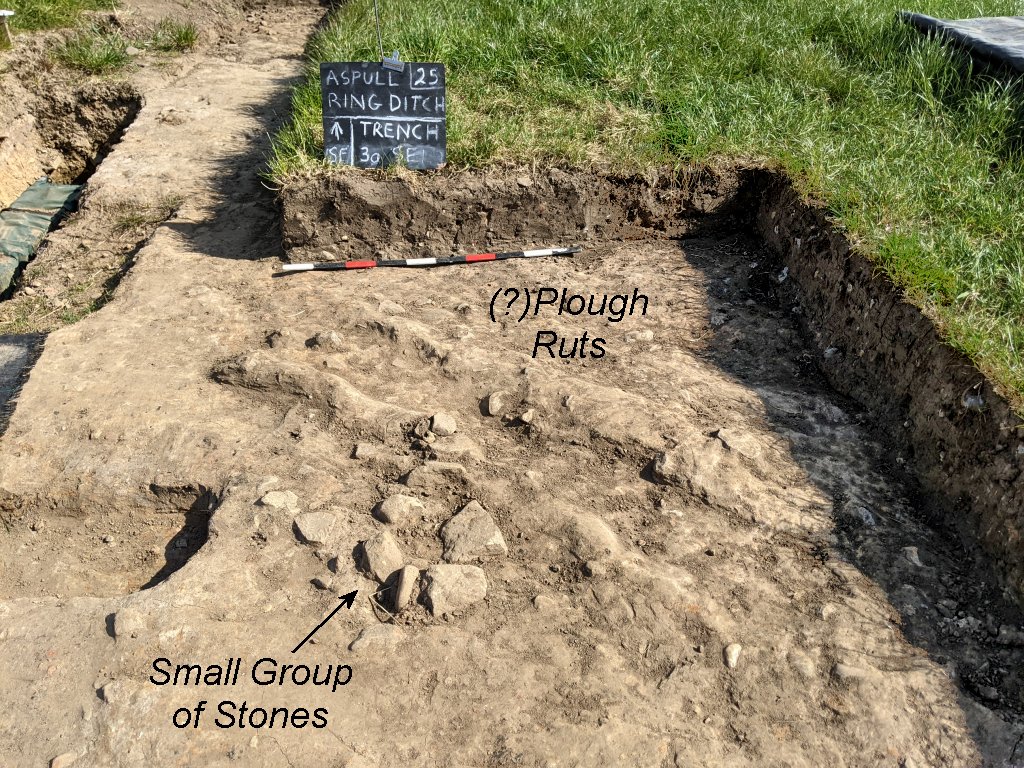
Andrew and Peter were asked to de-turf a strip on the NE side of Trench 3a. When this was completed Peter cleaned out the section next to the burial pit F12 while Andrew was asked to continue where Martin had left off in Trench 7. He was later helped by Rachael and the two of them reveal another strange thing at the bottom of the trench. In section there seemed to be a pile of stones which could be a feature of some kind.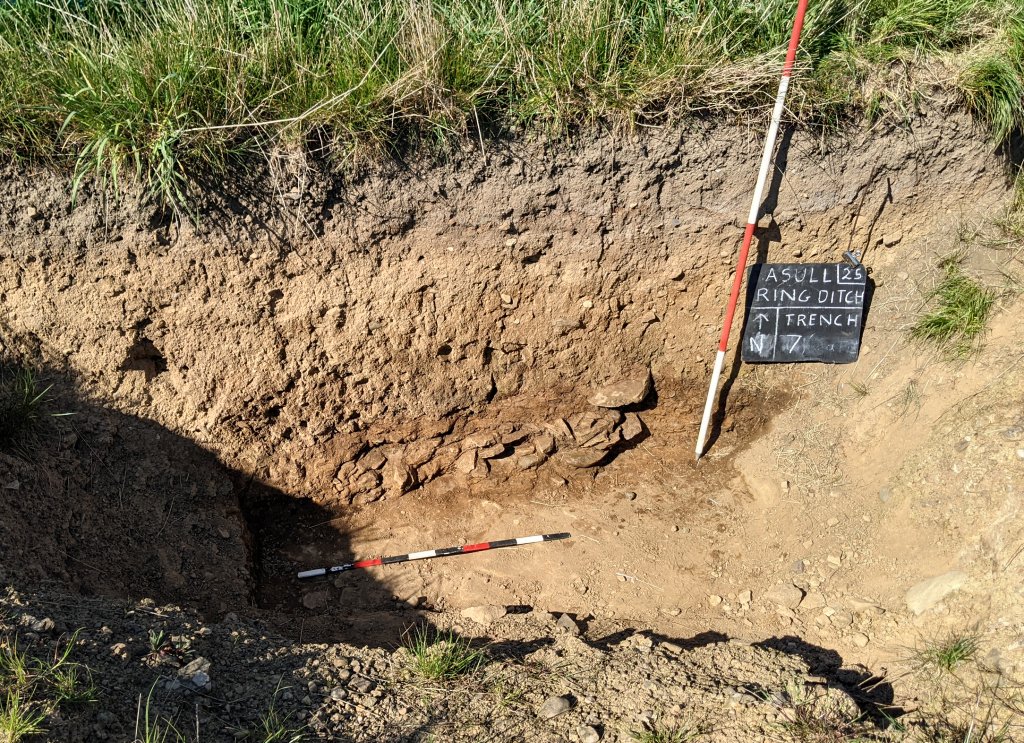
Ben continued in Trench 6-6a which is now more or less complete. Chris meanwhile continued working on the pit to the SE of our second urn (F2) revealing more of the cremated bone including some large pieces and a strange area of orange clay. 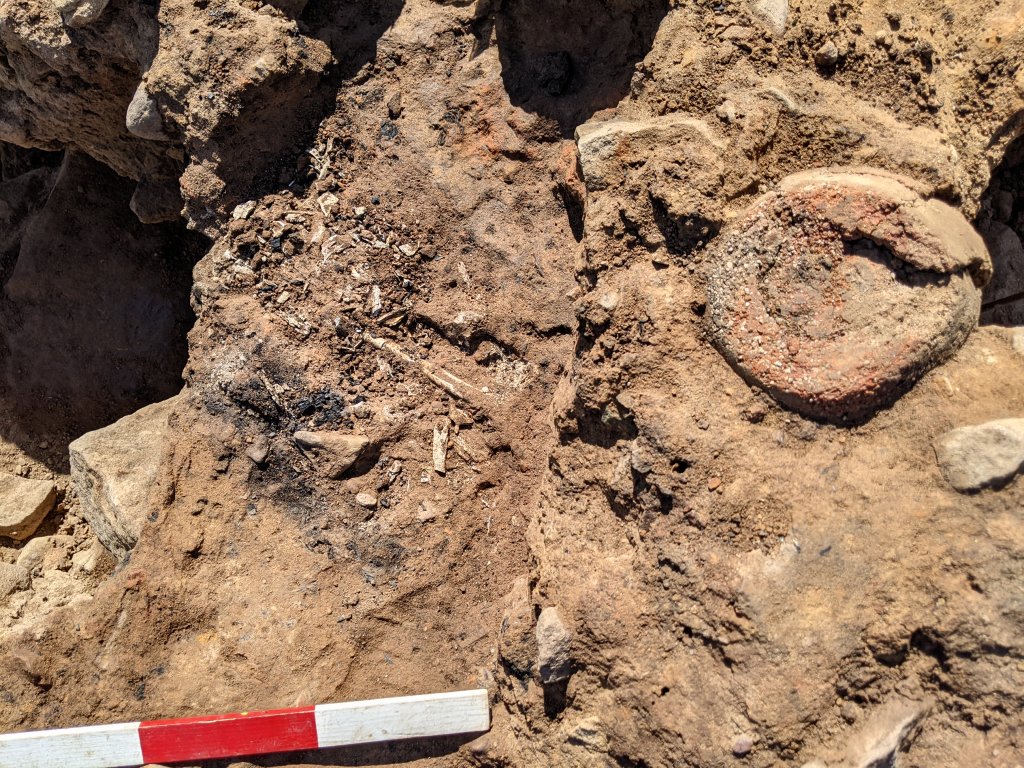
Bill completed his first attempt of a section through our so called cist F11. He then began to excavated the area to the SW side which reveal another fossil stone example.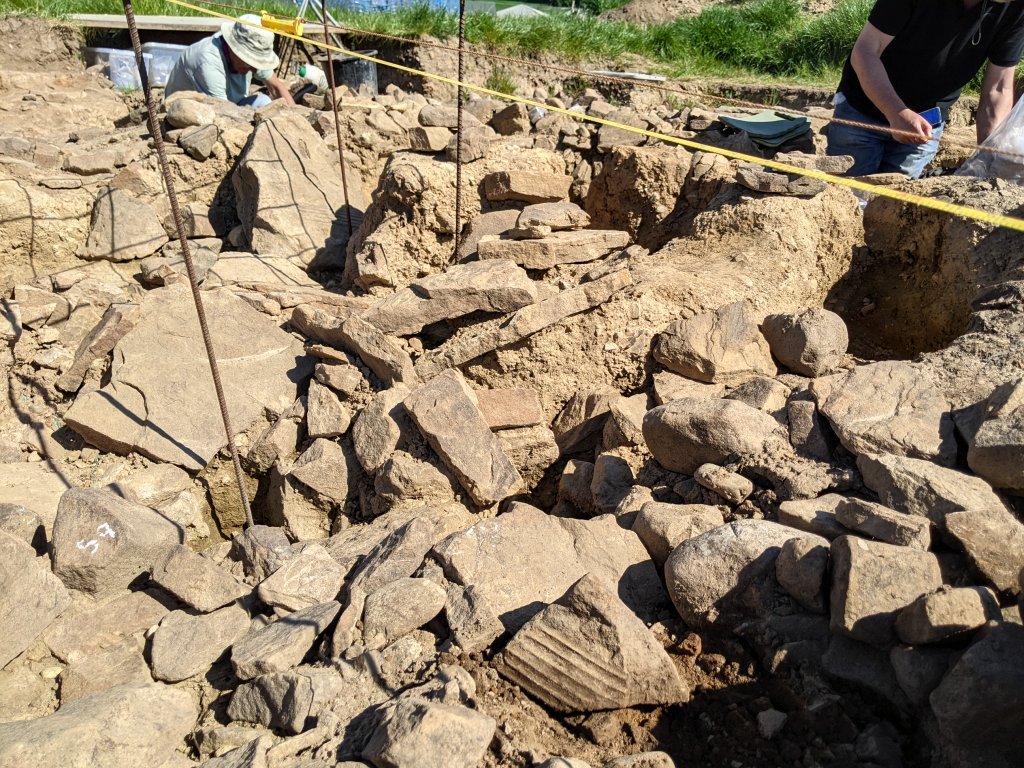
Wednesday 30th April
Day 11
We started with just a few today but by lunch time we had a decent turnout. Joining Bill and Chris were Andrew and Dave North with Ben Goodburn and Martin Trumble joining before lunch.
Dave and Andrew worked on the newly de-turfed area between Trench 3a SE and Trench 3c, trowelling off the remains of the topsoil to reveal the underlying mottled clay. Bill was interested to see if the edge of the central sandy mound could be revealed in its NE corner. Instead of the edge (which could clearly be seen in the section) as small pit emerged which just had topsoil in it.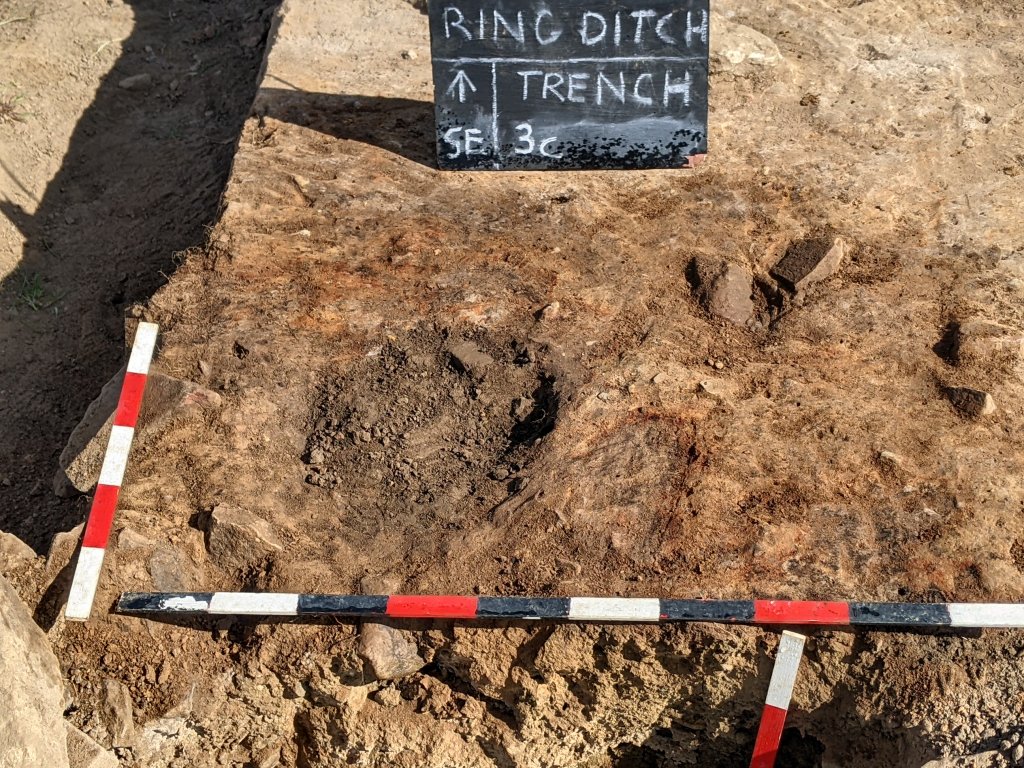
Following Ben Dyson’s suggestions, Chris started to excavate the pit which our second urn seemed to be sitting in. This revealed more cremated bone amongst a large patch of charcoal.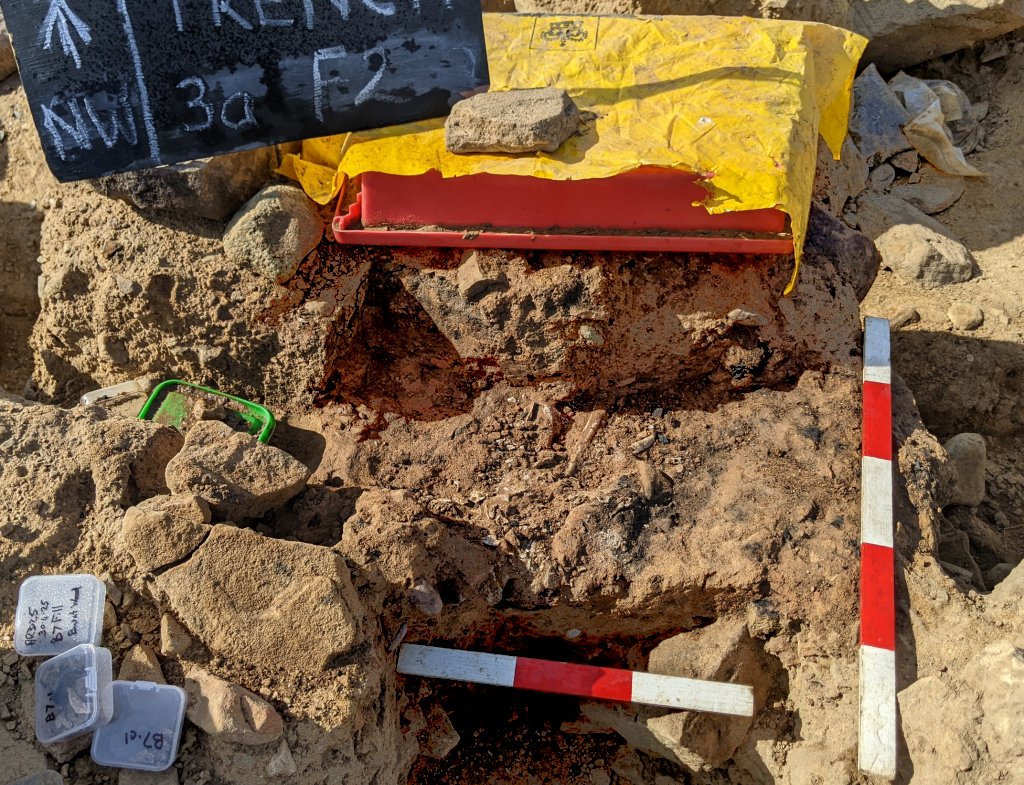
Ben continued working on Trench 6-6a while Martin was given the task of clearing out Trench 7. Before work could start on our supposed cist area, it was agreed the area needed to be properly recorded. With this in mind Chris carried out a survey with the LiDAR function on his phone and Bill attempted a section drawing across it on the SW – NE axis. To capture stone not quite on the section line he attempted a technique using a suspended drawing frame over the target area.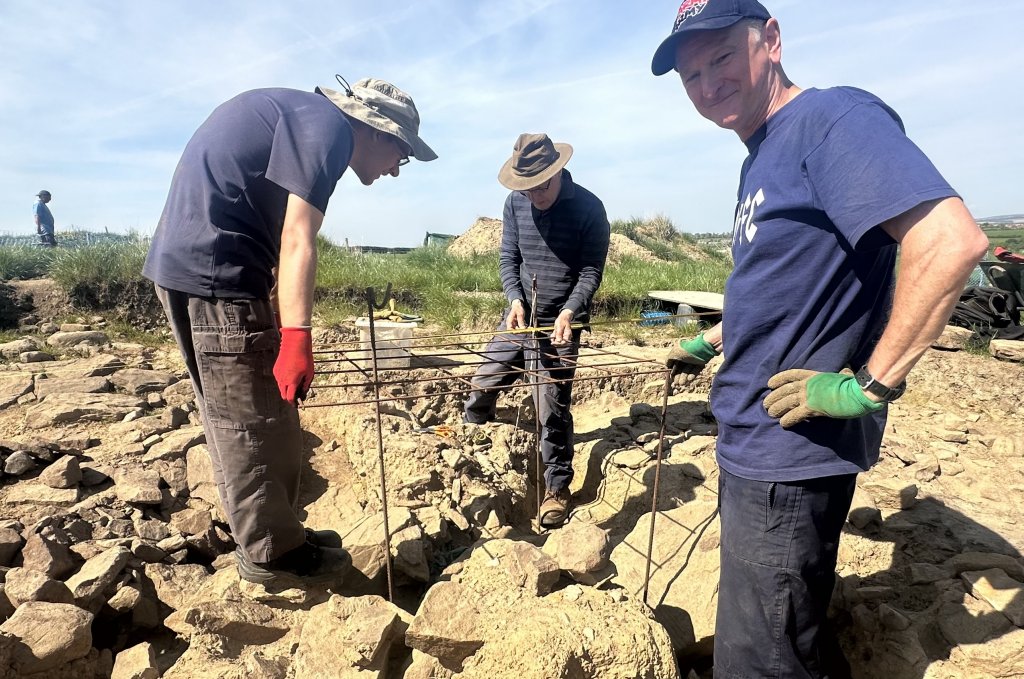
Thursday 24th April
Day 10
Eight volunteers on site today – joining Chris and Bill were Andrew, Colin, Peter, Steve Parry and John Needle with Ben Goodburn joining just before lunch.
After Ben Dyson’s visit the previous day, there was a discussion about how to proceed. Chris said he would get some bandages for the work on the urns (and plastic strips which he’d seen used on Youtube). Regarding F12, it was decided to go for the second of Ben’s options i.e. wait for a visit from Malin before removing any of the material from it.
Work continued on expanding the de-turfed area on the SW side of F4 carried out by Chris, Peter, Steve and Andrew. Later rowelling of this area revealed what seemed like modern ploughing ruts in the mottled clay layer.
Bill helped by Peter recorded the complicated section running down the NE side of F4 which he had prepared the day before.
Colin and John worked on removing the rest of the topsoil from the area on the NE side of F4. The mottled clay layer is only about 4cm think in this area, so Bill made them aware of this when trowelling down to it. Later Colin and Steve worked on expanding this de-turfed area all the way to Trench 3c while Andrew finished excavating the test pit under the removed stones (F17).
When Ben arrived he continued working in Trench 6-6a and by the end of the day had completely finished exposing the bedrock floor ready for Bill to record.
Wednesday 23rd April
Day 9
There were just six volunteers on site today – joining Chris and Bill were Christine and Andrew with John Trippier and Peter joining just before lunch. In the afternoon we were joined by Ben Dyson from the Greater Manchester Archaeological Advisory Service and new member George Chapman.
We have been anticipating Ben’s visit for some time as we need his guidance on how to proceed with the removal of our two cremation urns and advice about what to do with our other burials. In preparation for Ben’s visit, we began by removing all the covers and cleaning around the vessels. Chris worked on our first urn (F1) while Andrew worked on the our second urn (F2). Chris was keen to show how the pit the urn was place in could be seen in the section on the west side but not on the east side as the burnt and mottled layers seemed to be going right up to and indeed underneath the urn.  Andrew also worked to expose the flat bottomed pit our second urn (F2) seemed to be sitting in.
Andrew also worked to expose the flat bottomed pit our second urn (F2) seemed to be sitting in.
Bill meanwhile worked on the clay-lined pit feature (F4) cleaning the edges up so that the profile could be clearly seen. He trowelled area around the outside of the the feature bringing out the blackish edge which lines the outside of the orange wall of the feature. He also noticed another black line running a few centimetres away from the feature on the NE side. He speculated whether could represent the original pit which was then refilled to form the shape of the feature before it was lined with the clay. 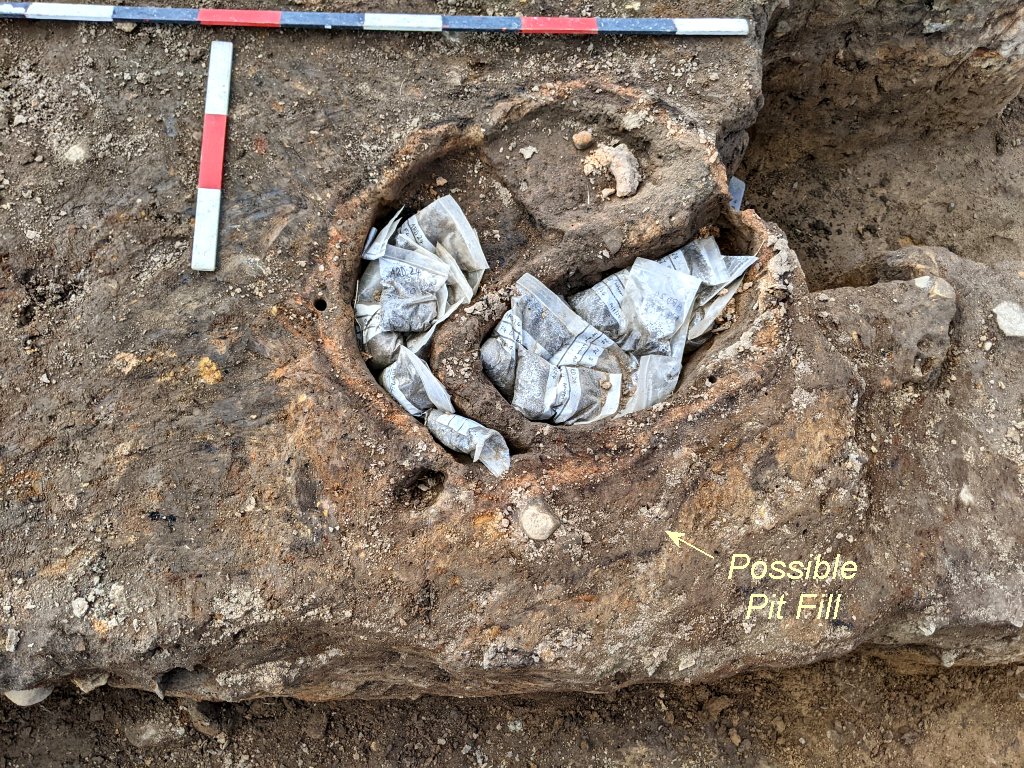 Bill also took some time cleaning the section running down the NE side of the clay-lined pit feature (F4) ready for recording. This section, originally looked at last year, was turning out to be very complicated with a deep undulating layer of mottled clay, the higher layer being dark and the lower undulating layer lighter with a whitish tinge.
Bill also took some time cleaning the section running down the NE side of the clay-lined pit feature (F4) ready for recording. This section, originally looked at last year, was turning out to be very complicated with a deep undulating layer of mottled clay, the higher layer being dark and the lower undulating layer lighter with a whitish tinge.  This is as opposed to the opposite side of this trench which demonstrates the standard arrangement of red and black line lying under a relatively thin layer of mottled clay. The transition section (on the NW side of F1) shows that the the red line continues but the black line doesn’t (only to reappear in the section alongside F4.
This is as opposed to the opposite side of this trench which demonstrates the standard arrangement of red and black line lying under a relatively thin layer of mottled clay. The transition section (on the NW side of F1) shows that the the red line continues but the black line doesn’t (only to reappear in the section alongside F4.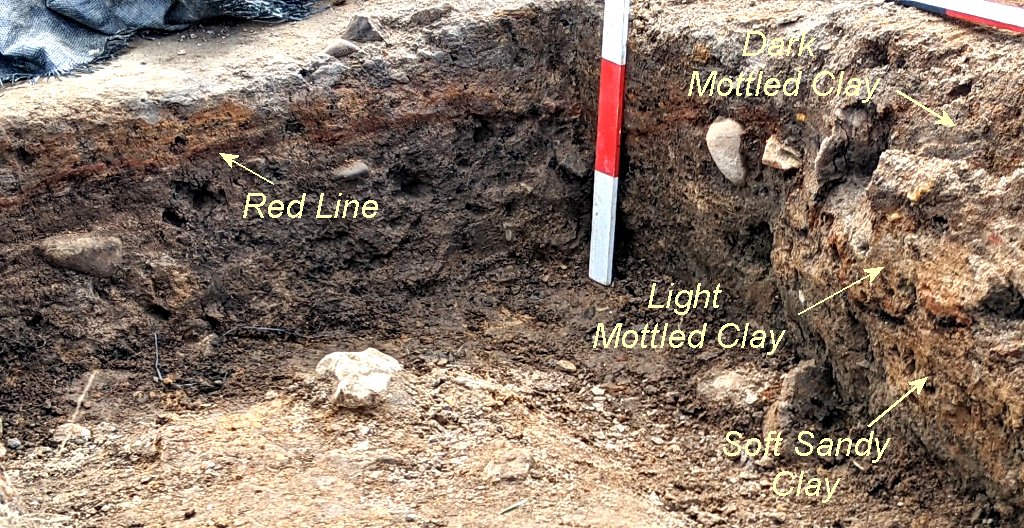
Christine was given the task of trowelling the newly de-turfed area to the SW of the clay-lined pit feature (F4). When John arrived he joined Christine concentrating on the SE side where the group of stones (F18) had been revealed. When Peter arrived he uncovered the burial pit he had been working on (F12) ready for Ben’s inspection.
Ben arrived at 2.00 in the afternoon and after the introductions, got stuck in to getting himself familiar once again with the site he’d briefly visited last year. This included seeing our recently cleaned up south ditch terminus in Trench 6-6a. Being amazed with its proportions he was, as we are, that this is not typical Bronze Age.
He then went through each of our four burials which have yet to be processed (F1, F2, F4 and F12) talking us through the various options for the removal of the material. He finished of with a look at our suspected cist and, like us, was quite excited about what it could reveal. Chris said he would write a full report on Ben’s thoughts and suggestions and once approved would circulate them around the committee. In the meantime here is a summary:
F1 – excavate the material out of the pit on the NW side. Use a bandage to support the urn as we gradually work our way down. Excavated lower than the pot itself so as to catch any evidence of what it is resting on. Mark the vessels orientation before lifting. The lab at Salford would be only be available till July but he suggested the excavation of the pot’s interior could be done in anybody’s garage or outhouse. This had the advantage of not having to travel to Salford and could be done by an enthusiastic member of our Society in their own time.
F2 – the pit again should be excavated first. As the pot becomes exposed, we should try to support it with bandages (which may not work but worth a try). Any material in side the urn should be kept separate from the material from the pit.
F4 – There had already been more than half of cremated bone and charcoal removed from this feature. There was therefore a general thought that we had gone as far as we could with this feature and should now re-bury it for future generations to investigate. Bill said though that there was still some things we didn’t understand about it such as its depth and how it was supported (thought to be on a large stone). He also thought it important to have a section drawing of it, which could only be done by, at the very least, excavating down the opposite side to that already excavated. Ben agreed and suggested that a careful excavation could be achieved to leave a good portion (i.e. more that half) left in situ.
F12 – Again a good proportion of the cremated bone had already been removed from this burial pit. Ben said there were two options with the removal of the rest of the exposed material. One would be to continue removing the bone perhaps segregating it into sections – the other would be to wait for a visit from Malin, the osteologist from York, who would be able give us her opinion on how to proceed.
Before we left for the day Andrew was asked to remove material from the face of the section to the NW of F4. This had dried out and was about to fall in. Once removed the section revealed how deep the mottled clay layer was in this area and even displaying a second layer of burning.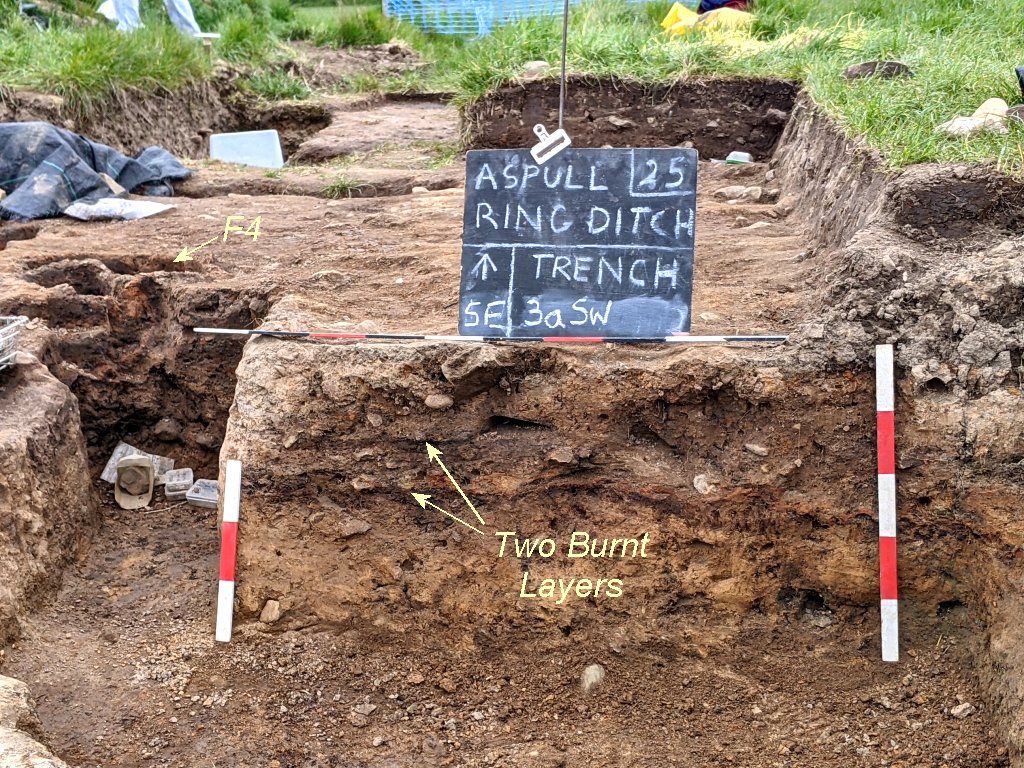
Thursday 17th April
Day 8
A good turnout today and the weather was also quite pleasant. Joining Chris were Isobel, Ben, Peter, John Trippier, Colin, Christine Morton.
The overall aim of the day was to clean the recently de-turfed areas and continue to expand them. Chris, John and Issy continued to work on the SW side of the clay-lined pit feature (F4) exposing more of the surface of the mottled layer. It is starting to look very interesting now, with large areas of clay, burning and stones showing. Chris and John worked around the area of stones and burning which has become quite confusing and uneven. Issy worked on the area closer to F4. This is a ‘work in progress’ and further de-turfing to the SW will be required.  Colin worked on removing the remaining top soil in the area on the NE side of our first urn (F1). Helped by Christine, he then, began to expose the top of the mottled layer. This side looks more like the rest of the site with little burning. Later they began working on the remaining turfs on this side. It is hoped to get a closer look at the NE side of our first urn which has proved difficult to see.
Colin worked on removing the remaining top soil in the area on the NE side of our first urn (F1). Helped by Christine, he then, began to expose the top of the mottled layer. This side looks more like the rest of the site with little burning. Later they began working on the remaining turfs on this side. It is hoped to get a closer look at the NE side of our first urn which has proved difficult to see.
Peter continued to work carefully on the capped pit with the large collection of bones (F12). He managed to clear out the fill from the NW end of the pit and showed that the dense collection of bone does not go as far as the end. There is also evidence of the darker ‘packing’ stones showing here.  Later he cleaned the open SE end of the pit to get a clear view of the floor of the pit. It looks similar to the stone layer we found outside the pit.
Later he cleaned the open SE end of the pit to get a clear view of the floor of the pit. It looks similar to the stone layer we found outside the pit.
Ben continued his work in Trench 6/6a which is the terminus of the Ring Ditch on the south side of the entrance. He has nearly completely removed the winter slippage showing a new view of the ditch section. We can now see the floor of the terminus which appears to be unbroken bedrock.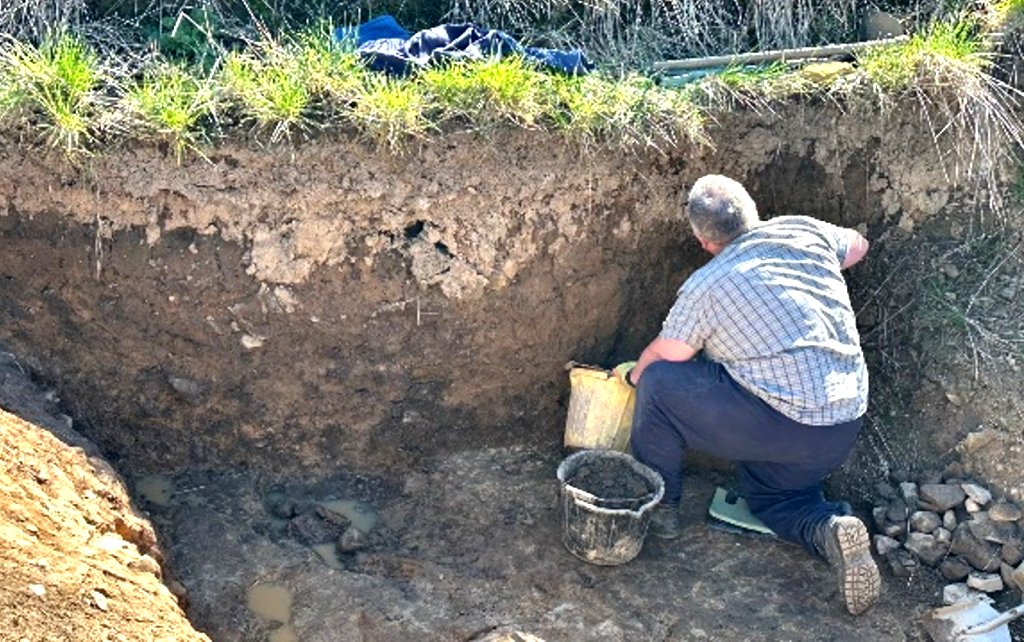
Tuesday 15th April
Day 7
Just four on site today – joining Chris were Isabel, Patrick and Ben.
Chris and Izzy opened up more area to the SW side of the clay-lined pit feature (F4) and then proceeded to clean the surface of the mottled layer. There seem to be interesting patches of burning and stones in this area.  This task will be continued later in the week.
This task will be continued later in the week.
Patrick continued to carefully excavate the area in front of the clay-lined pit feature (F4) so that he could see more clearly the complicated section in front of it. Although there is still a little more work to do, a double red/black burning line could clearly be seen that seemed to touch the side of the clay lined pit.  This task will be completed this week.
This task will be completed this week.
Ben continued to clean out the ditch terminus in Trench 6 / 6a exposing more of the flat bedrock floor and removing all the debris that had fallen in over the winter.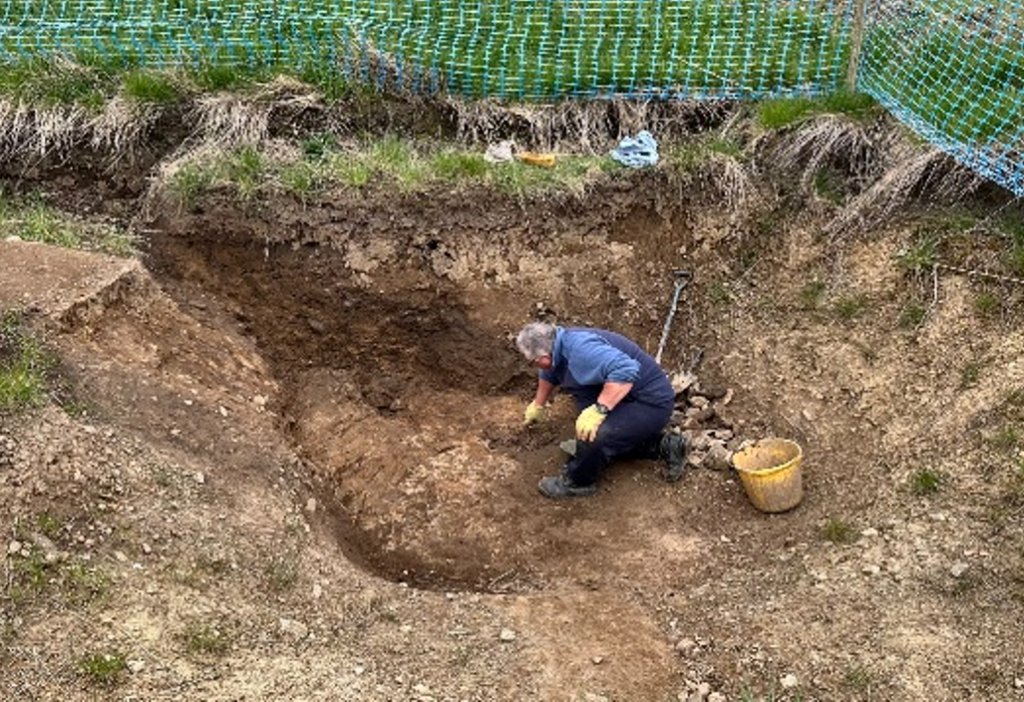
Saturday 12th April
Day 6
This day was added at short notice to enable our friends from Border Archaeology and Heritage Group (BAHG) in Cheshire to joined us. It also gave the opportunity for some of our regular members to attend. Joining Chris today were Ben, Patrick, John Trippier with Bill joining later – and from the BAHG Phil Cox, Penny, Cathy and Denise German.
The BAHG continued their work on the strange anomaly in Trench 3d outside the main ditch trying to determine if the feature was manmade or natural.

There had been some collapse over winter of the loose material in the side wall of the trench. A decision was made therefore to remove this and more of the loose rock fill inside the feature to see if we could get any more information. With nothing further forthcoming, this feature still remains a mystery.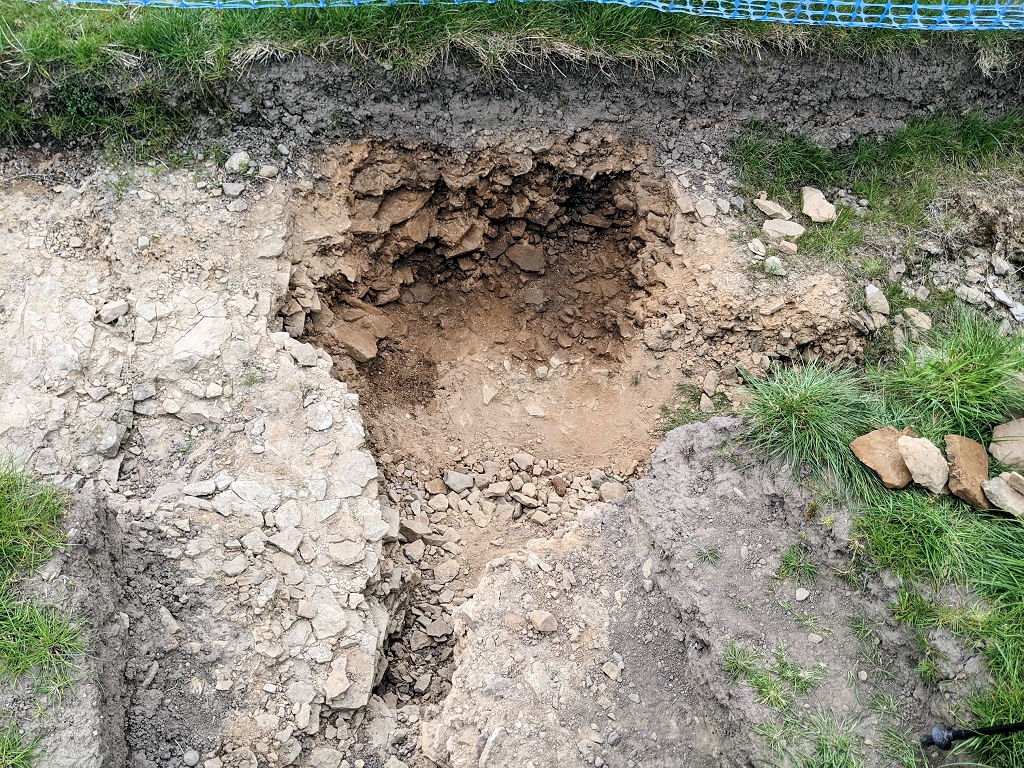
John worked on a newly exposed area to the SW of the clay-lined pit feature (F4). Last time out Chris had detected a small group of stones in the SE corner embedded in the mottled clay layer. There was also the suggestion of burning and fleck of cremated bone in the area and John was able to open up more of the area, but wasn’t able to detect if the stones were lying in a pit or not (more work to be done – it was labelled F18 just in case).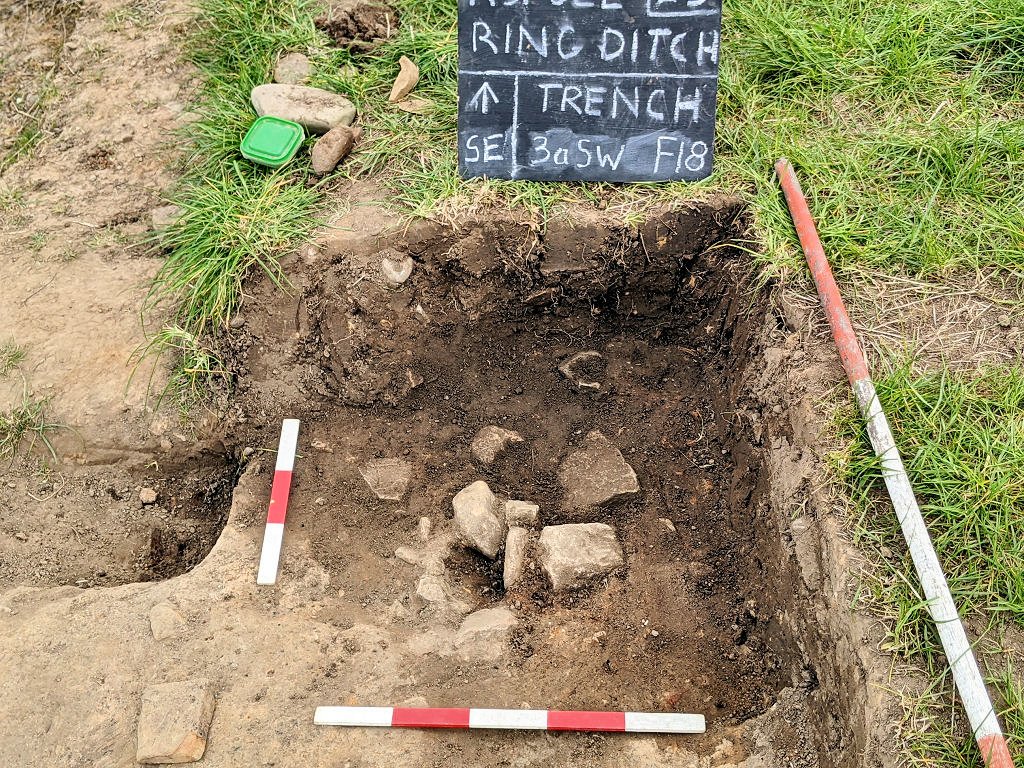
Chris continued working on the NE side of our first urn (F1) looking for its wall on that side. His work created quite a hole on that side but so far failed to find the wall. This is very strange as the usual stratigraphy, i.e. burnt layer, could still be seen in the section going under the rim of the pot.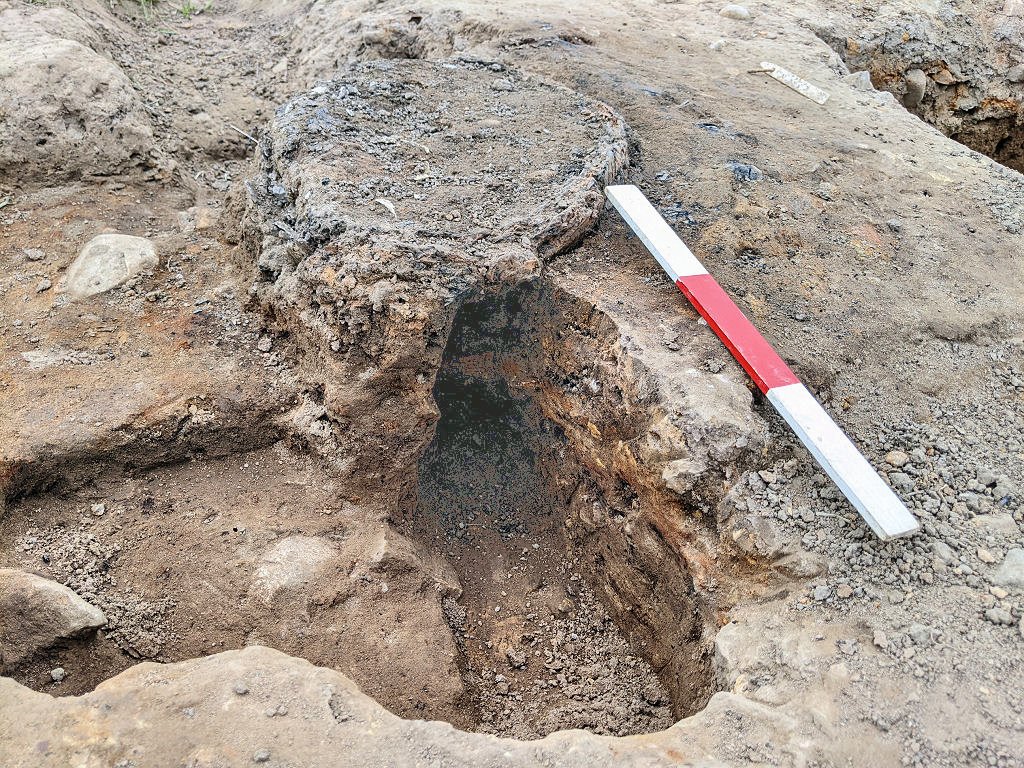
Patrick continued with his work on the area to the NW of the clay-lined pit feature (F4), working his way towards it cutting through the soft sandy clay. 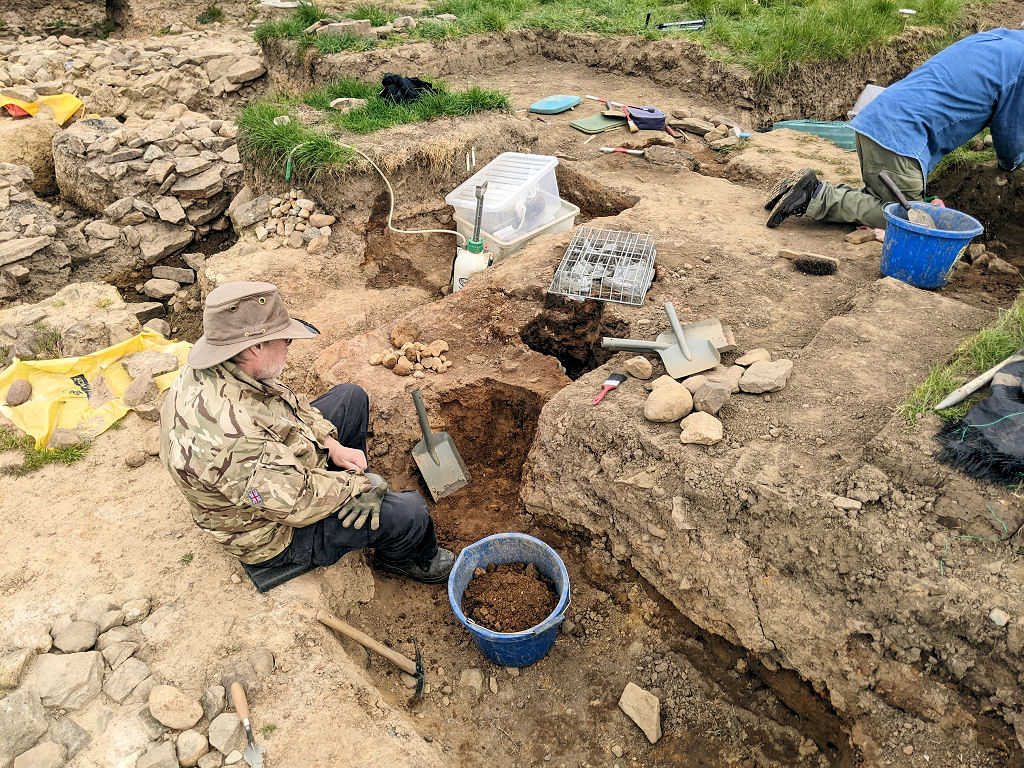 This revealed very little, however in the section the burning layer could just about be seen rising up under the mottled clay layer.
This revealed very little, however in the section the burning layer could just about be seen rising up under the mottled clay layer.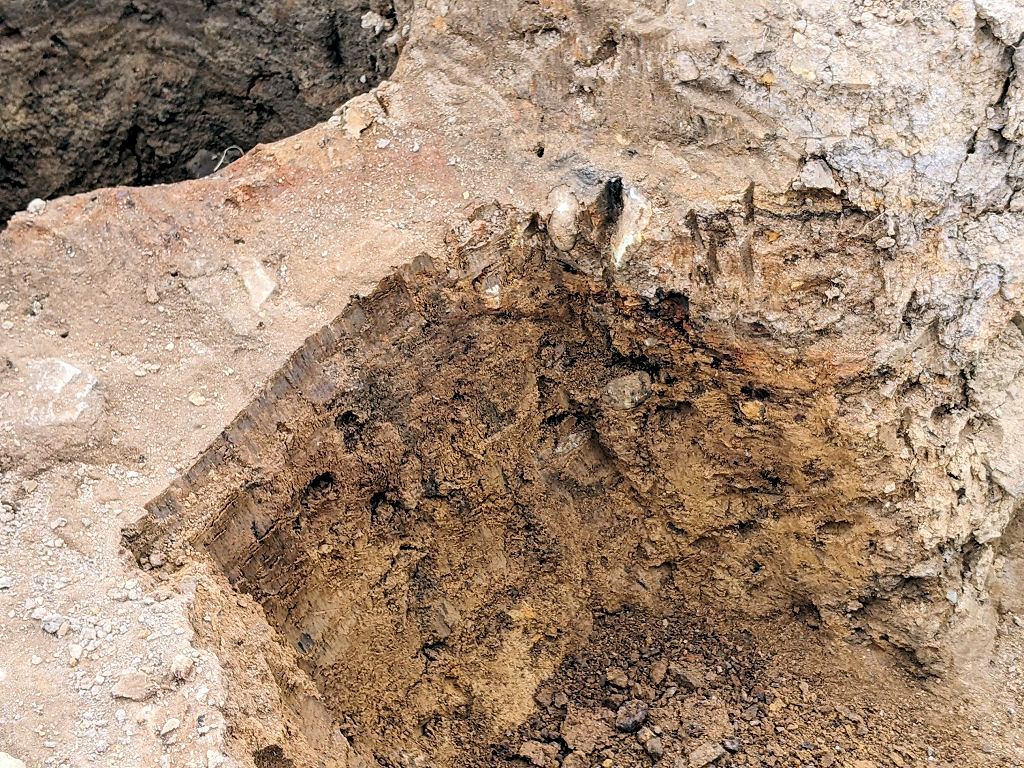
Ben continued to work in Trench 6 / 6a defining the edges and floor of the ditch. When Bill arrived, he and Chris had a discussion about what he and Ben had discovered. In the original Trench 6 ditch wall there seemed to be a layer of sticky clay which had previously detected when original trench had been dug. Ben Dyson, on his visit to the site had suggested that it was possible that this had been deliberately pressed into the side wall of the ditch either for decretive purposes or to make it watertight (the latter seems unlikely as the ring ditch is located on a sloping hillside). It was great to be be able to see bedrock in Trench 6a as very little if any had been detected before (although it had been in the original Trench 6). Chris was curious to see how far it went towards the terminal side of the ditch (when this had been done in Trenches 5 and 5a, the square ends had been exposed).  Bill was unsure whether this would be the case in this trench as he thought the ditch profile had already been established when the fill had been excavated out in previous years. This had revealed a shallow semi-bowl shape with a change of slope about 40cms from the bottom (similar to the arrangement seen in the other terminus, Trench 7). The only way to find out if Chris was right would be to chase the bedrock but that would destroy the profile already established (Bill conceded though that this would have to been done eventual).
Bill was unsure whether this would be the case in this trench as he thought the ditch profile had already been established when the fill had been excavated out in previous years. This had revealed a shallow semi-bowl shape with a change of slope about 40cms from the bottom (similar to the arrangement seen in the other terminus, Trench 7). The only way to find out if Chris was right would be to chase the bedrock but that would destroy the profile already established (Bill conceded though that this would have to been done eventual).
Thursday 10th April
Day 5
Bill was unavailable today so Chris was in charge. Joining him were Ben, Steve, Patrick, Colin, Peter and Francesca Usher.
Another decent turn out on a hot sunny day. Colin and Steve continued the work de-turfing the areas either side of out 2 major features in Trench 3a on the SE side, i.e. our first urn (F1) and the clay-lined pit feature (F4). The work next to the urn is to allow us to continue to explore the area around it in preparation for its lifting. In the afternoon Steve moved to the area Chris had opened in the morning SE of the F4 where burning and flecks of cremated bone had been detected.  When Chris later cleaned this area he also found a collection of stones at a high level.
When Chris later cleaned this area he also found a collection of stones at a high level.
Patrick continued his work on the area NW of the clay-lined pit feature (F4). After trowelling through the mottled layer, he began to open up the area by cutting through the underlying soft sandy clay. Starting on the NW side, he worked his way towards F4 in order to create a section down the side of the feature to better understand how it was created. 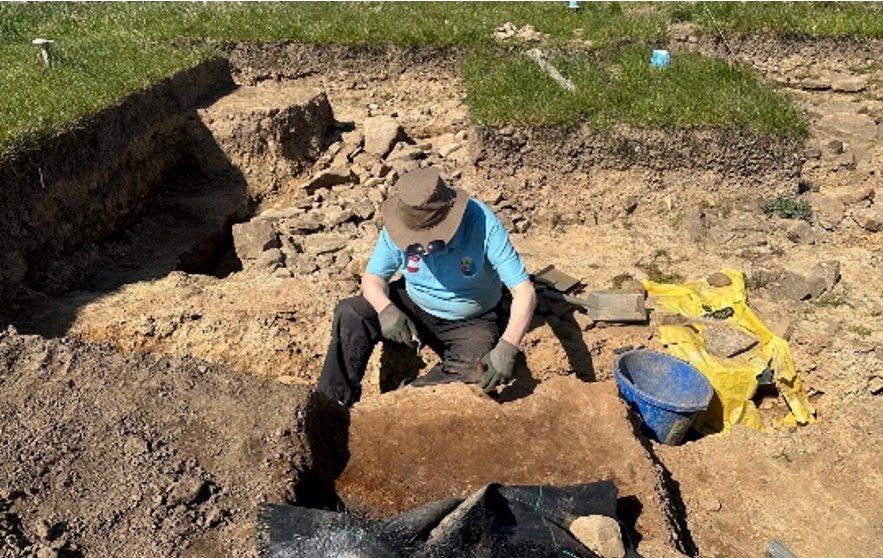
Peter continued to work on his cremation burial (F12) exposing the full extent of the pit containing the cremated bones. By the end of the day he had found the edge of the cut of the pit and was able to show that the bones ran almost all the way to the end of the pit, which a surprise as a large amount of bone had already been removed from it.  It seems very likely that the bones must have been inserted into the pit in a container (maybe a leather bag) which has now rotted away. The bag seems to have been packed in with dark stones preserving the shape of the bag.
It seems very likely that the bones must have been inserted into the pit in a container (maybe a leather bag) which has now rotted away. The bag seems to have been packed in with dark stones preserving the shape of the bag.  Chris recorded the feature in 3D and photographed it throughout the day to gather as much detail as possible on this very exciting find.
Chris recorded the feature in 3D and photographed it throughout the day to gather as much detail as possible on this very exciting find.
Francesca finished of the work Bill had started on the area around F12 cleaning away all the debris that had fallen in over the winter.
Ben continued his work in Trench 6 / 6a which is one of the termini of the ring ditch. He was joining these two adjacent trenches together as well as clearing out the debris from the winter collapse. He’d almost completed removing the baulk from between the two when he started to expose bedrock in the ditch wall. 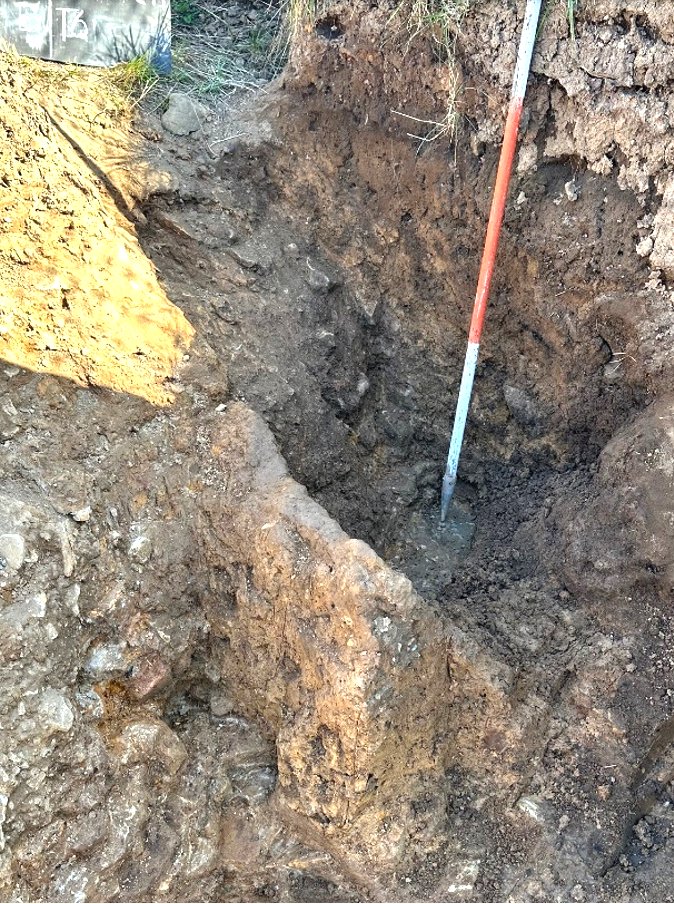 Chris joined him in the afternoon for a while and was able to continue following the stone floor up the side of the ditch for several centimetres on either side of the remaining baulk.
Chris joined him in the afternoon for a while and was able to continue following the stone floor up the side of the ditch for several centimetres on either side of the remaining baulk.
Tuesday 8th April
Day 4
Just seven out today – joining Bill and Chris were Patrick, Andrew, Isabel, Colin and Ben.  Continuing with the theme of de-turfing areas to exposed the mottled layer (in hope of identifying more burials), Colin was tasked with de-turfing the area immediately to the NE side of our first urn (this would eventually link up with Trench 3c leaving a small island for reference). Similarly Isabel was given the task of de-turfing the area immediately to the SW of the clay-lined pit feature (F4).
Continuing with the theme of de-turfing areas to exposed the mottled layer (in hope of identifying more burials), Colin was tasked with de-turfing the area immediately to the NE side of our first urn (this would eventually link up with Trench 3c leaving a small island for reference). Similarly Isabel was given the task of de-turfing the area immediately to the SW of the clay-lined pit feature (F4).
Chris meanwhile continued investigating the area around the NE side of our first urn in the hope of getting a glimpse of the urn wall on that side. Patrick continued with trowelling down the mottled clay layer immediately to the NW side of the clay-lined pit feature (F4).
Since the discovery of the burial under the two large flat stones (F12), there has always been a thought that there may be more under the large flats stones uncovered in Trench 1b at the end of Season 2. When these were first exposed, the ones that were looked at were found to be just resting on the soft sandy clay so it was assumed the others were too. It was decided therefore that with this new information, we should take another look at these stones just in case our initial assumption was wrong. A group of three stones were selected for removal (shown at the bottom on the photo in there original formation) and the area immediately underneath excavated.  Andrew was tasked with this and initial trowelling showed some promising dark patches in the soft sandy clay (it was labelled F17). However when the area was halve- and then quarter-sectioned, nothing of significance came to light.
Andrew was tasked with this and initial trowelling showed some promising dark patches in the soft sandy clay (it was labelled F17). However when the area was halve- and then quarter-sectioned, nothing of significance came to light.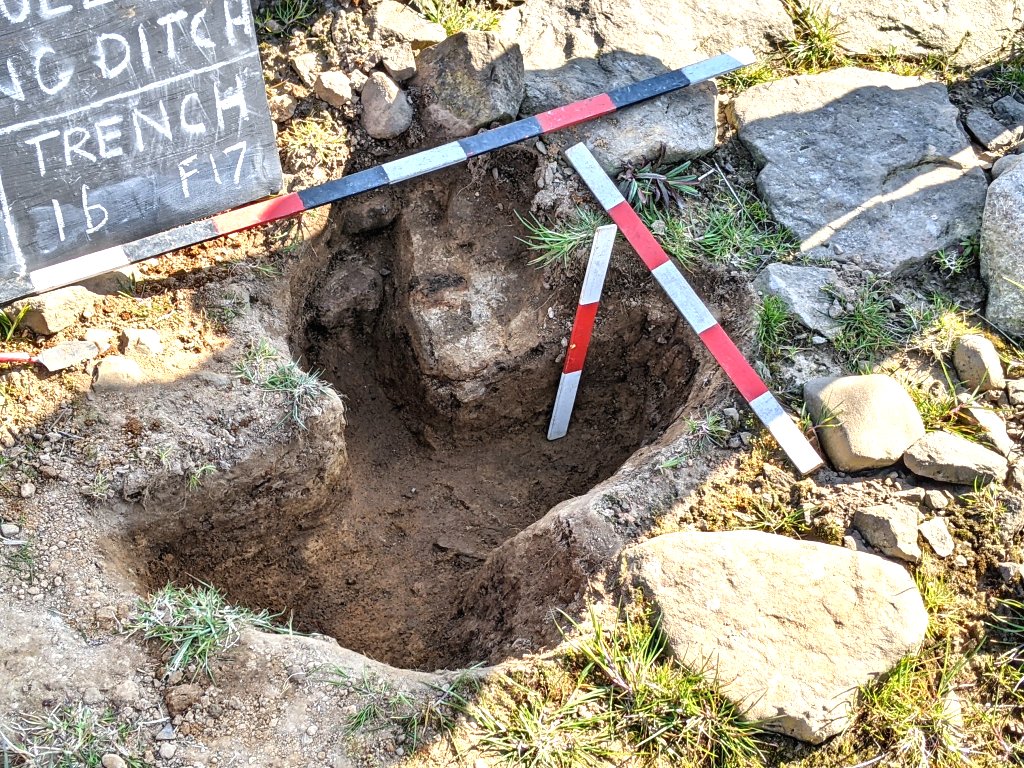
Bill meanwhile took some time cleaning the section wall of Trench 3a on the NE side so that this could be recorded. He was keen to do this as it will soon disappear when the rest of this area (between 3a and 1b) is excavated, having already been taken down to the mottled layer. The section also includes two features containing cremated bone deposits – F13 and F14 (F13 having contained a large cache – over two kilograms – see last year’s Day 63).  When he was happy with the cleaning he recruited Andrew to help him with creating the section drawing.
When he was happy with the cleaning he recruited Andrew to help him with creating the section drawing.
Ben continued with his work in Trench 6 and made steady progress. By the end of the day had almost completely cleared the baulk between 6 and 6a.
Wednesday 3rd April
Day 3
Good turnout today with a total of nine on site. Joining Bill, Chris and Patrick were Andrew Wilcock, Jen Harrison, Peter Cooke, Ben Goodburn, Christine Morten and new starter Isabel Vaudrey . Chris continued working the area around our first urn (F1) particularly on the NE side. However he found it difficult to get close to the the wall of the urn on that side as the surrounding clay seemed to be encrusted onto it and he was worried that removing it may damage the urn.
Chris continued working the area around our first urn (F1) particularly on the NE side. However he found it difficult to get close to the the wall of the urn on that side as the surrounding clay seemed to be encrusted onto it and he was worried that removing it may damage the urn.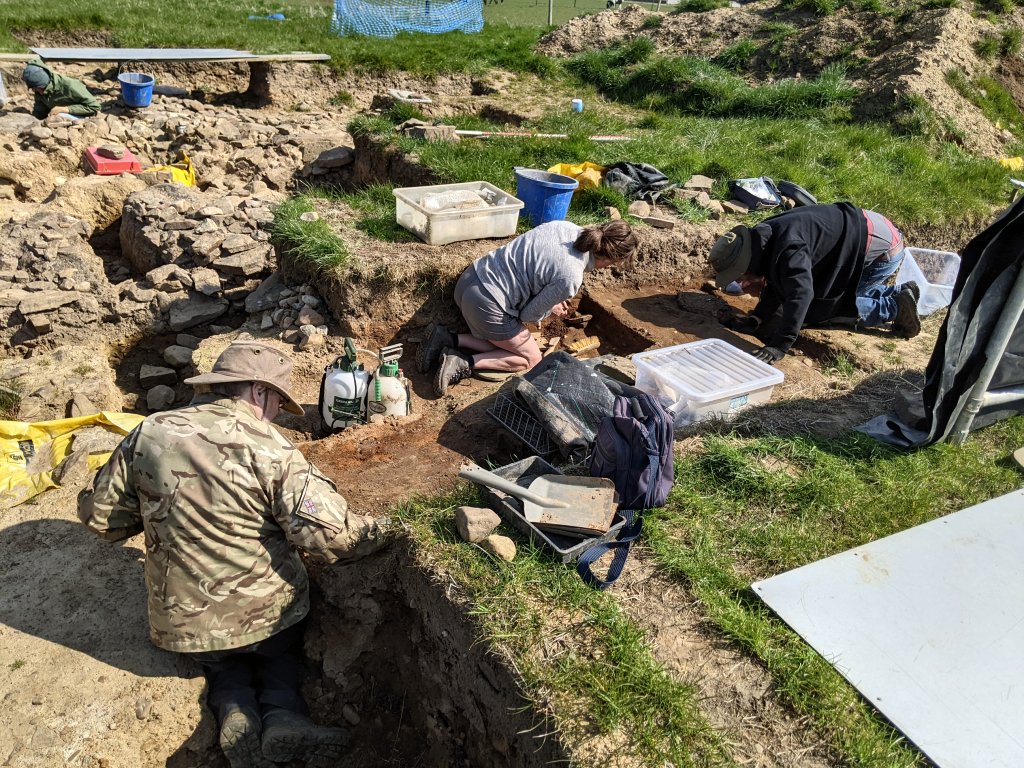 Patrick meanwhile continued his work on the area NW of the clay-lined pit feature (F4) trowelling the mottled clay down to check for any other features. (The clay-lined pit feature was previously know as the octagonal feature but now it seems to have lost its original distinctive shape). Isabel, our new recruit from the Bolton Arch. Soc., worked on the trench area just on the NW side of our first urn. This was to expose the section to see if we could detect the transition from the NE side of the trench (where the stratigraphy was clear) to the SW side where the stratigraphy was less clear.
Patrick meanwhile continued his work on the area NW of the clay-lined pit feature (F4) trowelling the mottled clay down to check for any other features. (The clay-lined pit feature was previously know as the octagonal feature but now it seems to have lost its original distinctive shape). Isabel, our new recruit from the Bolton Arch. Soc., worked on the trench area just on the NW side of our first urn. This was to expose the section to see if we could detect the transition from the NE side of the trench (where the stratigraphy was clear) to the SW side where the stratigraphy was less clear.  This didn’t reveal any change so the next thing would be to re-excavate the section near the octagon feature which Colin had looked at last year.
This didn’t reveal any change so the next thing would be to re-excavate the section near the octagon feature which Colin had looked at last year.
Jen and Andrew continued working on the area between Trench1b on the SW side and Trench3a. Andrew continued removing the rest of the turf and topsoil started by Bill on Tuesday on the baulk between Trenches 3a and 1b, while Jen, after removing the covers, was tasked with removing the stones from the stony layer. The intention is to joining the two test pits (one in Trench 3a dug by Jen and one in Trench 1b dug by John Trippier and Bill at the end of last year). Jen noticed that the pit John and Bill had dug still had dark material in it so continued excavating it. This revealed some stones – she also found stones on the SW side at the bottom embedded in the harder clay.  It seems therefore that we still haven’t found the natural in this trench.
It seems therefore that we still haven’t found the natural in this trench.
Christine started trowelling down the area exposed by Colin on Tuesday between Trenches 3a and 1a/1b. The idea was to expose the mottled layer to check for any more features. A hard patch on the SW side of the baulk gave the impression of a feature (but the wind and sunny conditions was causing the clay to rapidly dry out so it was difficult to be certain). Andrew took over the task when Christine left.
Peter continued to look at the burial feature in Trench 3a on the NE side (F12 – which lay under the two flat stones). Although a lot of cremated bone material had already been remove, the was still quite a lot remaining in situ (including some large pieces) and Chris thought he could detect evidence of a possible retaining bag (it was true that the bone seemed to be concentrated into one small area).  After careful brushing Peter could detect blackened stones seemingly surrounding the bone (Bill had also noticed these when he first came across the feature last year – Day49).
After careful brushing Peter could detect blackened stones seemingly surrounding the bone (Bill had also noticed these when he first came across the feature last year – Day49). 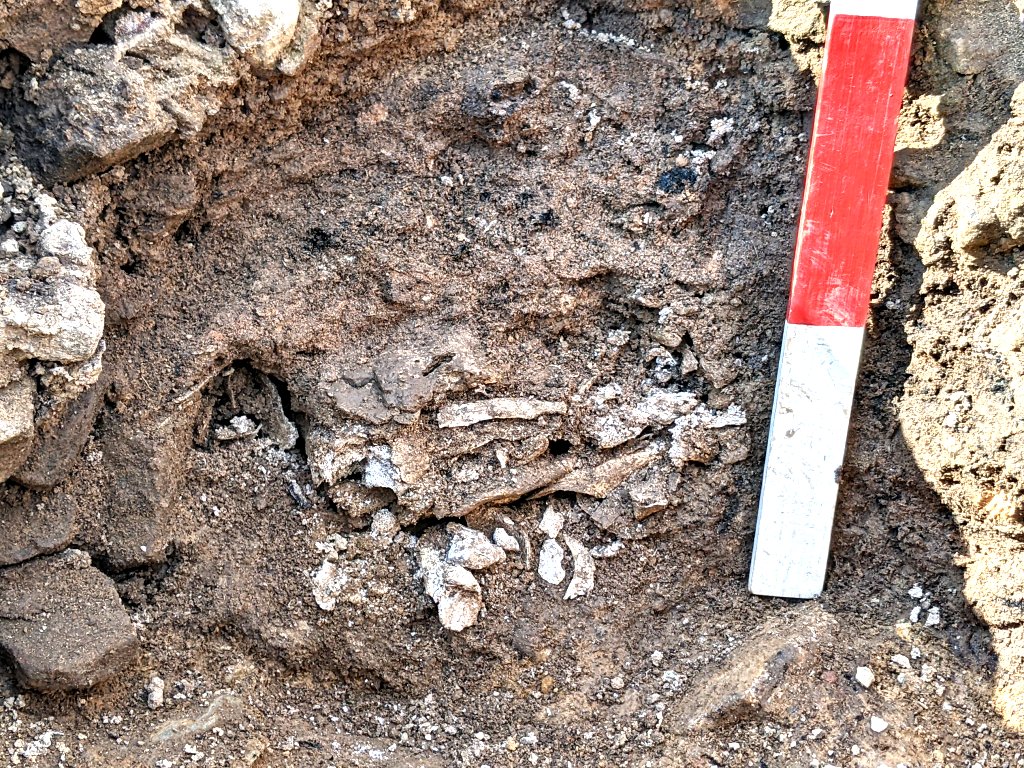 Whether these were the result of burning or some other process was unclear.
Whether these were the result of burning or some other process was unclear.
Ben meanwhile was give the task of removing the last of the baulk between Trench 6 and 6a. He was hampered by a colony of wasps who were nesting in the south wall of the baulk. Bill joined him later partially clearing the base of the trench to expose the bedrock in a hope to help drainage for when it rained again (this trench being the only one susceptible to flooding).
Tuesday 1st April
Day 2
On site today with Bill were Chris Drabble, Colin Russell, Steve Parry and John Needle.
Chris had been able to bring along surplus equipment from the Border Heritage Group who had finished there long running project in Cheshire. This included much needed buckets and a good number of iron spikes which are very handy for securing the fencing around our open trenches. With this in mind Chris, Steve and Colin spend some time fixing the fencing around the trenches.
Meanwhile John set to work on Trench 1 finishing off the work done last week in clearing the collapse. He was joined later by Steve and by the end of the day they had completely cleared the bottom revealing a large area reasonably flat bedrock floor (even showing a small fault running across it). Instead of cutting away the section to produce the usual vertical wall, they left a small batter or slope to help to prevent further collapse.  Last week Bill had noticed a clear layer lying about 30cm above the floor presenting a possible secondary (or tertiary fill). At the interface there appeared to be a rich deposit of charcoal and Bill to the opportunity to take a sample. He also took a sample from a layer slightly higher on the northeast side of the trench. However closer examination of this suggested that it was shale.
Last week Bill had noticed a clear layer lying about 30cm above the floor presenting a possible secondary (or tertiary fill). At the interface there appeared to be a rich deposit of charcoal and Bill to the opportunity to take a sample. He also took a sample from a layer slightly higher on the northeast side of the trench. However closer examination of this suggested that it was shale.
One of the objectives suggested for this year’s programme of work, was to de-turf large areas to check for further burials. This would be just to reveal the mottled clay layer which is where the burial seemed to be showing. With this in mind Colin was set to de-turfing the area between Trench 1a/1b and Trench 3a. It was realise this would destroy our Peg 3 so before he started, Bill replaced it with one of the large iron spikes. Bill also started de-turfing the extended baulk on the far SW side of Trench 3a where there had been a small collapse.
Chris spent some time examining our first urn (F1) which had survived very well over the winter months (in fact all the moss which had gathered on it over the previous had totally disappeared). He took the opportunity to expand the cut on the southwest side to see if he could discover how deep the urn was. This revealed it to be just a few centimetres further down but strangely there appeared to be a stone at its base.  In the side section, he could also see the extent of the charcoal-rich pit which had been cut into the mottled clay layer for the urn had been deposited in (this seemed to present a double layer suggesting a possible recut).
In the side section, he could also see the extent of the charcoal-rich pit which had been cut into the mottled clay layer for the urn had been deposited in (this seemed to present a double layer suggesting a possible recut). 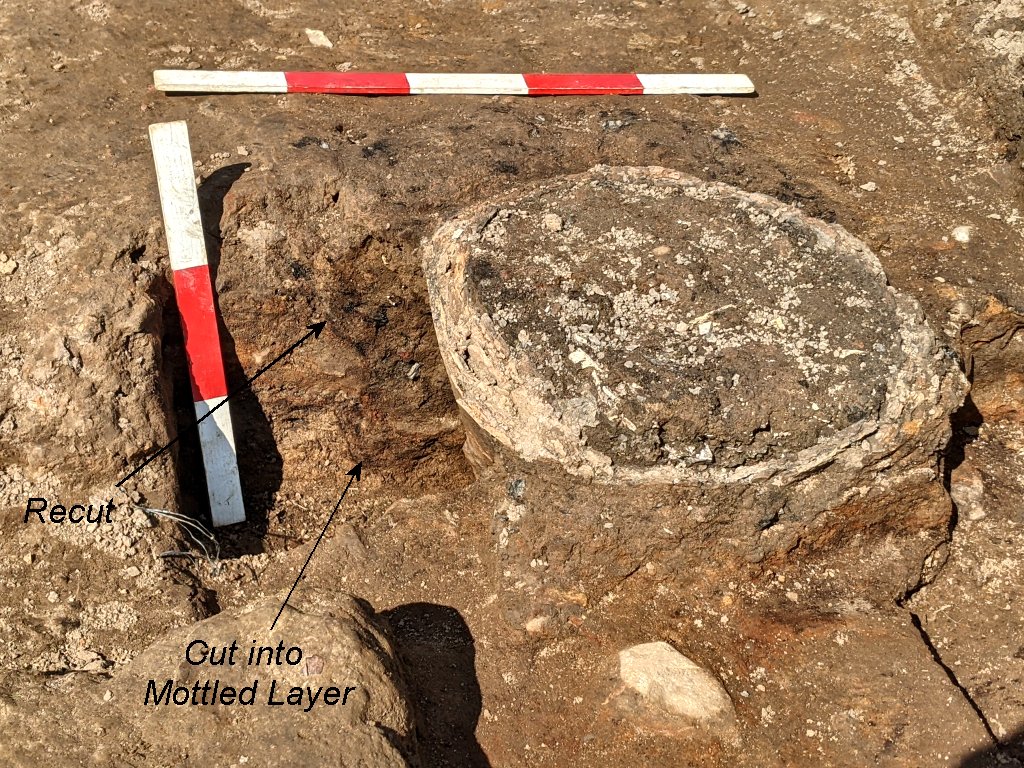 The extent of the pit could also be seen on the surface curving around the northwest side of the urn. Strangely though, this does not continue all the way around. Chris therefore also had a look at the section on the northeast side. This revealed the usual section, recognisable in other areas of the site i.e. the mottle clay layer on top of a thin line of a burnt lying on soft sandy clay (but no sign of the pit).
The extent of the pit could also be seen on the surface curving around the northwest side of the urn. Strangely though, this does not continue all the way around. Chris therefore also had a look at the section on the northeast side. This revealed the usual section, recognisable in other areas of the site i.e. the mottle clay layer on top of a thin line of a burnt lying on soft sandy clay (but no sign of the pit). 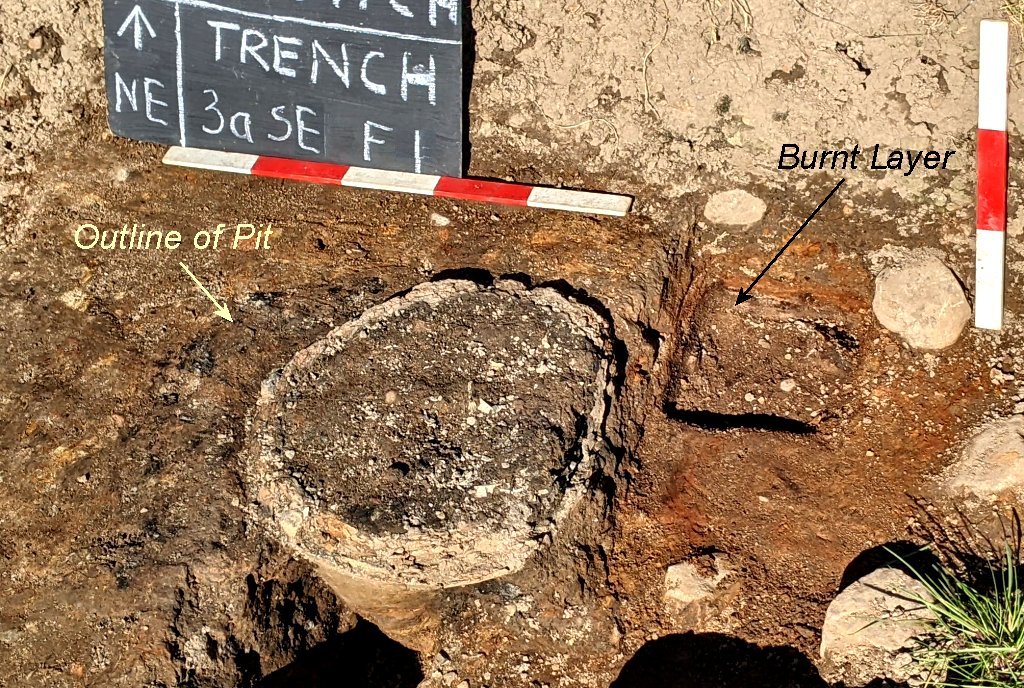 Strange to note that the burning layer has yet to be detected on the southwest side of this area of Trench 3a.
Strange to note that the burning layer has yet to be detected on the southwest side of this area of Trench 3a.
Wednesday 26th March
Day 1
Good weather has meant an early start again this year. Just a small team though to remove the covers and inspect for any damage over the winter months. On site today with Bill were Andrew Wilcock, Peter Cooke, John Needle and Patrick Maloney.
Everything looks fine and we are currently working on a programme of excavations for the coming months. This will include lifting the two urns and removing the rest of the cremated remains that have been discovered so far. These remains will need to be analysed and John Trippier has already been in touch with osteologists who may be able to help with this. It will however be at a cost, and it is likely that we will need external funding for this. Another priority will be investigating what we think is the remains a possible cist burial. It lies under the sandy clay mound and therefore must be the oldest feature so far found. As seen last year, it was shown to have a cavity which, at the time, was immediately covered so that any dating remains would be protected. We also have other areas to look at, especially where there might be more burials and this will need more topsoil removal.
Whilst on site we took the opportunity to clean out Trench 1 which had suffered another collapse (with the number of visitors expected this year we need to make the site as presentable as possible). Clearing the spoil revealed a significant charcoal rich layer which had only been hinted at before. 
This certainly shows a significant secondary filling phase – one associated with a burning event (but much later than the burning event on the central mound).
